Quick filters:
Short robe under Stock Photos and Images
RM2DNT2AK–Bes and Beset, clay, hand modeled, pressed into the form, fired (ceramic), clay, Total: Height: 8.9 cm; Width: 4.1 cm; Depth: 3.4 cm, ceramic, gods (classical. Mythology), Hellenism, Closely embraced are the two Egyptian demons Bes and Beset in their arms. Beset wears a long robe, a cloak and a luxuriant wreath in his hair. Bes also wears such a wreath, but a short robe under a flap armour. Both have shortened limbs and are characterized by grotesquely distorted facial features. Bes sticks out his tongue in the usual iconography, a gesture that is interpreted as defensive against evil.
 Fashionable woman or Merveilleuse at an escritoire, 1801. She wears a crepe hat tied under the chin, a low-cut muslin dress revealing the nipples, laced short sleeves. 18 or 23 August 1801. Chapeau de Crêpe. Robe de Mousseline.Handcoloured copperplate engraving from Pierre de la Mesangeres Journal des Modes et Dames, Paris, 1801. The illustrations in volume 4 were by Carle Vernet, Bosio, Dutailly and Philibert Louis Debucourt. Stock Photohttps://www.alamy.com/image-license-details/?v=1https://www.alamy.com/fashionable-woman-or-merveilleuse-at-an-escritoire-1801-she-wears-a-crepe-hat-tied-under-the-chin-a-low-cut-muslin-dress-revealing-the-nipples-laced-short-sleeves-18-or-23-august-1801-chapeau-de-crpe-robe-de-mousselinehandcoloured-copperplate-engraving-from-pierre-de-la-mesangeres-journal-des-modes-et-dames-paris-1801-the-illustrations-in-volume-4-were-by-carle-vernet-bosio-dutailly-and-philibert-louis-debucourt-image571917244.html
Fashionable woman or Merveilleuse at an escritoire, 1801. She wears a crepe hat tied under the chin, a low-cut muslin dress revealing the nipples, laced short sleeves. 18 or 23 August 1801. Chapeau de Crêpe. Robe de Mousseline.Handcoloured copperplate engraving from Pierre de la Mesangeres Journal des Modes et Dames, Paris, 1801. The illustrations in volume 4 were by Carle Vernet, Bosio, Dutailly and Philibert Louis Debucourt. Stock Photohttps://www.alamy.com/image-license-details/?v=1https://www.alamy.com/fashionable-woman-or-merveilleuse-at-an-escritoire-1801-she-wears-a-crepe-hat-tied-under-the-chin-a-low-cut-muslin-dress-revealing-the-nipples-laced-short-sleeves-18-or-23-august-1801-chapeau-de-crpe-robe-de-mousselinehandcoloured-copperplate-engraving-from-pierre-de-la-mesangeres-journal-des-modes-et-dames-paris-1801-the-illustrations-in-volume-4-were-by-carle-vernet-bosio-dutailly-and-philibert-louis-debucourt-image571917244.htmlRM2T6D27T–Fashionable woman or Merveilleuse at an escritoire, 1801. She wears a crepe hat tied under the chin, a low-cut muslin dress revealing the nipples, laced short sleeves. 18 or 23 August 1801. Chapeau de Crêpe. Robe de Mousseline.Handcoloured copperplate engraving from Pierre de la Mesangeres Journal des Modes et Dames, Paris, 1801. The illustrations in volume 4 were by Carle Vernet, Bosio, Dutailly and Philibert Louis Debucourt.
 Vz: the man wears a robe fastened on his right shoulder, on his head a flat headgear, under the portrait 3 short dashes., Cameo, glass, Color: orange, Shape: oval, Processing: edge at the rear slightly cut back compared to front, 15 x 16 x 4.5 mm Stock Photohttps://www.alamy.com/image-license-details/?v=1https://www.alamy.com/vz-the-man-wears-a-robe-fastened-on-his-right-shoulder-on-his-head-a-flat-headgear-under-the-portrait-3-short-dashes-cameo-glass-color-orange-shape-oval-processing-edge-at-the-rear-slightly-cut-back-compared-to-front-15-x-16-x-45-mm-image344496870.html
Vz: the man wears a robe fastened on his right shoulder, on his head a flat headgear, under the portrait 3 short dashes., Cameo, glass, Color: orange, Shape: oval, Processing: edge at the rear slightly cut back compared to front, 15 x 16 x 4.5 mm Stock Photohttps://www.alamy.com/image-license-details/?v=1https://www.alamy.com/vz-the-man-wears-a-robe-fastened-on-his-right-shoulder-on-his-head-a-flat-headgear-under-the-portrait-3-short-dashes-cameo-glass-color-orange-shape-oval-processing-edge-at-the-rear-slightly-cut-back-compared-to-front-15-x-16-x-45-mm-image344496870.htmlRM2B0D57J–Vz: the man wears a robe fastened on his right shoulder, on his head a flat headgear, under the portrait 3 short dashes., Cameo, glass, Color: orange, Shape: oval, Processing: edge at the rear slightly cut back compared to front, 15 x 16 x 4.5 mm
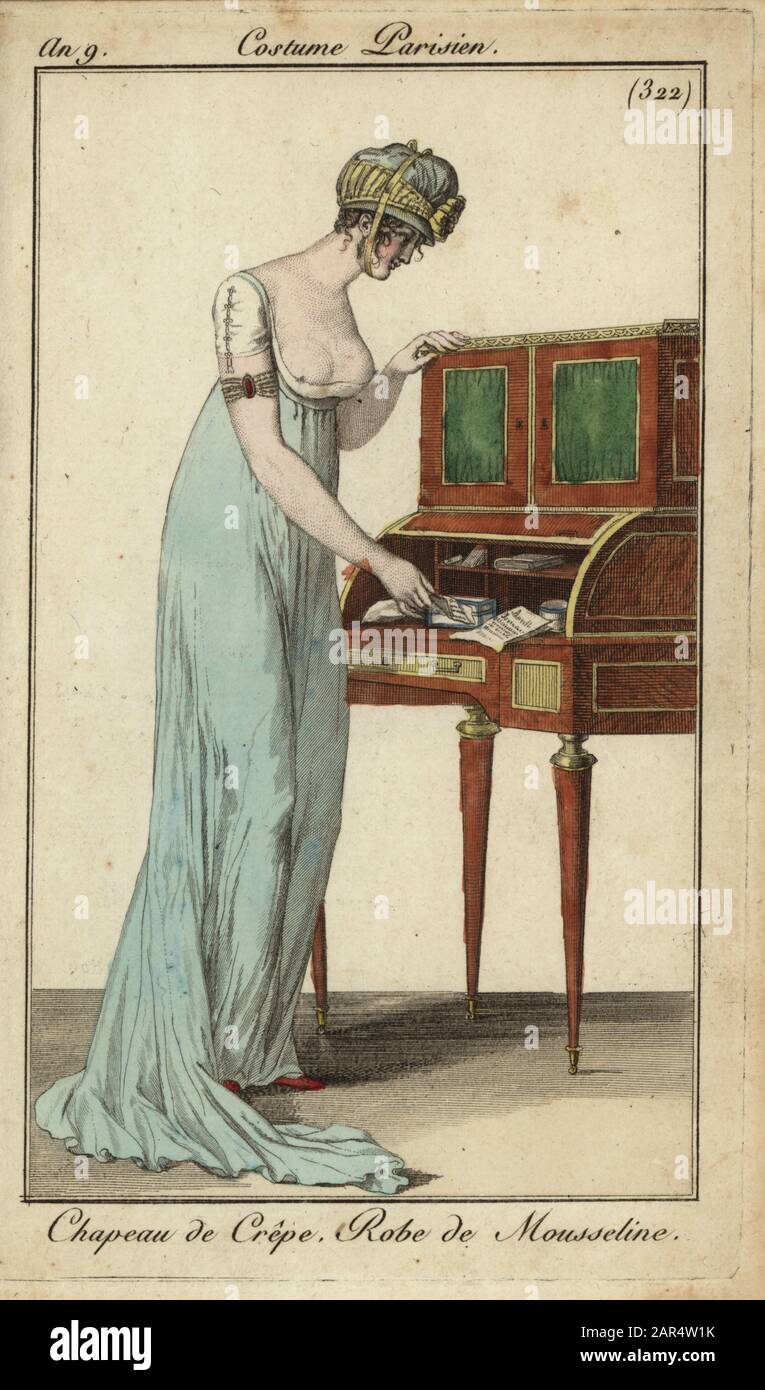 Fashionable woman or Merveilleuse at an escritoire, 1801. She wears a crepe hat tied under the chin, a low-cut muslin dress revealing the nipples, laced short sleeves. 18 or 23 August 1801. Chapeau de Crêpe. Robe de Mousseline.Handcoloured copperplate engraving from Pierre de la Mesangere’s Journal des Modes et Dames, Paris, 1801. The illustrations in volume 4 were by Carle Vernet, Bosio, Dutailly and Philibert Louis Debucourt. Stock Photohttps://www.alamy.com/image-license-details/?v=1https://www.alamy.com/fashionable-woman-or-merveilleuse-at-an-escritoire-1801-she-wears-a-crepe-hat-tied-under-the-chin-a-low-cut-muslin-dress-revealing-the-nipples-laced-short-sleeves-18-or-23-august-1801-chapeau-de-crpe-robe-de-mousselinehandcoloured-copperplate-engraving-from-pierre-de-la-mesangeres-journal-des-modes-et-dames-paris-1801-the-illustrations-in-volume-4-were-by-carle-vernet-bosio-dutailly-and-philibert-louis-debucourt-image341241535.html
Fashionable woman or Merveilleuse at an escritoire, 1801. She wears a crepe hat tied under the chin, a low-cut muslin dress revealing the nipples, laced short sleeves. 18 or 23 August 1801. Chapeau de Crêpe. Robe de Mousseline.Handcoloured copperplate engraving from Pierre de la Mesangere’s Journal des Modes et Dames, Paris, 1801. The illustrations in volume 4 were by Carle Vernet, Bosio, Dutailly and Philibert Louis Debucourt. Stock Photohttps://www.alamy.com/image-license-details/?v=1https://www.alamy.com/fashionable-woman-or-merveilleuse-at-an-escritoire-1801-she-wears-a-crepe-hat-tied-under-the-chin-a-low-cut-muslin-dress-revealing-the-nipples-laced-short-sleeves-18-or-23-august-1801-chapeau-de-crpe-robe-de-mousselinehandcoloured-copperplate-engraving-from-pierre-de-la-mesangeres-journal-des-modes-et-dames-paris-1801-the-illustrations-in-volume-4-were-by-carle-vernet-bosio-dutailly-and-philibert-louis-debucourt-image341241535.htmlRM2AR4W1K–Fashionable woman or Merveilleuse at an escritoire, 1801. She wears a crepe hat tied under the chin, a low-cut muslin dress revealing the nipples, laced short sleeves. 18 or 23 August 1801. Chapeau de Crêpe. Robe de Mousseline.Handcoloured copperplate engraving from Pierre de la Mesangere’s Journal des Modes et Dames, Paris, 1801. The illustrations in volume 4 were by Carle Vernet, Bosio, Dutailly and Philibert Louis Debucourt.
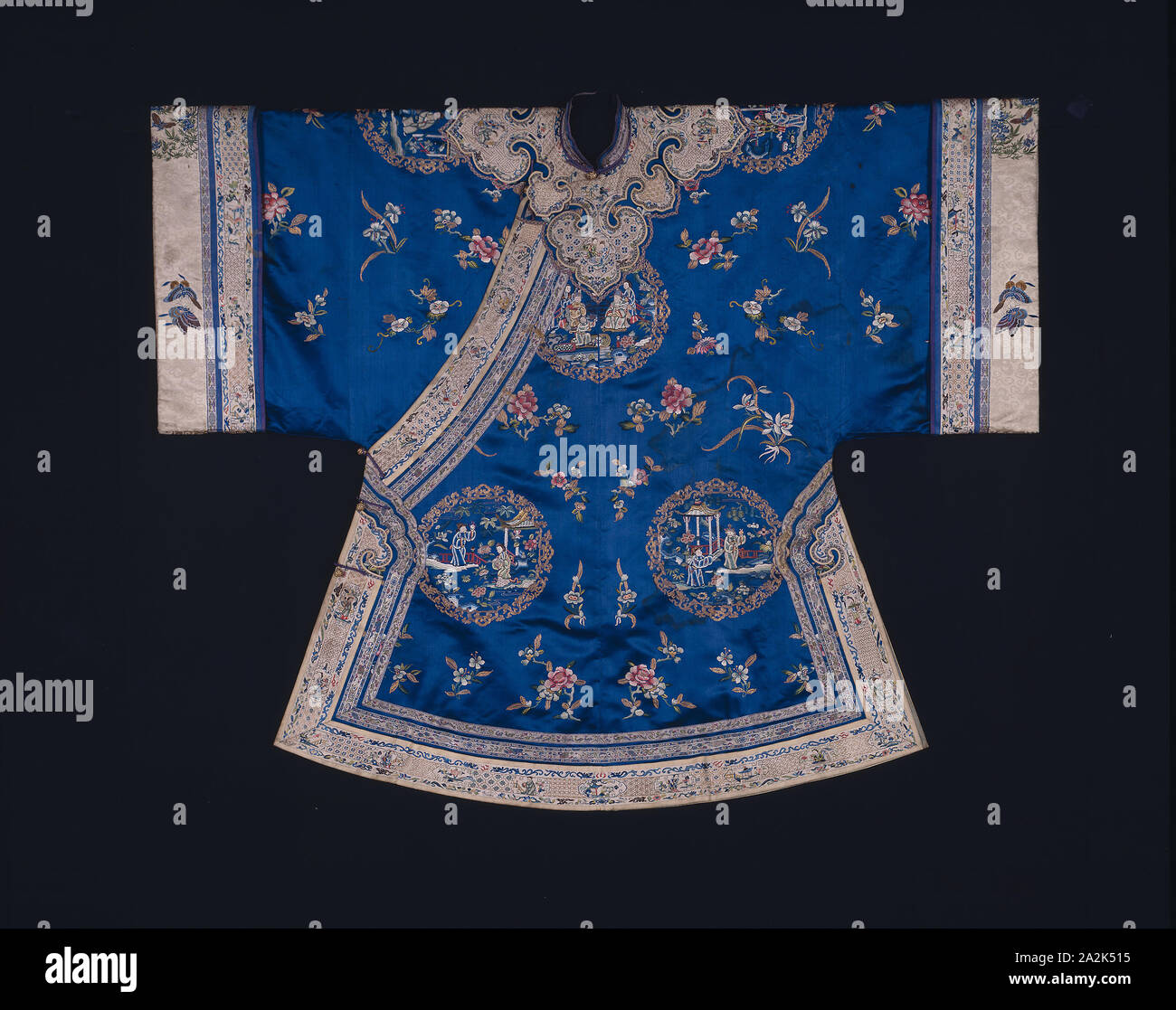 Woman’s Ao (Short Robe), Qing dynasty (1644–1911), 1875/1900, Han-Chinese, China, Silk, warp-float faced 7:1 satin weave, embroidered with silk and gold-leaf-over-lacquered-paper-strip-wrapped silk in knot, satin and stem stitches, laid work and couching, sleeve facing: silk, 7:1 satin damask weave, embroidered with silk and gilt-metal-strip-wrapped silk in knot, satin, single satin, split, and stem stitches (under drawing in black ink or graphite), edging and cloud collar: silk, warp-float faced 7:1 satin weave, embroidered with silk and gold-leaf-over-lacquered-paper-wrapped silk in satin Stock Photohttps://www.alamy.com/image-license-details/?v=1https://www.alamy.com/womans-ao-short-robe-qing-dynasty-16441911-18751900-han-chinese-china-silk-warp-float-faced-71-satin-weave-embroidered-with-silk-and-gold-leaf-over-lacquered-paper-strip-wrapped-silk-in-knot-satin-and-stem-stitches-laid-work-and-couching-sleeve-facing-silk-71-satin-damask-weave-embroidered-with-silk-and-gilt-metal-strip-wrapped-silk-in-knot-satin-single-satin-split-and-stem-stitches-under-drawing-in-black-ink-or-graphite-edging-and-cloud-collar-silk-warp-float-faced-71-satin-weave-embroidered-with-silk-and-gold-leaf-over-lacquered-paper-wrapped-silk-in-satin-image328647345.html
Woman’s Ao (Short Robe), Qing dynasty (1644–1911), 1875/1900, Han-Chinese, China, Silk, warp-float faced 7:1 satin weave, embroidered with silk and gold-leaf-over-lacquered-paper-strip-wrapped silk in knot, satin and stem stitches, laid work and couching, sleeve facing: silk, 7:1 satin damask weave, embroidered with silk and gilt-metal-strip-wrapped silk in knot, satin, single satin, split, and stem stitches (under drawing in black ink or graphite), edging and cloud collar: silk, warp-float faced 7:1 satin weave, embroidered with silk and gold-leaf-over-lacquered-paper-wrapped silk in satin Stock Photohttps://www.alamy.com/image-license-details/?v=1https://www.alamy.com/womans-ao-short-robe-qing-dynasty-16441911-18751900-han-chinese-china-silk-warp-float-faced-71-satin-weave-embroidered-with-silk-and-gold-leaf-over-lacquered-paper-strip-wrapped-silk-in-knot-satin-and-stem-stitches-laid-work-and-couching-sleeve-facing-silk-71-satin-damask-weave-embroidered-with-silk-and-gilt-metal-strip-wrapped-silk-in-knot-satin-single-satin-split-and-stem-stitches-under-drawing-in-black-ink-or-graphite-edging-and-cloud-collar-silk-warp-float-faced-71-satin-weave-embroidered-with-silk-and-gold-leaf-over-lacquered-paper-wrapped-silk-in-satin-image328647345.htmlRM2A2K515–Woman’s Ao (Short Robe), Qing dynasty (1644–1911), 1875/1900, Han-Chinese, China, Silk, warp-float faced 7:1 satin weave, embroidered with silk and gold-leaf-over-lacquered-paper-strip-wrapped silk in knot, satin and stem stitches, laid work and couching, sleeve facing: silk, 7:1 satin damask weave, embroidered with silk and gilt-metal-strip-wrapped silk in knot, satin, single satin, split, and stem stitches (under drawing in black ink or graphite), edging and cloud collar: silk, warp-float faced 7:1 satin weave, embroidered with silk and gold-leaf-over-lacquered-paper-wrapped silk in satin
 Female short blonde wet hair wearing long blue robe, looking down, standing in field on grass fields and trees in background Stock Photohttps://www.alamy.com/image-license-details/?v=1https://www.alamy.com/stock-photo-female-short-blonde-wet-hair-wearing-long-blue-robe-looking-down-standing-43495868.html
Female short blonde wet hair wearing long blue robe, looking down, standing in field on grass fields and trees in background Stock Photohttps://www.alamy.com/image-license-details/?v=1https://www.alamy.com/stock-photo-female-short-blonde-wet-hair-wearing-long-blue-robe-looking-down-standing-43495868.htmlRMCENBBT–Female short blonde wet hair wearing long blue robe, looking down, standing in field on grass fields and trees in background
 Vz: a rider sits on a small horse and has a crown with five points (rays) on his head, he wears a short cloak that flares out from his shoulders, he kills a lion with a spear he has in his left hand holds, the lion is engraved under the forelegs of the horse, partly under the lion and partly under the horse lies a man, it is not clear whether the horseman or the lion killed this man, in the field an inscription., Kz : a small figure in a long robe with a diadem in the hair and the right hand raised to the mouth (compare Maaskant-Kleibrink, M., Catalog of the engraved gems at the Royal Coin Stock Photohttps://www.alamy.com/image-license-details/?v=1https://www.alamy.com/vz-a-rider-sits-on-a-small-horse-and-has-a-crown-with-five-points-rays-on-his-head-he-wears-a-short-cloak-that-flares-out-from-his-shoulders-he-kills-a-lion-with-a-spear-he-has-in-his-left-hand-holds-the-lion-is-engraved-under-the-forelegs-of-the-horse-partly-under-the-lion-and-partly-under-the-horse-lies-a-man-it-is-not-clear-whether-the-horseman-or-the-lion-killed-this-man-in-the-field-an-inscription-kz-a-small-figure-in-a-long-robe-with-a-diadem-in-the-hair-and-the-right-hand-raised-to-the-mouth-compare-maaskant-kleibrink-m-catalog-of-the-engraved-gems-at-the-royal-coin-image344492547.html
Vz: a rider sits on a small horse and has a crown with five points (rays) on his head, he wears a short cloak that flares out from his shoulders, he kills a lion with a spear he has in his left hand holds, the lion is engraved under the forelegs of the horse, partly under the lion and partly under the horse lies a man, it is not clear whether the horseman or the lion killed this man, in the field an inscription., Kz : a small figure in a long robe with a diadem in the hair and the right hand raised to the mouth (compare Maaskant-Kleibrink, M., Catalog of the engraved gems at the Royal Coin Stock Photohttps://www.alamy.com/image-license-details/?v=1https://www.alamy.com/vz-a-rider-sits-on-a-small-horse-and-has-a-crown-with-five-points-rays-on-his-head-he-wears-a-short-cloak-that-flares-out-from-his-shoulders-he-kills-a-lion-with-a-spear-he-has-in-his-left-hand-holds-the-lion-is-engraved-under-the-forelegs-of-the-horse-partly-under-the-lion-and-partly-under-the-horse-lies-a-man-it-is-not-clear-whether-the-horseman-or-the-lion-killed-this-man-in-the-field-an-inscription-kz-a-small-figure-in-a-long-robe-with-a-diadem-in-the-hair-and-the-right-hand-raised-to-the-mouth-compare-maaskant-kleibrink-m-catalog-of-the-engraved-gems-at-the-royal-coin-image344492547.htmlRM2B0CYN7–Vz: a rider sits on a small horse and has a crown with five points (rays) on his head, he wears a short cloak that flares out from his shoulders, he kills a lion with a spear he has in his left hand holds, the lion is engraved under the forelegs of the horse, partly under the lion and partly under the horse lies a man, it is not clear whether the horseman or the lion killed this man, in the field an inscription., Kz : a small figure in a long robe with a diadem in the hair and the right hand raised to the mouth (compare Maaskant-Kleibrink, M., Catalog of the engraved gems at the Royal Coin
 Brunette female with short wet hair wearing a white towelling robe and lying on side, looking to camera unsmiling Stock Photohttps://www.alamy.com/image-license-details/?v=1https://www.alamy.com/stock-photo-brunette-female-with-short-wet-hair-wearing-a-white-towelling-robe-43687572.html
Brunette female with short wet hair wearing a white towelling robe and lying on side, looking to camera unsmiling Stock Photohttps://www.alamy.com/image-license-details/?v=1https://www.alamy.com/stock-photo-brunette-female-with-short-wet-hair-wearing-a-white-towelling-robe-43687572.htmlRMCF23XC–Brunette female with short wet hair wearing a white towelling robe and lying on side, looking to camera unsmiling
 Catherine of Alexandria, The saint stands on a versatile plinth with the right leg bent over Maxentius. She is staring straight ahead, holding a book on the left and in the right the lost attribute, the sword. A wound pearl band rests on the hair, which falls down in long wavy spots, each ending in a curl. Over a thin undergarment with front and long wide, flared sleeves a robe with short sleeves, with frills, and a round, embroidered neck, it is inserted under the left arm, so that the right shoe point is released. The cloak, with a slip hanging over the left arm, is held together by a double Stock Photohttps://www.alamy.com/image-license-details/?v=1https://www.alamy.com/catherine-of-alexandria-the-saint-stands-on-a-versatile-plinth-with-the-right-leg-bent-over-maxentius-she-is-staring-straight-ahead-holding-a-book-on-the-left-and-in-the-right-the-lost-attribute-the-sword-a-wound-pearl-band-rests-on-the-hair-which-falls-down-in-long-wavy-spots-each-ending-in-a-curl-over-a-thin-undergarment-with-front-and-long-wide-flared-sleeves-a-robe-with-short-sleeves-with-frills-and-a-round-embroidered-neck-it-is-inserted-under-the-left-arm-so-that-the-right-shoe-point-is-released-the-cloak-with-a-slip-hanging-over-the-left-arm-is-held-together-by-a-double-image261359151.html
Catherine of Alexandria, The saint stands on a versatile plinth with the right leg bent over Maxentius. She is staring straight ahead, holding a book on the left and in the right the lost attribute, the sword. A wound pearl band rests on the hair, which falls down in long wavy spots, each ending in a curl. Over a thin undergarment with front and long wide, flared sleeves a robe with short sleeves, with frills, and a round, embroidered neck, it is inserted under the left arm, so that the right shoe point is released. The cloak, with a slip hanging over the left arm, is held together by a double Stock Photohttps://www.alamy.com/image-license-details/?v=1https://www.alamy.com/catherine-of-alexandria-the-saint-stands-on-a-versatile-plinth-with-the-right-leg-bent-over-maxentius-she-is-staring-straight-ahead-holding-a-book-on-the-left-and-in-the-right-the-lost-attribute-the-sword-a-wound-pearl-band-rests-on-the-hair-which-falls-down-in-long-wavy-spots-each-ending-in-a-curl-over-a-thin-undergarment-with-front-and-long-wide-flared-sleeves-a-robe-with-short-sleeves-with-frills-and-a-round-embroidered-neck-it-is-inserted-under-the-left-arm-so-that-the-right-shoe-point-is-released-the-cloak-with-a-slip-hanging-over-the-left-arm-is-held-together-by-a-double-image261359151.htmlRMW55X7B–Catherine of Alexandria, The saint stands on a versatile plinth with the right leg bent over Maxentius. She is staring straight ahead, holding a book on the left and in the right the lost attribute, the sword. A wound pearl band rests on the hair, which falls down in long wavy spots, each ending in a curl. Over a thin undergarment with front and long wide, flared sleeves a robe with short sleeves, with frills, and a round, embroidered neck, it is inserted under the left arm, so that the right shoe point is released. The cloak, with a slip hanging over the left arm, is held together by a double
 Cropped image of brunette female short hair swept back, wearing a blue and white towelling robe and drinking from a glass of Stock Photohttps://www.alamy.com/image-license-details/?v=1https://www.alamy.com/stock-photo-cropped-image-of-brunette-female-short-hair-swept-back-wearing-a-blue-43541488.html
Cropped image of brunette female short hair swept back, wearing a blue and white towelling robe and drinking from a glass of Stock Photohttps://www.alamy.com/image-license-details/?v=1https://www.alamy.com/stock-photo-cropped-image-of-brunette-female-short-hair-swept-back-wearing-a-blue-43541488.htmlRMCERDH4–Cropped image of brunette female short hair swept back, wearing a blue and white towelling robe and drinking from a glass of
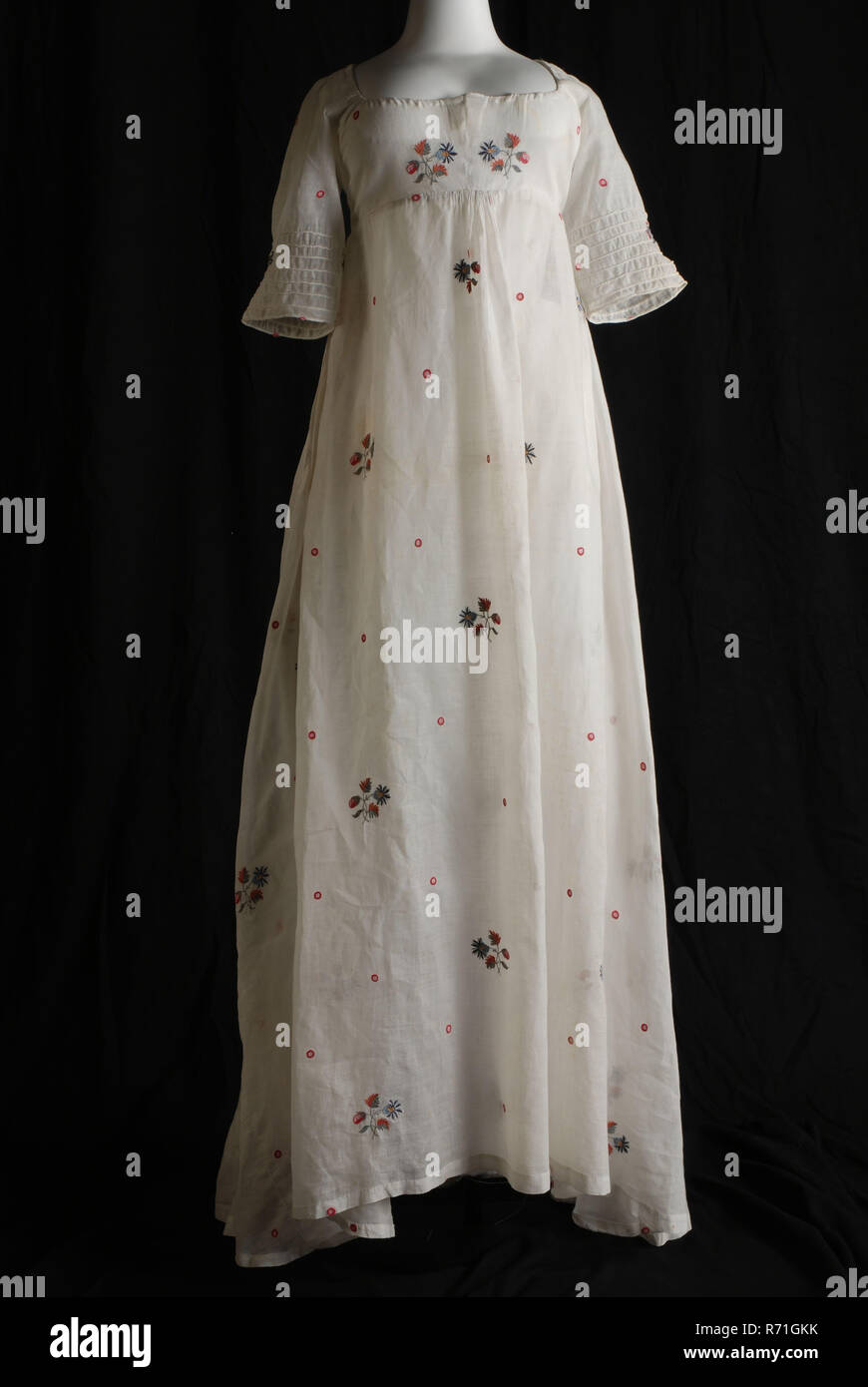 Empire dress of white batiste embroidered with multicolored flower motifs in tambouring, raised waist, short sleeves and wide round neckline, lacing mid back, short trail, robe frock outerwear women's clothing clothes cotton silk metal mid back, shoulder w 25.0 skirt, under w 150.0 sleeve, textile embroidery tambourer work woman Empire Stock Photohttps://www.alamy.com/image-license-details/?v=1https://www.alamy.com/empire-dress-of-white-batiste-embroidered-with-multicolored-flower-motifs-in-tambouring-raised-waist-short-sleeves-and-wide-round-neckline-lacing-mid-back-short-trail-robe-frock-outerwear-womens-clothing-clothes-cotton-silk-metal-mid-back-shoulder-w-250-skirt-under-w-1500-sleeve-textile-embroidery-tambourer-work-woman-empire-image228072423.html
Empire dress of white batiste embroidered with multicolored flower motifs in tambouring, raised waist, short sleeves and wide round neckline, lacing mid back, short trail, robe frock outerwear women's clothing clothes cotton silk metal mid back, shoulder w 25.0 skirt, under w 150.0 sleeve, textile embroidery tambourer work woman Empire Stock Photohttps://www.alamy.com/image-license-details/?v=1https://www.alamy.com/empire-dress-of-white-batiste-embroidered-with-multicolored-flower-motifs-in-tambouring-raised-waist-short-sleeves-and-wide-round-neckline-lacing-mid-back-short-trail-robe-frock-outerwear-womens-clothing-clothes-cotton-silk-metal-mid-back-shoulder-w-250-skirt-under-w-1500-sleeve-textile-embroidery-tambourer-work-woman-empire-image228072423.htmlRMR71GKK–Empire dress of white batiste embroidered with multicolored flower motifs in tambouring, raised waist, short sleeves and wide round neckline, lacing mid back, short trail, robe frock outerwear women's clothing clothes cotton silk metal mid back, shoulder w 25.0 skirt, under w 150.0 sleeve, textile embroidery tambourer work woman Empire
 Paris fashions for June, 1869. 'Fig. 1. Costume Lavallière, in pale almond-coloured mohair, with the short under jupe trimmed with a plaited flounce of rich brown silk...The second jupe, which has a bouffant, is bordered by a narrow flounce...and over this falls a third short skirt, festooned at the sides, where hang small pointed basques, terminating the tight casaque, which is ornamented behind with a bow...The bonnet, of black lace, has a high fronton...Fig. 2. Morning robe, of white and blue striped silk, the bottom of the skirt...bordered with lilac satin. The form of the jacket...wi Stock Photohttps://www.alamy.com/image-license-details/?v=1https://www.alamy.com/paris-fashions-for-june-1869-fig-1-costume-lavallixe8re-in-pale-almond-coloured-mohair-with-the-short-under-jupe-trimmed-with-a-plaited-flounce-of-rich-brown-silkthe-second-jupe-which-has-a-bouffant-is-bordered-by-a-narrow-flounceand-over-this-falls-a-third-short-skirt-festooned-at-the-sides-where-hang-small-pointed-basques-terminating-the-tight-casaque-which-is-ornamented-behind-with-a-bowthe-bonnet-of-black-lace-has-a-high-frontonfig-2-morning-robe-of-white-and-blue-striped-silk-the-bottom-of-the-skirtbordered-with-lilac-satin-the-form-of-the-jacketwi-image608997534.html
Paris fashions for June, 1869. 'Fig. 1. Costume Lavallière, in pale almond-coloured mohair, with the short under jupe trimmed with a plaited flounce of rich brown silk...The second jupe, which has a bouffant, is bordered by a narrow flounce...and over this falls a third short skirt, festooned at the sides, where hang small pointed basques, terminating the tight casaque, which is ornamented behind with a bow...The bonnet, of black lace, has a high fronton...Fig. 2. Morning robe, of white and blue striped silk, the bottom of the skirt...bordered with lilac satin. The form of the jacket...wi Stock Photohttps://www.alamy.com/image-license-details/?v=1https://www.alamy.com/paris-fashions-for-june-1869-fig-1-costume-lavallixe8re-in-pale-almond-coloured-mohair-with-the-short-under-jupe-trimmed-with-a-plaited-flounce-of-rich-brown-silkthe-second-jupe-which-has-a-bouffant-is-bordered-by-a-narrow-flounceand-over-this-falls-a-third-short-skirt-festooned-at-the-sides-where-hang-small-pointed-basques-terminating-the-tight-casaque-which-is-ornamented-behind-with-a-bowthe-bonnet-of-black-lace-has-a-high-frontonfig-2-morning-robe-of-white-and-blue-striped-silk-the-bottom-of-the-skirtbordered-with-lilac-satin-the-form-of-the-jacketwi-image608997534.htmlRM2XAP6FX–Paris fashions for June, 1869. 'Fig. 1. Costume Lavallière, in pale almond-coloured mohair, with the short under jupe trimmed with a plaited flounce of rich brown silk...The second jupe, which has a bouffant, is bordered by a narrow flounce...and over this falls a third short skirt, festooned at the sides, where hang small pointed basques, terminating the tight casaque, which is ornamented behind with a bow...The bonnet, of black lace, has a high fronton...Fig. 2. Morning robe, of white and blue striped silk, the bottom of the skirt...bordered with lilac satin. The form of the jacket...wi
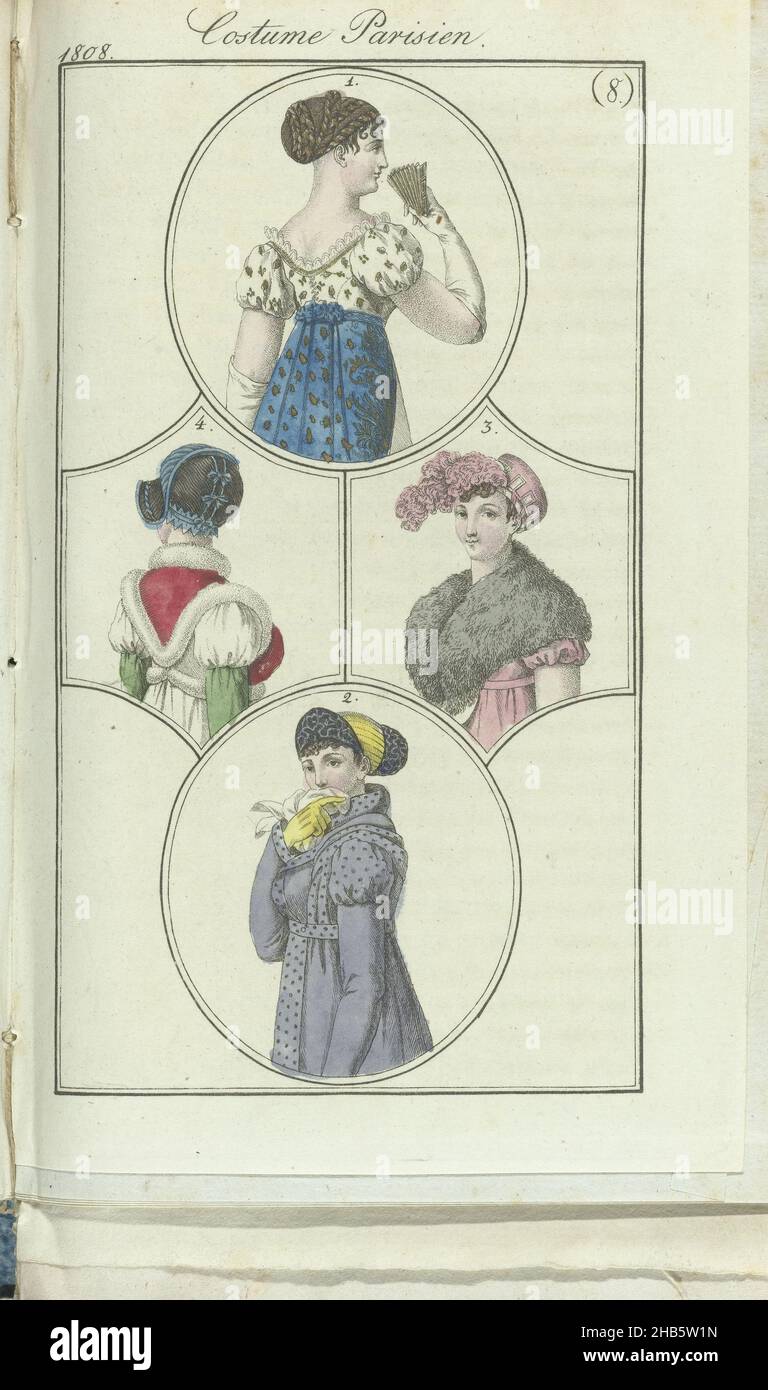 Journal des Dames et des Modes, Frankfurt edition 22 Février 1808, Costume Parisien (8), The accompanying text (pp. 212 and 213) states: Fig. 1: Coiffure de grande parure: gauze of gold thread, braided with hair. Short gown of white satin, embroidered with gold. Blue, embroidered manteau, with long queue. Fig. 2: Coiffure of black velvet and yellow satin. Robe Levantine garnished with 'pluche tigrée'. (Under this gown one wears a white jupon...). Fig. 3: Toque of pink crepe with a long feather at the front. Gown of pink taffeta with short sleeves. Fichu of fox fur. Fig. 4: Capote of satin and Stock Photohttps://www.alamy.com/image-license-details/?v=1https://www.alamy.com/journal-des-dames-et-des-modes-frankfurt-edition-22-fvrier-1808-costume-parisien-8-the-accompanying-text-pp-212-and-213-states-fig-1-coiffure-de-grande-parure-gauze-of-gold-thread-braided-with-hair-short-gown-of-white-satin-embroidered-with-gold-blue-embroidered-manteau-with-long-queue-fig-2-coiffure-of-black-velvet-and-yellow-satin-robe-levantine-garnished-with-pluche-tigre-under-this-gown-one-wears-a-white-jupon-fig-3-toque-of-pink-crepe-with-a-long-feather-at-the-front-gown-of-pink-taffeta-with-short-sleeves-fichu-of-fox-fur-fig-4-capote-of-satin-and-image454360193.html
Journal des Dames et des Modes, Frankfurt edition 22 Février 1808, Costume Parisien (8), The accompanying text (pp. 212 and 213) states: Fig. 1: Coiffure de grande parure: gauze of gold thread, braided with hair. Short gown of white satin, embroidered with gold. Blue, embroidered manteau, with long queue. Fig. 2: Coiffure of black velvet and yellow satin. Robe Levantine garnished with 'pluche tigrée'. (Under this gown one wears a white jupon...). Fig. 3: Toque of pink crepe with a long feather at the front. Gown of pink taffeta with short sleeves. Fichu of fox fur. Fig. 4: Capote of satin and Stock Photohttps://www.alamy.com/image-license-details/?v=1https://www.alamy.com/journal-des-dames-et-des-modes-frankfurt-edition-22-fvrier-1808-costume-parisien-8-the-accompanying-text-pp-212-and-213-states-fig-1-coiffure-de-grande-parure-gauze-of-gold-thread-braided-with-hair-short-gown-of-white-satin-embroidered-with-gold-blue-embroidered-manteau-with-long-queue-fig-2-coiffure-of-black-velvet-and-yellow-satin-robe-levantine-garnished-with-pluche-tigre-under-this-gown-one-wears-a-white-jupon-fig-3-toque-of-pink-crepe-with-a-long-feather-at-the-front-gown-of-pink-taffeta-with-short-sleeves-fichu-of-fox-fur-fig-4-capote-of-satin-and-image454360193.htmlRM2HB5W1N–Journal des Dames et des Modes, Frankfurt edition 22 Février 1808, Costume Parisien (8), The accompanying text (pp. 212 and 213) states: Fig. 1: Coiffure de grande parure: gauze of gold thread, braided with hair. Short gown of white satin, embroidered with gold. Blue, embroidered manteau, with long queue. Fig. 2: Coiffure of black velvet and yellow satin. Robe Levantine garnished with 'pluche tigrée'. (Under this gown one wears a white jupon...). Fig. 3: Toque of pink crepe with a long feather at the front. Gown of pink taffeta with short sleeves. Fichu of fox fur. Fig. 4: Capote of satin and
 Han-Chinese. Woman's Ao (Short Robe). 1875–1900. China. Silk, warp-float faced 7 1 satin weave; embroidered with silk and gold-leaf-over-lacquered-paper-strip-wrapped silk in knot, satin and stem stitches; laid work and couching; sleeve facing silk, 7 1 satin damask weave; embroidered with silk and gilt-metal-strip-wrapped silk in knot, satin, single satin, split, and stem stitches (under drawing in black ink or graphite); edging and cloud collar silk, warp-float faced 7 1 satin weave; embroidered with silk and gold-leaf-over-lacquered-paper-wrapped silk in satin and stem stitches; laid work a Stock Photohttps://www.alamy.com/image-license-details/?v=1https://www.alamy.com/han-chinese-womans-ao-short-robe-18751900-china-silk-warp-float-faced-7-1-satin-weave-embroidered-with-silk-and-gold-leaf-over-lacquered-paper-strip-wrapped-silk-in-knot-satin-and-stem-stitches-laid-work-and-couching-sleeve-facing-silk-7-1-satin-damask-weave-embroidered-with-silk-and-gilt-metal-strip-wrapped-silk-in-knot-satin-single-satin-split-and-stem-stitches-under-drawing-in-black-ink-or-graphite-edging-and-cloud-collar-silk-warp-float-faced-7-1-satin-weave-embroidered-with-silk-and-gold-leaf-over-lacquered-paper-wrapped-silk-in-satin-and-stem-stitches-laid-work-a-image337973775.html
Han-Chinese. Woman's Ao (Short Robe). 1875–1900. China. Silk, warp-float faced 7 1 satin weave; embroidered with silk and gold-leaf-over-lacquered-paper-strip-wrapped silk in knot, satin and stem stitches; laid work and couching; sleeve facing silk, 7 1 satin damask weave; embroidered with silk and gilt-metal-strip-wrapped silk in knot, satin, single satin, split, and stem stitches (under drawing in black ink or graphite); edging and cloud collar silk, warp-float faced 7 1 satin weave; embroidered with silk and gold-leaf-over-lacquered-paper-wrapped silk in satin and stem stitches; laid work a Stock Photohttps://www.alamy.com/image-license-details/?v=1https://www.alamy.com/han-chinese-womans-ao-short-robe-18751900-china-silk-warp-float-faced-7-1-satin-weave-embroidered-with-silk-and-gold-leaf-over-lacquered-paper-strip-wrapped-silk-in-knot-satin-and-stem-stitches-laid-work-and-couching-sleeve-facing-silk-7-1-satin-damask-weave-embroidered-with-silk-and-gilt-metal-strip-wrapped-silk-in-knot-satin-single-satin-split-and-stem-stitches-under-drawing-in-black-ink-or-graphite-edging-and-cloud-collar-silk-warp-float-faced-7-1-satin-weave-embroidered-with-silk-and-gold-leaf-over-lacquered-paper-wrapped-silk-in-satin-and-stem-stitches-laid-work-a-image337973775.htmlRM2AHT0YY–Han-Chinese. Woman's Ao (Short Robe). 1875–1900. China. Silk, warp-float faced 7 1 satin weave; embroidered with silk and gold-leaf-over-lacquered-paper-strip-wrapped silk in knot, satin and stem stitches; laid work and couching; sleeve facing silk, 7 1 satin damask weave; embroidered with silk and gilt-metal-strip-wrapped silk in knot, satin, single satin, split, and stem stitches (under drawing in black ink or graphite); edging and cloud collar silk, warp-float faced 7 1 satin weave; embroidered with silk and gold-leaf-over-lacquered-paper-wrapped silk in satin and stem stitches; laid work a
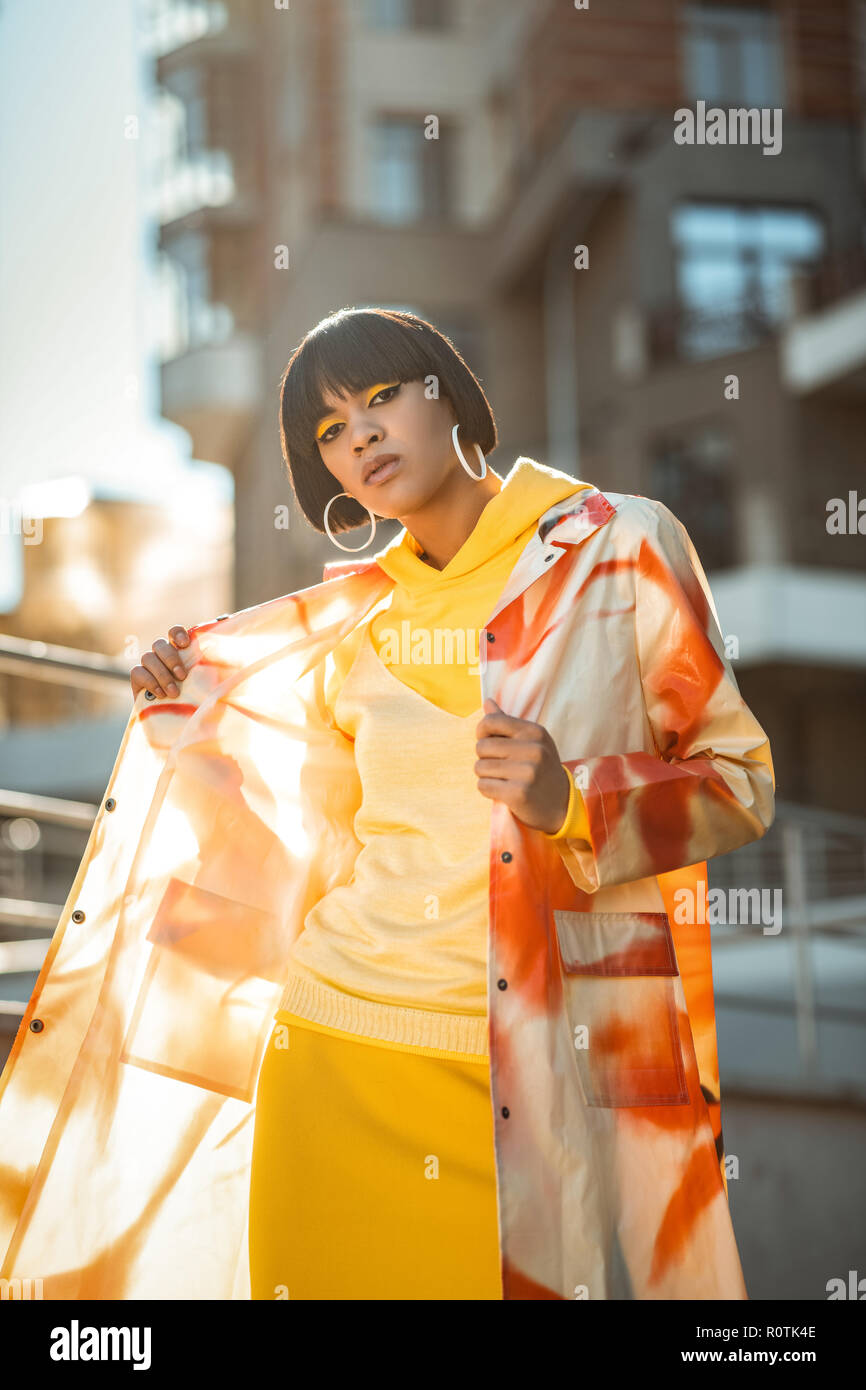 Short-haired extraordinary woman under covering her robe Stock Photohttps://www.alamy.com/image-license-details/?v=1https://www.alamy.com/short-haired-extraordinary-woman-under-covering-her-robe-image224276654.html
Short-haired extraordinary woman under covering her robe Stock Photohttps://www.alamy.com/image-license-details/?v=1https://www.alamy.com/short-haired-extraordinary-woman-under-covering-her-robe-image224276654.htmlRFR0TK4E–Short-haired extraordinary woman under covering her robe
 Journal of the ladies and fashions, editis Frankfurt February 22, 1808, Parisian costume (8), 1808 The accompanying text (p. 212 and 213) mentions: Fig. 1: Coiffure De Grande Parure: Gaas of gold thread, braided with her. Short dress of white satin, embroidered with gold. Blue, embroidered manteau, with long queue. Fig. 2: Coiffure of black velvet and yellow satin. Robe Levantine garnished with 'plush tigrée'. (A white Jupon is wearing under this dress ...). Fig. 3: Toque of pink crepe with a long spring on the front. Dress of pink taf side with short sleeves. Fichu van Vossebont. Fig. 4: Capo Stock Photohttps://www.alamy.com/image-license-details/?v=1https://www.alamy.com/journal-of-the-ladies-and-fashions-editis-frankfurt-february-22-1808-parisian-costume-8-1808-the-accompanying-text-p-212-and-213-mentions-fig-1-coiffure-de-grande-parure-gaas-of-gold-thread-braided-with-her-short-dress-of-white-satin-embroidered-with-gold-blue-embroidered-manteau-with-long-queue-fig-2-coiffure-of-black-velvet-and-yellow-satin-robe-levantine-garnished-with-plush-tigre-a-white-jupon-is-wearing-under-this-dress-fig-3-toque-of-pink-crepe-with-a-long-spring-on-the-front-dress-of-pink-taf-side-with-short-sleeves-fichu-van-vossebont-fig-4-capo-image576583988.html
Journal of the ladies and fashions, editis Frankfurt February 22, 1808, Parisian costume (8), 1808 The accompanying text (p. 212 and 213) mentions: Fig. 1: Coiffure De Grande Parure: Gaas of gold thread, braided with her. Short dress of white satin, embroidered with gold. Blue, embroidered manteau, with long queue. Fig. 2: Coiffure of black velvet and yellow satin. Robe Levantine garnished with 'plush tigrée'. (A white Jupon is wearing under this dress ...). Fig. 3: Toque of pink crepe with a long spring on the front. Dress of pink taf side with short sleeves. Fichu van Vossebont. Fig. 4: Capo Stock Photohttps://www.alamy.com/image-license-details/?v=1https://www.alamy.com/journal-of-the-ladies-and-fashions-editis-frankfurt-february-22-1808-parisian-costume-8-1808-the-accompanying-text-p-212-and-213-mentions-fig-1-coiffure-de-grande-parure-gaas-of-gold-thread-braided-with-her-short-dress-of-white-satin-embroidered-with-gold-blue-embroidered-manteau-with-long-queue-fig-2-coiffure-of-black-velvet-and-yellow-satin-robe-levantine-garnished-with-plush-tigre-a-white-jupon-is-wearing-under-this-dress-fig-3-toque-of-pink-crepe-with-a-long-spring-on-the-front-dress-of-pink-taf-side-with-short-sleeves-fichu-van-vossebont-fig-4-capo-image576583988.htmlRM2TE1JN8–Journal of the ladies and fashions, editis Frankfurt February 22, 1808, Parisian costume (8), 1808 The accompanying text (p. 212 and 213) mentions: Fig. 1: Coiffure De Grande Parure: Gaas of gold thread, braided with her. Short dress of white satin, embroidered with gold. Blue, embroidered manteau, with long queue. Fig. 2: Coiffure of black velvet and yellow satin. Robe Levantine garnished with 'plush tigrée'. (A white Jupon is wearing under this dress ...). Fig. 3: Toque of pink crepe with a long spring on the front. Dress of pink taf side with short sleeves. Fichu van Vossebont. Fig. 4: Capo
 Woman's Ao (Short Robe), China, Qing dynasty (1644-1911), 1875/1900. Stock Photohttps://www.alamy.com/image-license-details/?v=1https://www.alamy.com/womans-ao-short-robe-china-qing-dynasty-1644-1911-18751900-image449090524.html
Woman's Ao (Short Robe), China, Qing dynasty (1644-1911), 1875/1900. Stock Photohttps://www.alamy.com/image-license-details/?v=1https://www.alamy.com/womans-ao-short-robe-china-qing-dynasty-1644-1911-18751900-image449090524.htmlRM2H2HRF8–Woman's Ao (Short Robe), China, Qing dynasty (1644-1911), 1875/1900.
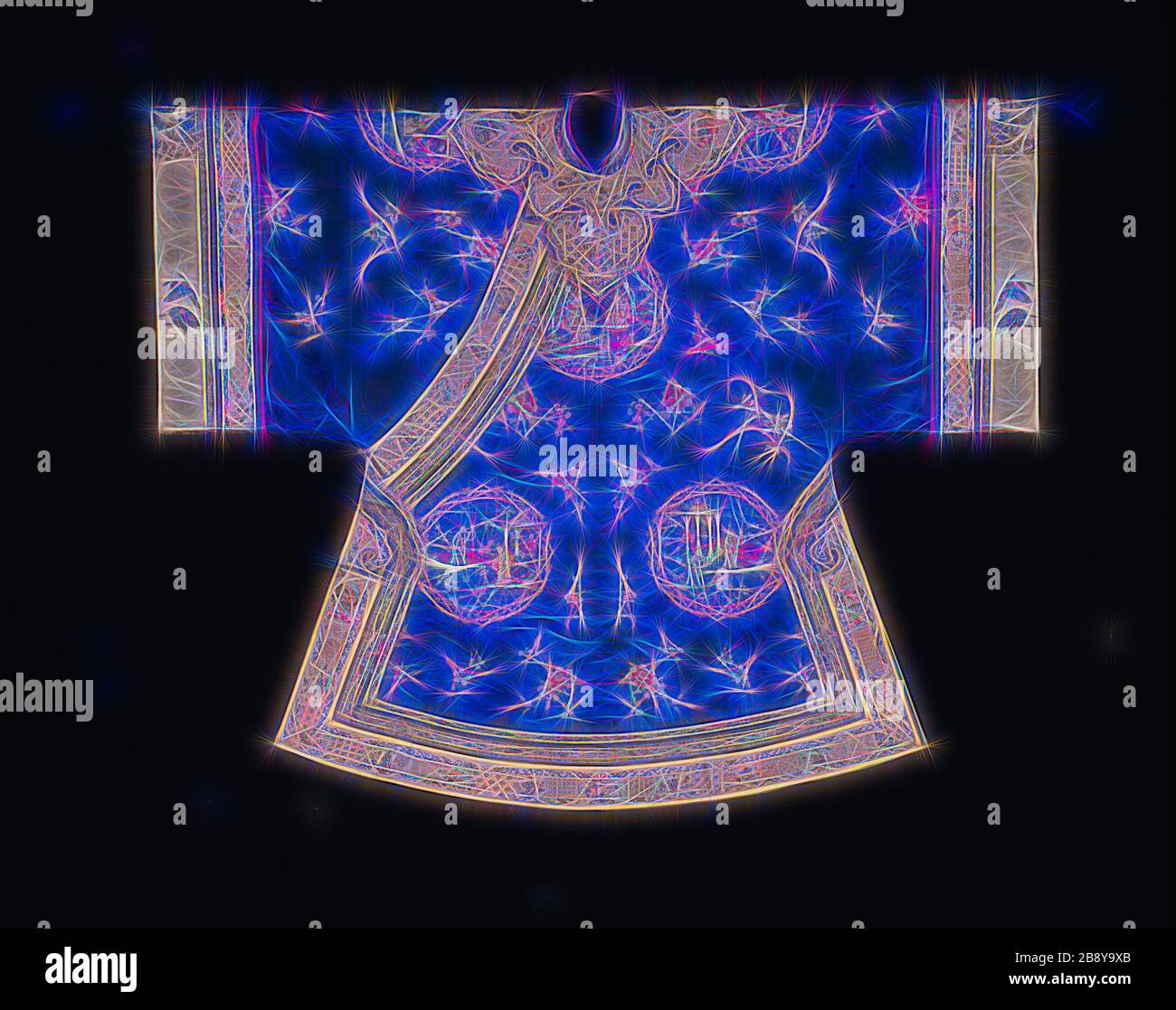 Woman’s Ao (Short Robe), Qing dynasty (1644–1911), 1875/1900, Han-Chinese, China, Silk, warp-float faced 7:1 satin weave, embroidered with silk and gold-leaf-over-lacquered-paper-strip-wrapped silk in knot, satin and stem stitches, laid work and couching, sleeve facing: silk, 7:1 satin damask weave, embroidered with silk and gilt-metal-strip-wrapped silk in knot, satin, single satin, split, and stem stitches (under drawing in black ink or graphite), edging and cloud collar: silk, warp-float faced 7:1 satin weave, embroidered with silk and gold-leaf-over-lacquered-paper-wrapped silk in satin an Stock Photohttps://www.alamy.com/image-license-details/?v=1https://www.alamy.com/womans-ao-short-robe-qing-dynasty-16441911-18751900-han-chinese-china-silk-warp-float-faced-71-satin-weave-embroidered-with-silk-and-gold-leaf-over-lacquered-paper-strip-wrapped-silk-in-knot-satin-and-stem-stitches-laid-work-and-couching-sleeve-facing-silk-71-satin-damask-weave-embroidered-with-silk-and-gilt-metal-strip-wrapped-silk-in-knot-satin-single-satin-split-and-stem-stitches-under-drawing-in-black-ink-or-graphite-edging-and-cloud-collar-silk-warp-float-faced-71-satin-weave-embroidered-with-silk-and-gold-leaf-over-lacquered-paper-wrapped-silk-in-satin-an-image349725107.html
Woman’s Ao (Short Robe), Qing dynasty (1644–1911), 1875/1900, Han-Chinese, China, Silk, warp-float faced 7:1 satin weave, embroidered with silk and gold-leaf-over-lacquered-paper-strip-wrapped silk in knot, satin and stem stitches, laid work and couching, sleeve facing: silk, 7:1 satin damask weave, embroidered with silk and gilt-metal-strip-wrapped silk in knot, satin, single satin, split, and stem stitches (under drawing in black ink or graphite), edging and cloud collar: silk, warp-float faced 7:1 satin weave, embroidered with silk and gold-leaf-over-lacquered-paper-wrapped silk in satin an Stock Photohttps://www.alamy.com/image-license-details/?v=1https://www.alamy.com/womans-ao-short-robe-qing-dynasty-16441911-18751900-han-chinese-china-silk-warp-float-faced-71-satin-weave-embroidered-with-silk-and-gold-leaf-over-lacquered-paper-strip-wrapped-silk-in-knot-satin-and-stem-stitches-laid-work-and-couching-sleeve-facing-silk-71-satin-damask-weave-embroidered-with-silk-and-gilt-metal-strip-wrapped-silk-in-knot-satin-single-satin-split-and-stem-stitches-under-drawing-in-black-ink-or-graphite-edging-and-cloud-collar-silk-warp-float-faced-71-satin-weave-embroidered-with-silk-and-gold-leaf-over-lacquered-paper-wrapped-silk-in-satin-an-image349725107.htmlRF2B8Y9XB–Woman’s Ao (Short Robe), Qing dynasty (1644–1911), 1875/1900, Han-Chinese, China, Silk, warp-float faced 7:1 satin weave, embroidered with silk and gold-leaf-over-lacquered-paper-strip-wrapped silk in knot, satin and stem stitches, laid work and couching, sleeve facing: silk, 7:1 satin damask weave, embroidered with silk and gilt-metal-strip-wrapped silk in knot, satin, single satin, split, and stem stitches (under drawing in black ink or graphite), edging and cloud collar: silk, warp-float faced 7:1 satin weave, embroidered with silk and gold-leaf-over-lacquered-paper-wrapped silk in satin an
 Woman holding fruit to chin, side view, portrait Stock Photohttps://www.alamy.com/image-license-details/?v=1https://www.alamy.com/woman-holding-fruit-to-chin-side-view-portrait-image5436698.html
Woman holding fruit to chin, side view, portrait Stock Photohttps://www.alamy.com/image-license-details/?v=1https://www.alamy.com/woman-holding-fruit-to-chin-side-view-portrait-image5436698.htmlRFAWTN1B–Woman holding fruit to chin, side view, portrait
 Joyful elderly woman looks out from under the blanket Stock Photohttps://www.alamy.com/image-license-details/?v=1https://www.alamy.com/joyful-elderly-woman-looks-out-from-under-the-blanket-image571377553.html
Joyful elderly woman looks out from under the blanket Stock Photohttps://www.alamy.com/image-license-details/?v=1https://www.alamy.com/joyful-elderly-woman-looks-out-from-under-the-blanket-image571377553.htmlRF2T5GDW5–Joyful elderly woman looks out from under the blanket
 Lictor with fasces, ancient Rome. In tunic, sagulum gregale or short trounsers, sandals, in front of an acqueduct and ruined arch. Licteur. Handcoloured copperplate drawn and engraved by L. Labrousse, artist of Bordeaux, under the direction of Jacques Grasset de Saint-Sauveur from his Lantique Rome, ou description historique et pittoresque, Ancient Rome, or historical and picturesque description, Chez Deroy, Paris, 1796. Stock Photohttps://www.alamy.com/image-license-details/?v=1https://www.alamy.com/lictor-with-fasces-ancient-rome-in-tunic-sagulum-gregale-or-short-trounsers-sandals-in-front-of-an-acqueduct-and-ruined-arch-licteur-handcoloured-copperplate-drawn-and-engraved-by-l-labrousse-artist-of-bordeaux-under-the-direction-of-jacques-grasset-de-saint-sauveur-from-his-lantique-rome-ou-description-historique-et-pittoresque-ancient-rome-or-historical-and-picturesque-description-chez-deroy-paris-1796-image571837399.html
Lictor with fasces, ancient Rome. In tunic, sagulum gregale or short trounsers, sandals, in front of an acqueduct and ruined arch. Licteur. Handcoloured copperplate drawn and engraved by L. Labrousse, artist of Bordeaux, under the direction of Jacques Grasset de Saint-Sauveur from his Lantique Rome, ou description historique et pittoresque, Ancient Rome, or historical and picturesque description, Chez Deroy, Paris, 1796. Stock Photohttps://www.alamy.com/image-license-details/?v=1https://www.alamy.com/lictor-with-fasces-ancient-rome-in-tunic-sagulum-gregale-or-short-trounsers-sandals-in-front-of-an-acqueduct-and-ruined-arch-licteur-handcoloured-copperplate-drawn-and-engraved-by-l-labrousse-artist-of-bordeaux-under-the-direction-of-jacques-grasset-de-saint-sauveur-from-his-lantique-rome-ou-description-historique-et-pittoresque-ancient-rome-or-historical-and-picturesque-description-chez-deroy-paris-1796-image571837399.htmlRM2T69CC7–Lictor with fasces, ancient Rome. In tunic, sagulum gregale or short trounsers, sandals, in front of an acqueduct and ruined arch. Licteur. Handcoloured copperplate drawn and engraved by L. Labrousse, artist of Bordeaux, under the direction of Jacques Grasset de Saint-Sauveur from his Lantique Rome, ou description historique et pittoresque, Ancient Rome, or historical and picturesque description, Chez Deroy, Paris, 1796.
![The Royal Visit to Cambridge: presentation of the university address to the Prince and Princess [of Wales] in the quadrangle of Trinity College, 1864. '...their Royal Highnesses [ie the future King Edward VII and Queen Alexandra] were conducted to a platform erected under a marquee beneath the shadow of the dining-hall. Here the Duke of Devonshire (Chancellor, of the University), the Vice-Chancellor (Dr. Cookson), the heads of houses, professors, and members of the Senate were assembled to present a formal address to the Prince of Wales. The Prince read a short reply, in which he acknowledged Stock Photo The Royal Visit to Cambridge: presentation of the university address to the Prince and Princess [of Wales] in the quadrangle of Trinity College, 1864. '...their Royal Highnesses [ie the future King Edward VII and Queen Alexandra] were conducted to a platform erected under a marquee beneath the shadow of the dining-hall. Here the Duke of Devonshire (Chancellor, of the University), the Vice-Chancellor (Dr. Cookson), the heads of houses, professors, and members of the Senate were assembled to present a formal address to the Prince of Wales. The Prince read a short reply, in which he acknowledged Stock Photo](https://c8.alamy.com/comp/2X21W4B/the-royal-visit-to-cambridge-presentation-of-the-university-address-to-the-prince-and-princess-of-wales-in-the-quadrangle-of-trinity-college-1864-their-royal-highnesses-ie-the-future-king-edward-vii-and-queen-alexandra-were-conducted-to-a-platform-erected-under-a-marquee-beneath-the-shadow-of-the-dining-hall-here-the-duke-of-devonshire-chancellor-of-the-university-the-vice-chancellor-dr-cookson-the-heads-of-houses-professors-and-members-of-the-senate-were-assembled-to-present-a-formal-address-to-the-prince-of-wales-the-prince-read-a-short-reply-in-which-he-acknowledged-2X21W4B.jpg) The Royal Visit to Cambridge: presentation of the university address to the Prince and Princess [of Wales] in the quadrangle of Trinity College, 1864. '...their Royal Highnesses [ie the future King Edward VII and Queen Alexandra] were conducted to a platform erected under a marquee beneath the shadow of the dining-hall. Here the Duke of Devonshire (Chancellor, of the University), the Vice-Chancellor (Dr. Cookson), the heads of houses, professors, and members of the Senate were assembled to present a formal address to the Prince of Wales. The Prince read a short reply, in which he acknowledged Stock Photohttps://www.alamy.com/image-license-details/?v=1https://www.alamy.com/the-royal-visit-to-cambridge-presentation-of-the-university-address-to-the-prince-and-princess-of-wales-in-the-quadrangle-of-trinity-college-1864-their-royal-highnesses-ie-the-future-king-edward-vii-and-queen-alexandra-were-conducted-to-a-platform-erected-under-a-marquee-beneath-the-shadow-of-the-dining-hall-here-the-duke-of-devonshire-chancellor-of-the-university-the-vice-chancellor-dr-cookson-the-heads-of-houses-professors-and-members-of-the-senate-were-assembled-to-present-a-formal-address-to-the-prince-of-wales-the-prince-read-a-short-reply-in-which-he-acknowledged-image603633867.html
The Royal Visit to Cambridge: presentation of the university address to the Prince and Princess [of Wales] in the quadrangle of Trinity College, 1864. '...their Royal Highnesses [ie the future King Edward VII and Queen Alexandra] were conducted to a platform erected under a marquee beneath the shadow of the dining-hall. Here the Duke of Devonshire (Chancellor, of the University), the Vice-Chancellor (Dr. Cookson), the heads of houses, professors, and members of the Senate were assembled to present a formal address to the Prince of Wales. The Prince read a short reply, in which he acknowledged Stock Photohttps://www.alamy.com/image-license-details/?v=1https://www.alamy.com/the-royal-visit-to-cambridge-presentation-of-the-university-address-to-the-prince-and-princess-of-wales-in-the-quadrangle-of-trinity-college-1864-their-royal-highnesses-ie-the-future-king-edward-vii-and-queen-alexandra-were-conducted-to-a-platform-erected-under-a-marquee-beneath-the-shadow-of-the-dining-hall-here-the-duke-of-devonshire-chancellor-of-the-university-the-vice-chancellor-dr-cookson-the-heads-of-houses-professors-and-members-of-the-senate-were-assembled-to-present-a-formal-address-to-the-prince-of-wales-the-prince-read-a-short-reply-in-which-he-acknowledged-image603633867.htmlRM2X21W4B–The Royal Visit to Cambridge: presentation of the university address to the Prince and Princess [of Wales] in the quadrangle of Trinity College, 1864. '...their Royal Highnesses [ie the future King Edward VII and Queen Alexandra] were conducted to a platform erected under a marquee beneath the shadow of the dining-hall. Here the Duke of Devonshire (Chancellor, of the University), the Vice-Chancellor (Dr. Cookson), the heads of houses, professors, and members of the Senate were assembled to present a formal address to the Prince of Wales. The Prince read a short reply, in which he acknowledged
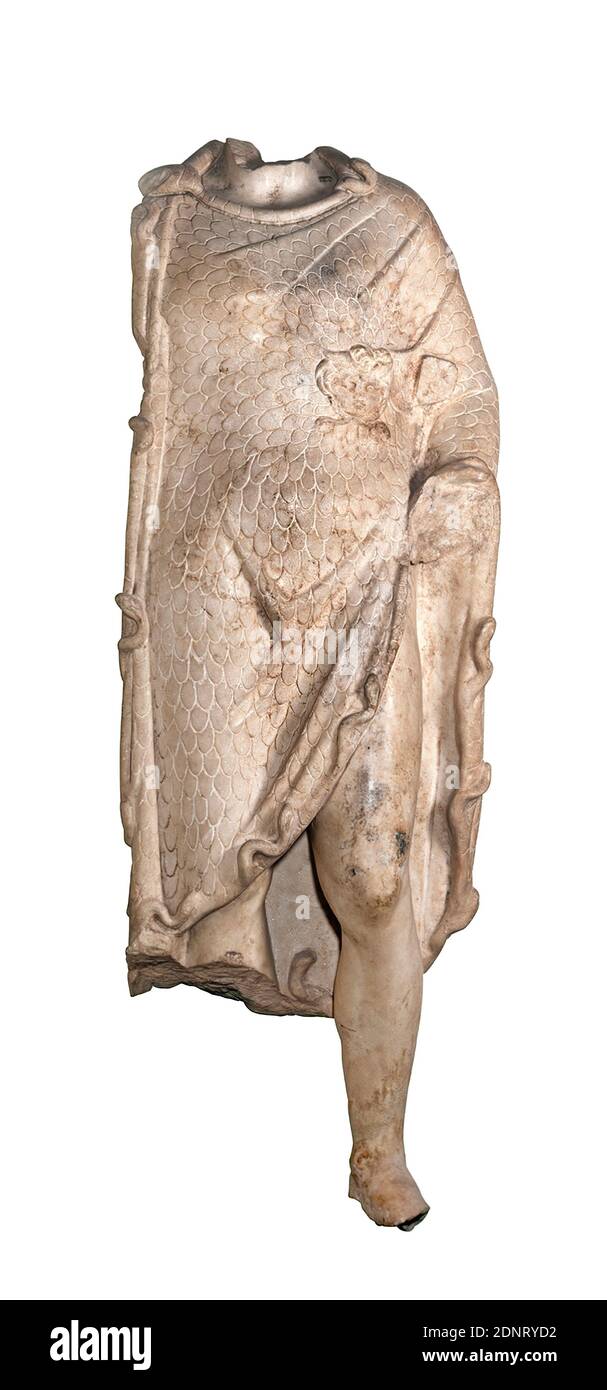 Alexander the Great (type Aigiochos), Marble, chiseled, Total: Height: 135.5 cm; Width: 55.5 cm; Depth: 25.5 cm, Three-dimensional sculptures, Portrait of a ruler, State portrait, History of Alexander the Great, Alexander the Great, Middle Imperial Period, Roman copy after a Greek original Under life-size marble statue of a man with a short coat (Greek: Chlamys) in the shape of an Aigis (mythical goatskin). The left arm is bent and stretched out. The right leg was used as a supporting leg, while the left one is slightly bent and set aside to the side. Stock Photohttps://www.alamy.com/image-license-details/?v=1https://www.alamy.com/alexander-the-great-type-aigiochos-marble-chiseled-total-height-1355-cm-width-555-cm-depth-255-cm-three-dimensional-sculptures-portrait-of-a-ruler-state-portrait-history-of-alexander-the-great-alexander-the-great-middle-imperial-period-roman-copy-after-a-greek-original-under-life-size-marble-statue-of-a-man-with-a-short-coat-greek-chlamys-in-the-shape-of-an-aigis-mythical-goatskin-the-left-arm-is-bent-and-stretched-out-the-right-leg-was-used-as-a-supporting-leg-while-the-left-one-is-slightly-bent-and-set-aside-to-the-side-image392062302.html
Alexander the Great (type Aigiochos), Marble, chiseled, Total: Height: 135.5 cm; Width: 55.5 cm; Depth: 25.5 cm, Three-dimensional sculptures, Portrait of a ruler, State portrait, History of Alexander the Great, Alexander the Great, Middle Imperial Period, Roman copy after a Greek original Under life-size marble statue of a man with a short coat (Greek: Chlamys) in the shape of an Aigis (mythical goatskin). The left arm is bent and stretched out. The right leg was used as a supporting leg, while the left one is slightly bent and set aside to the side. Stock Photohttps://www.alamy.com/image-license-details/?v=1https://www.alamy.com/alexander-the-great-type-aigiochos-marble-chiseled-total-height-1355-cm-width-555-cm-depth-255-cm-three-dimensional-sculptures-portrait-of-a-ruler-state-portrait-history-of-alexander-the-great-alexander-the-great-middle-imperial-period-roman-copy-after-a-greek-original-under-life-size-marble-statue-of-a-man-with-a-short-coat-greek-chlamys-in-the-shape-of-an-aigis-mythical-goatskin-the-left-arm-is-bent-and-stretched-out-the-right-leg-was-used-as-a-supporting-leg-while-the-left-one-is-slightly-bent-and-set-aside-to-the-side-image392062302.htmlRM2DNRYD2–Alexander the Great (type Aigiochos), Marble, chiseled, Total: Height: 135.5 cm; Width: 55.5 cm; Depth: 25.5 cm, Three-dimensional sculptures, Portrait of a ruler, State portrait, History of Alexander the Great, Alexander the Great, Middle Imperial Period, Roman copy after a Greek original Under life-size marble statue of a man with a short coat (Greek: Chlamys) in the shape of an Aigis (mythical goatskin). The left arm is bent and stretched out. The right leg was used as a supporting leg, while the left one is slightly bent and set aside to the side.
 Holy Wilhelmus of Aquitaine in order robe of the Benedictines. Under the picture a cartouche with a short Latin text about his life. Part of a series of images of the main founders of the kloosterorden. Manufacturer : printmaker Cornelis Galle (I) designed by Peter Paul Rubens (possible) Publisher: Theodore Gall Grantor of privilege unknown (listed property) Date: ca. 1586 - ca. 1633 Physical characteristics: engra material: paper Technique: engra (printing process) Measurements: sheet: h 150 mm × W 105 mmToelichtingHandgeschreven addenda to Hollstein, No. 163 aj, registered in the copy of the Stock Photohttps://www.alamy.com/image-license-details/?v=1https://www.alamy.com/holy-wilhelmus-of-aquitaine-in-order-robe-of-the-benedictines-under-the-picture-a-cartouche-with-a-short-latin-text-about-his-life-part-of-a-series-of-images-of-the-main-founders-of-the-kloosterorden-manufacturer-printmaker-cornelis-galle-i-designed-by-peter-paul-rubens-possible-publisher-theodore-gall-grantor-of-privilege-unknown-listed-property-date-ca-1586-ca-1633-physical-characteristics-engra-material-paper-technique-engra-printing-process-measurements-sheet-h-150-mm-w-105-mmtoelichtinghandgeschreven-addenda-to-hollstein-no-163-aj-registered-in-the-copy-of-the-image348423468.html
Holy Wilhelmus of Aquitaine in order robe of the Benedictines. Under the picture a cartouche with a short Latin text about his life. Part of a series of images of the main founders of the kloosterorden. Manufacturer : printmaker Cornelis Galle (I) designed by Peter Paul Rubens (possible) Publisher: Theodore Gall Grantor of privilege unknown (listed property) Date: ca. 1586 - ca. 1633 Physical characteristics: engra material: paper Technique: engra (printing process) Measurements: sheet: h 150 mm × W 105 mmToelichtingHandgeschreven addenda to Hollstein, No. 163 aj, registered in the copy of the Stock Photohttps://www.alamy.com/image-license-details/?v=1https://www.alamy.com/holy-wilhelmus-of-aquitaine-in-order-robe-of-the-benedictines-under-the-picture-a-cartouche-with-a-short-latin-text-about-his-life-part-of-a-series-of-images-of-the-main-founders-of-the-kloosterorden-manufacturer-printmaker-cornelis-galle-i-designed-by-peter-paul-rubens-possible-publisher-theodore-gall-grantor-of-privilege-unknown-listed-property-date-ca-1586-ca-1633-physical-characteristics-engra-material-paper-technique-engra-printing-process-measurements-sheet-h-150-mm-w-105-mmtoelichtinghandgeschreven-addenda-to-hollstein-no-163-aj-registered-in-the-copy-of-the-image348423468.htmlRM2B6T1K8–Holy Wilhelmus of Aquitaine in order robe of the Benedictines. Under the picture a cartouche with a short Latin text about his life. Part of a series of images of the main founders of the kloosterorden. Manufacturer : printmaker Cornelis Galle (I) designed by Peter Paul Rubens (possible) Publisher: Theodore Gall Grantor of privilege unknown (listed property) Date: ca. 1586 - ca. 1633 Physical characteristics: engra material: paper Technique: engra (printing process) Measurements: sheet: h 150 mm × W 105 mmToelichtingHandgeschreven addenda to Hollstein, No. 163 aj, registered in the copy of the
 St Catherine of Alexandria, Master of Koudewater (follower of), c. 1510 The holy stands on a versatile plinth with the bent right leg forward over Maxentius. She stares right in front of herself, holds a book on the left and in the judge the lost attribute, the sword. A wounded pearl band rests on the hair, which falls down in long wavy tresses, each ending in a curl. Over a thin undercreft with front and long wide, flared sleeves, a robe with short sleeves, on which frills, and a round, embroidered neck; It is included under the left arm, so that the right shoe point is released. The cloak, o Stock Photohttps://www.alamy.com/image-license-details/?v=1https://www.alamy.com/st-catherine-of-alexandria-master-of-koudewater-follower-of-c-1510-the-holy-stands-on-a-versatile-plinth-with-the-bent-right-leg-forward-over-maxentius-she-stares-right-in-front-of-herself-holds-a-book-on-the-left-and-in-the-judge-the-lost-attribute-the-sword-a-wounded-pearl-band-rests-on-the-hair-which-falls-down-in-long-wavy-tresses-each-ending-in-a-curl-over-a-thin-undercreft-with-front-and-long-wide-flared-sleeves-a-robe-with-short-sleeves-on-which-frills-and-a-round-embroidered-neck-it-is-included-under-the-left-arm-so-that-the-right-shoe-point-is-released-the-cloak-o-image576576858.html
St Catherine of Alexandria, Master of Koudewater (follower of), c. 1510 The holy stands on a versatile plinth with the bent right leg forward over Maxentius. She stares right in front of herself, holds a book on the left and in the judge the lost attribute, the sword. A wounded pearl band rests on the hair, which falls down in long wavy tresses, each ending in a curl. Over a thin undercreft with front and long wide, flared sleeves, a robe with short sleeves, on which frills, and a round, embroidered neck; It is included under the left arm, so that the right shoe point is released. The cloak, o Stock Photohttps://www.alamy.com/image-license-details/?v=1https://www.alamy.com/st-catherine-of-alexandria-master-of-koudewater-follower-of-c-1510-the-holy-stands-on-a-versatile-plinth-with-the-bent-right-leg-forward-over-maxentius-she-stares-right-in-front-of-herself-holds-a-book-on-the-left-and-in-the-judge-the-lost-attribute-the-sword-a-wounded-pearl-band-rests-on-the-hair-which-falls-down-in-long-wavy-tresses-each-ending-in-a-curl-over-a-thin-undercreft-with-front-and-long-wide-flared-sleeves-a-robe-with-short-sleeves-on-which-frills-and-a-round-embroidered-neck-it-is-included-under-the-left-arm-so-that-the-right-shoe-point-is-released-the-cloak-o-image576576858.htmlRM2TE19JJ–St Catherine of Alexandria, Master of Koudewater (follower of), c. 1510 The holy stands on a versatile plinth with the bent right leg forward over Maxentius. She stares right in front of herself, holds a book on the left and in the judge the lost attribute, the sword. A wounded pearl band rests on the hair, which falls down in long wavy tresses, each ending in a curl. Over a thin undercreft with front and long wide, flared sleeves, a robe with short sleeves, on which frills, and a round, embroidered neck; It is included under the left arm, so that the right shoe point is released. The cloak, o
 Statuette of Artemis Bendis, 325-300 BC. Additional Info: Artemis, goddess of the hunt, stands frontally with her weight on her right leg. Her left leg is relaxed with the knee bent slightly. She wears boots that come up to just under the knees and a short chiton buttoned at the shoulders and along the right arm. Over the chiton is a short-sleeved tunic and a short peplos with omega folds at the hem, which ends just above the knees. Over these three layers of clothing, the goddess wears a deer skin wrapped around her midsection and draped over her left shoulder. The head of the deer is at the Stock Photohttps://www.alamy.com/image-license-details/?v=1https://www.alamy.com/statuette-of-artemis-bendis-325-300-bc-additional-info-artemis-goddess-of-the-hunt-stands-frontally-with-her-weight-on-her-right-leg-her-left-leg-is-relaxed-with-the-knee-bent-slightly-she-wears-boots-that-come-up-to-just-under-the-knees-and-a-short-chiton-buttoned-at-the-shoulders-and-along-the-right-arm-over-the-chiton-is-a-short-sleeved-tunic-and-a-short-peplos-with-omega-folds-at-the-hem-which-ends-just-above-the-knees-over-these-three-layers-of-clothing-the-goddess-wears-a-deer-skin-wrapped-around-her-midsection-and-draped-over-her-left-shoulder-the-head-of-the-deer-is-at-the-image635662744.html
Statuette of Artemis Bendis, 325-300 BC. Additional Info: Artemis, goddess of the hunt, stands frontally with her weight on her right leg. Her left leg is relaxed with the knee bent slightly. She wears boots that come up to just under the knees and a short chiton buttoned at the shoulders and along the right arm. Over the chiton is a short-sleeved tunic and a short peplos with omega folds at the hem, which ends just above the knees. Over these three layers of clothing, the goddess wears a deer skin wrapped around her midsection and draped over her left shoulder. The head of the deer is at the Stock Photohttps://www.alamy.com/image-license-details/?v=1https://www.alamy.com/statuette-of-artemis-bendis-325-300-bc-additional-info-artemis-goddess-of-the-hunt-stands-frontally-with-her-weight-on-her-right-leg-her-left-leg-is-relaxed-with-the-knee-bent-slightly-she-wears-boots-that-come-up-to-just-under-the-knees-and-a-short-chiton-buttoned-at-the-shoulders-and-along-the-right-arm-over-the-chiton-is-a-short-sleeved-tunic-and-a-short-peplos-with-omega-folds-at-the-hem-which-ends-just-above-the-knees-over-these-three-layers-of-clothing-the-goddess-wears-a-deer-skin-wrapped-around-her-midsection-and-draped-over-her-left-shoulder-the-head-of-the-deer-is-at-the-image635662744.htmlRM2YX4X8T–Statuette of Artemis Bendis, 325-300 BC. Additional Info: Artemis, goddess of the hunt, stands frontally with her weight on her right leg. Her left leg is relaxed with the knee bent slightly. She wears boots that come up to just under the knees and a short chiton buttoned at the shoulders and along the right arm. Over the chiton is a short-sleeved tunic and a short peplos with omega folds at the hem, which ends just above the knees. Over these three layers of clothing, the goddess wears a deer skin wrapped around her midsection and draped over her left shoulder. The head of the deer is at the
 Inspired by Journal des Dames et des Modes, Frankfurt edition 22 Février 1808, Costume Parisien (8), The accompanying text (pp. 212 and 213) states: Fig. 1: Coiffure de grande parure: gauze of gold thread, braided with hair. Short gown of white satin, embroidered with gold. Blue, embroidered manteau, Reimagined by Artotop. Classic art reinvented with a modern twist. Design of warm cheerful glowing of brightness and light ray radiance. Photography inspired by surrealism and futurism, embracing dynamic energy of modern technology, movement, speed and revolutionize culture Stock Photohttps://www.alamy.com/image-license-details/?v=1https://www.alamy.com/inspired-by-journal-des-dames-et-des-modes-frankfurt-edition-22-fvrier-1808-costume-parisien-8-the-accompanying-text-pp-212-and-213-states-fig-1-coiffure-de-grande-parure-gauze-of-gold-thread-braided-with-hair-short-gown-of-white-satin-embroidered-with-gold-blue-embroidered-manteau-reimagined-by-artotop-classic-art-reinvented-with-a-modern-twist-design-of-warm-cheerful-glowing-of-brightness-and-light-ray-radiance-photography-inspired-by-surrealism-and-futurism-embracing-dynamic-energy-of-modern-technology-movement-speed-and-revolutionize-culture-image459372234.html
Inspired by Journal des Dames et des Modes, Frankfurt edition 22 Février 1808, Costume Parisien (8), The accompanying text (pp. 212 and 213) states: Fig. 1: Coiffure de grande parure: gauze of gold thread, braided with hair. Short gown of white satin, embroidered with gold. Blue, embroidered manteau, Reimagined by Artotop. Classic art reinvented with a modern twist. Design of warm cheerful glowing of brightness and light ray radiance. Photography inspired by surrealism and futurism, embracing dynamic energy of modern technology, movement, speed and revolutionize culture Stock Photohttps://www.alamy.com/image-license-details/?v=1https://www.alamy.com/inspired-by-journal-des-dames-et-des-modes-frankfurt-edition-22-fvrier-1808-costume-parisien-8-the-accompanying-text-pp-212-and-213-states-fig-1-coiffure-de-grande-parure-gauze-of-gold-thread-braided-with-hair-short-gown-of-white-satin-embroidered-with-gold-blue-embroidered-manteau-reimagined-by-artotop-classic-art-reinvented-with-a-modern-twist-design-of-warm-cheerful-glowing-of-brightness-and-light-ray-radiance-photography-inspired-by-surrealism-and-futurism-embracing-dynamic-energy-of-modern-technology-movement-speed-and-revolutionize-culture-image459372234.htmlRF2HKA5Y6–Inspired by Journal des Dames et des Modes, Frankfurt edition 22 Février 1808, Costume Parisien (8), The accompanying text (pp. 212 and 213) states: Fig. 1: Coiffure de grande parure: gauze of gold thread, braided with hair. Short gown of white satin, embroidered with gold. Blue, embroidered manteau, Reimagined by Artotop. Classic art reinvented with a modern twist. Design of warm cheerful glowing of brightness and light ray radiance. Photography inspired by surrealism and futurism, embracing dynamic energy of modern technology, movement, speed and revolutionize culture
 Roman soldier with scutum and gladius, ancient Rome. He wears a galea helmet, leather breastplate or lorica, tunic, sagulum gregale short trousers and caligae hobnail sandals. Soldat Romain. Handcoloured copperplate drawn and engraved by L. Labrousse, artist of Bordeaux, under the direction of Jacques Grasset de Saint-Sauveur from his Lantique Rome, ou description historique et pittoresque, Ancient Rome, or historical and picturesque description, Chez Deroy, Paris, 1796. Stock Photohttps://www.alamy.com/image-license-details/?v=1https://www.alamy.com/roman-soldier-with-scutum-and-gladius-ancient-rome-he-wears-a-galea-helmet-leather-breastplate-or-lorica-tunic-sagulum-gregale-short-trousers-and-caligae-hobnail-sandals-soldat-romain-handcoloured-copperplate-drawn-and-engraved-by-l-labrousse-artist-of-bordeaux-under-the-direction-of-jacques-grasset-de-saint-sauveur-from-his-lantique-rome-ou-description-historique-et-pittoresque-ancient-rome-or-historical-and-picturesque-description-chez-deroy-paris-1796-image571845614.html
Roman soldier with scutum and gladius, ancient Rome. He wears a galea helmet, leather breastplate or lorica, tunic, sagulum gregale short trousers and caligae hobnail sandals. Soldat Romain. Handcoloured copperplate drawn and engraved by L. Labrousse, artist of Bordeaux, under the direction of Jacques Grasset de Saint-Sauveur from his Lantique Rome, ou description historique et pittoresque, Ancient Rome, or historical and picturesque description, Chez Deroy, Paris, 1796. Stock Photohttps://www.alamy.com/image-license-details/?v=1https://www.alamy.com/roman-soldier-with-scutum-and-gladius-ancient-rome-he-wears-a-galea-helmet-leather-breastplate-or-lorica-tunic-sagulum-gregale-short-trousers-and-caligae-hobnail-sandals-soldat-romain-handcoloured-copperplate-drawn-and-engraved-by-l-labrousse-artist-of-bordeaux-under-the-direction-of-jacques-grasset-de-saint-sauveur-from-his-lantique-rome-ou-description-historique-et-pittoresque-ancient-rome-or-historical-and-picturesque-description-chez-deroy-paris-1796-image571845614.htmlRM2T69PWJ–Roman soldier with scutum and gladius, ancient Rome. He wears a galea helmet, leather breastplate or lorica, tunic, sagulum gregale short trousers and caligae hobnail sandals. Soldat Romain. Handcoloured copperplate drawn and engraved by L. Labrousse, artist of Bordeaux, under the direction of Jacques Grasset de Saint-Sauveur from his Lantique Rome, ou description historique et pittoresque, Ancient Rome, or historical and picturesque description, Chez Deroy, Paris, 1796.
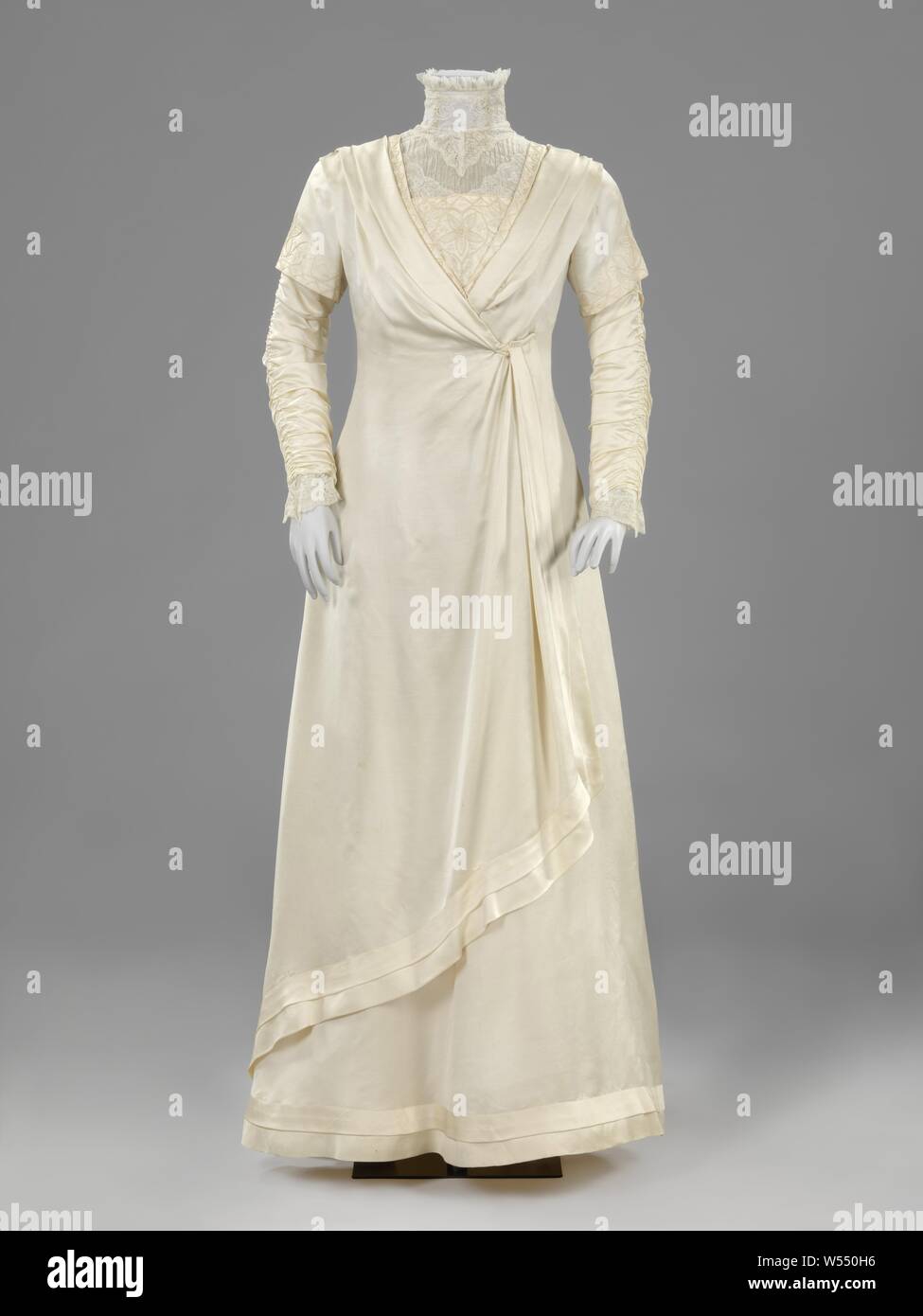 Wedding dress with embroidered and ruffled double sleeves, White satin bridal gown with gaze de soie and bobbin lace, consisting of a frock (a), an underskirt (b) and matching shoes (c, d) of white glacé leather, white satin bridal gown with gaze de soie and bobbin lace, a underskirt (b) and matching shoes (c, d) of white glacé leather. Model (a): Robe princesse or Tanagré enne with a dragged-on trail. Front: the closure is hidden under a diagonally flipped tunic-shaped wrap. Deep v-neck with a low satin cardigan and a high second cardigan from gaze de soie and lace (18th century Mechelen Stock Photohttps://www.alamy.com/image-license-details/?v=1https://www.alamy.com/wedding-dress-with-embroidered-and-ruffled-double-sleeves-white-satin-bridal-gown-with-gaze-de-soie-and-bobbin-lace-consisting-of-a-frock-a-an-underskirt-b-and-matching-shoes-c-d-of-white-glac-leather-white-satin-bridal-gown-with-gaze-de-soie-and-bobbin-lace-a-underskirt-b-and-matching-shoes-c-d-of-white-glac-leather-model-a-robe-princesse-or-tanagr-enne-with-a-dragged-on-trail-front-the-closure-is-hidden-under-a-diagonally-flipped-tunic-shaped-wrap-deep-v-neck-with-a-low-satin-cardigan-and-a-high-second-cardigan-from-gaze-de-soie-and-lace-18th-century-mechelen-image261339042.html
Wedding dress with embroidered and ruffled double sleeves, White satin bridal gown with gaze de soie and bobbin lace, consisting of a frock (a), an underskirt (b) and matching shoes (c, d) of white glacé leather, white satin bridal gown with gaze de soie and bobbin lace, a underskirt (b) and matching shoes (c, d) of white glacé leather. Model (a): Robe princesse or Tanagré enne with a dragged-on trail. Front: the closure is hidden under a diagonally flipped tunic-shaped wrap. Deep v-neck with a low satin cardigan and a high second cardigan from gaze de soie and lace (18th century Mechelen Stock Photohttps://www.alamy.com/image-license-details/?v=1https://www.alamy.com/wedding-dress-with-embroidered-and-ruffled-double-sleeves-white-satin-bridal-gown-with-gaze-de-soie-and-bobbin-lace-consisting-of-a-frock-a-an-underskirt-b-and-matching-shoes-c-d-of-white-glac-leather-white-satin-bridal-gown-with-gaze-de-soie-and-bobbin-lace-a-underskirt-b-and-matching-shoes-c-d-of-white-glac-leather-model-a-robe-princesse-or-tanagr-enne-with-a-dragged-on-trail-front-the-closure-is-hidden-under-a-diagonally-flipped-tunic-shaped-wrap-deep-v-neck-with-a-low-satin-cardigan-and-a-high-second-cardigan-from-gaze-de-soie-and-lace-18th-century-mechelen-image261339042.htmlRMW550H6–Wedding dress with embroidered and ruffled double sleeves, White satin bridal gown with gaze de soie and bobbin lace, consisting of a frock (a), an underskirt (b) and matching shoes (c, d) of white glacé leather, white satin bridal gown with gaze de soie and bobbin lace, a underskirt (b) and matching shoes (c, d) of white glacé leather. Model (a): Robe princesse or Tanagré enne with a dragged-on trail. Front: the closure is hidden under a diagonally flipped tunic-shaped wrap. Deep v-neck with a low satin cardigan and a high second cardigan from gaze de soie and lace (18th century Mechelen
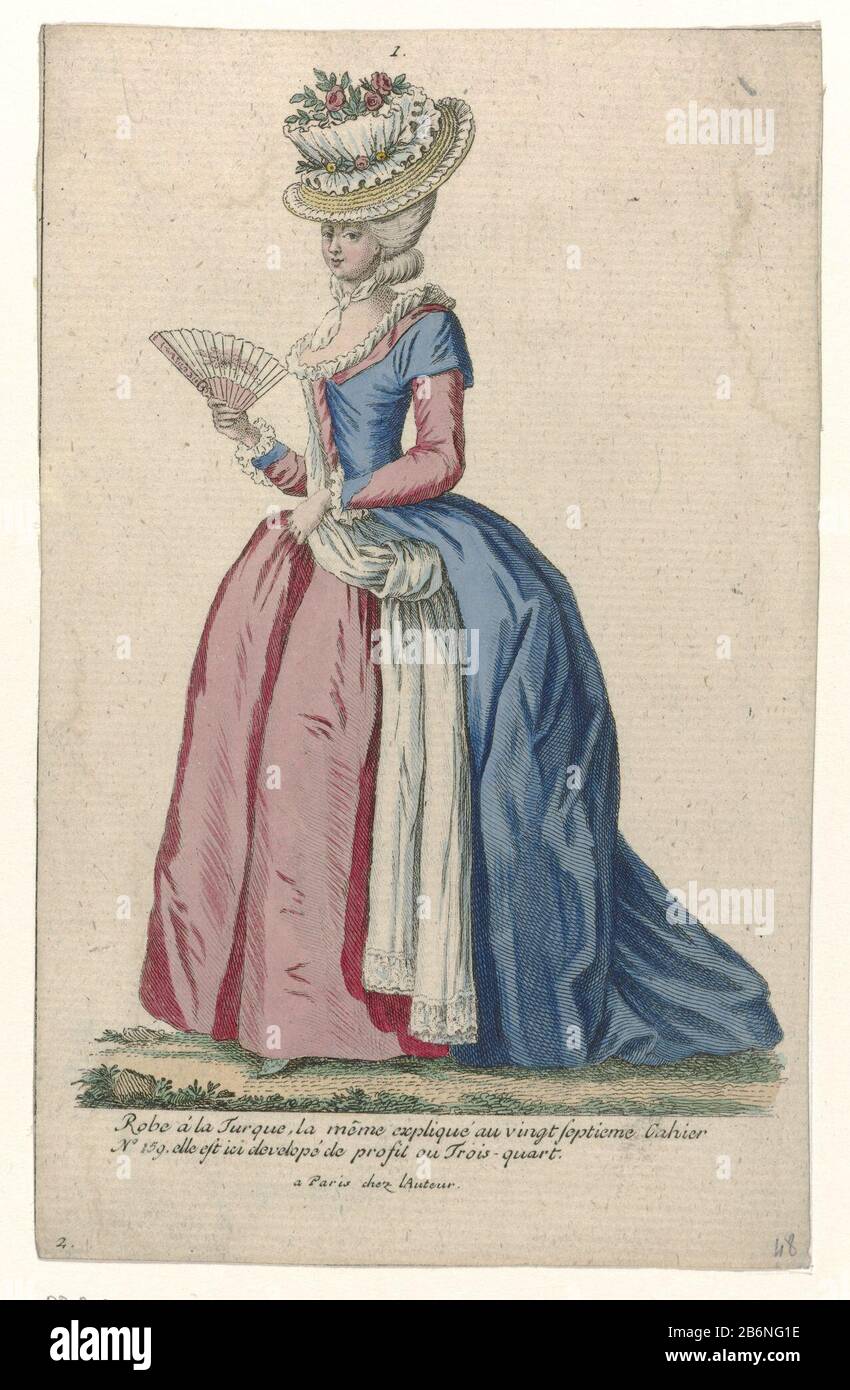 woman standing wearing a robe à laTurque. Gown with short sleeves and contrast ran under long sleeves, petticoat in the same color as the lower sleeves. Around the waist a knotted scarf. Accessories: hat decorated with flowers, knotted neckerchief, fold range. Copy to ff ff series of 175. Costumes 30th Cahier de Français, 23 Suite d'Habillements à la mode and 1780, Gallerie des Modes et Costumes Français. Manufacturer : printmaker: Pierre Gleich (possible) to print by Nicolas Dupinnaar drawing: Pierre Thomas Le Clerc Date: approx 1785 Physical characteristics: engra, hand-colored material: pap Stock Photohttps://www.alamy.com/image-license-details/?v=1https://www.alamy.com/woman-standing-wearing-a-robe-laturque-gown-with-short-sleeves-and-contrast-ran-under-long-sleeves-petticoat-in-the-same-color-as-the-lower-sleeves-around-the-waist-a-knotted-scarf-accessories-hat-decorated-with-flowers-knotted-neckerchief-fold-range-copy-to-ff-ff-series-of-175-costumes-30th-cahier-de-franais-23-suite-dhabillements-la-mode-and-1780-gallerie-des-modes-et-costumes-franais-manufacturer-printmaker-pierre-gleich-possible-to-print-by-nicolas-dupinnaar-drawing-pierre-thomas-le-clerc-date-approx-1785-physical-characteristics-engra-hand-colored-material-pap-image348368874.html
woman standing wearing a robe à laTurque. Gown with short sleeves and contrast ran under long sleeves, petticoat in the same color as the lower sleeves. Around the waist a knotted scarf. Accessories: hat decorated with flowers, knotted neckerchief, fold range. Copy to ff ff series of 175. Costumes 30th Cahier de Français, 23 Suite d'Habillements à la mode and 1780, Gallerie des Modes et Costumes Français. Manufacturer : printmaker: Pierre Gleich (possible) to print by Nicolas Dupinnaar drawing: Pierre Thomas Le Clerc Date: approx 1785 Physical characteristics: engra, hand-colored material: pap Stock Photohttps://www.alamy.com/image-license-details/?v=1https://www.alamy.com/woman-standing-wearing-a-robe-laturque-gown-with-short-sleeves-and-contrast-ran-under-long-sleeves-petticoat-in-the-same-color-as-the-lower-sleeves-around-the-waist-a-knotted-scarf-accessories-hat-decorated-with-flowers-knotted-neckerchief-fold-range-copy-to-ff-ff-series-of-175-costumes-30th-cahier-de-franais-23-suite-dhabillements-la-mode-and-1780-gallerie-des-modes-et-costumes-franais-manufacturer-printmaker-pierre-gleich-possible-to-print-by-nicolas-dupinnaar-drawing-pierre-thomas-le-clerc-date-approx-1785-physical-characteristics-engra-hand-colored-material-pap-image348368874.htmlRM2B6NG1E–woman standing wearing a robe à laTurque. Gown with short sleeves and contrast ran under long sleeves, petticoat in the same color as the lower sleeves. Around the waist a knotted scarf. Accessories: hat decorated with flowers, knotted neckerchief, fold range. Copy to ff ff series of 175. Costumes 30th Cahier de Français, 23 Suite d'Habillements à la mode and 1780, Gallerie des Modes et Costumes Français. Manufacturer : printmaker: Pierre Gleich (possible) to print by Nicolas Dupinnaar drawing: Pierre Thomas Le Clerc Date: approx 1785 Physical characteristics: engra, hand-colored material: pap
 Wedding dress with embroidered and ruffled double sleeves, anonymous, in or before 1909 Wedding gown of white satin with gaze de Soie and bobbin, consisting of a dress (a), an underskirt (b) and accompanying shoes (C, D) from white glacé leather. Model (A): Robe Princesse or Tanagréenne with cut drag. Front: The closure is hidden under a slanted tunic transhipment. Deep V-neck with a layer of satin cardigan and a high second cardigan from Gaze de Soie and Kant (18th century Malinois Kloskant); Little guy guy. Under a short, bell -shaped upper sleeve comes a narrow, frowned long sleeve, trimmed Stock Photohttps://www.alamy.com/image-license-details/?v=1https://www.alamy.com/wedding-dress-with-embroidered-and-ruffled-double-sleeves-anonymous-in-or-before-1909-wedding-gown-of-white-satin-with-gaze-de-soie-and-bobbin-consisting-of-a-dress-a-an-underskirt-b-and-accompanying-shoes-c-d-from-white-glac-leather-model-a-robe-princesse-or-tanagrenne-with-cut-drag-front-the-closure-is-hidden-under-a-slanted-tunic-transhipment-deep-v-neck-with-a-layer-of-satin-cardigan-and-a-high-second-cardigan-from-gaze-de-soie-and-kant-18th-century-malinois-kloskant-little-guy-guy-under-a-short-bell-shaped-upper-sleeve-comes-a-narrow-frowned-long-sleeve-trimmed-image576472334.html
Wedding dress with embroidered and ruffled double sleeves, anonymous, in or before 1909 Wedding gown of white satin with gaze de Soie and bobbin, consisting of a dress (a), an underskirt (b) and accompanying shoes (C, D) from white glacé leather. Model (A): Robe Princesse or Tanagréenne with cut drag. Front: The closure is hidden under a slanted tunic transhipment. Deep V-neck with a layer of satin cardigan and a high second cardigan from Gaze de Soie and Kant (18th century Malinois Kloskant); Little guy guy. Under a short, bell -shaped upper sleeve comes a narrow, frowned long sleeve, trimmed Stock Photohttps://www.alamy.com/image-license-details/?v=1https://www.alamy.com/wedding-dress-with-embroidered-and-ruffled-double-sleeves-anonymous-in-or-before-1909-wedding-gown-of-white-satin-with-gaze-de-soie-and-bobbin-consisting-of-a-dress-a-an-underskirt-b-and-accompanying-shoes-c-d-from-white-glac-leather-model-a-robe-princesse-or-tanagrenne-with-cut-drag-front-the-closure-is-hidden-under-a-slanted-tunic-transhipment-deep-v-neck-with-a-layer-of-satin-cardigan-and-a-high-second-cardigan-from-gaze-de-soie-and-kant-18th-century-malinois-kloskant-little-guy-guy-under-a-short-bell-shaped-upper-sleeve-comes-a-narrow-frowned-long-sleeve-trimmed-image576472334.htmlRM2TDTG9J–Wedding dress with embroidered and ruffled double sleeves, anonymous, in or before 1909 Wedding gown of white satin with gaze de Soie and bobbin, consisting of a dress (a), an underskirt (b) and accompanying shoes (C, D) from white glacé leather. Model (A): Robe Princesse or Tanagréenne with cut drag. Front: The closure is hidden under a slanted tunic transhipment. Deep V-neck with a layer of satin cardigan and a high second cardigan from Gaze de Soie and Kant (18th century Malinois Kloskant); Little guy guy. Under a short, bell -shaped upper sleeve comes a narrow, frowned long sleeve, trimmed
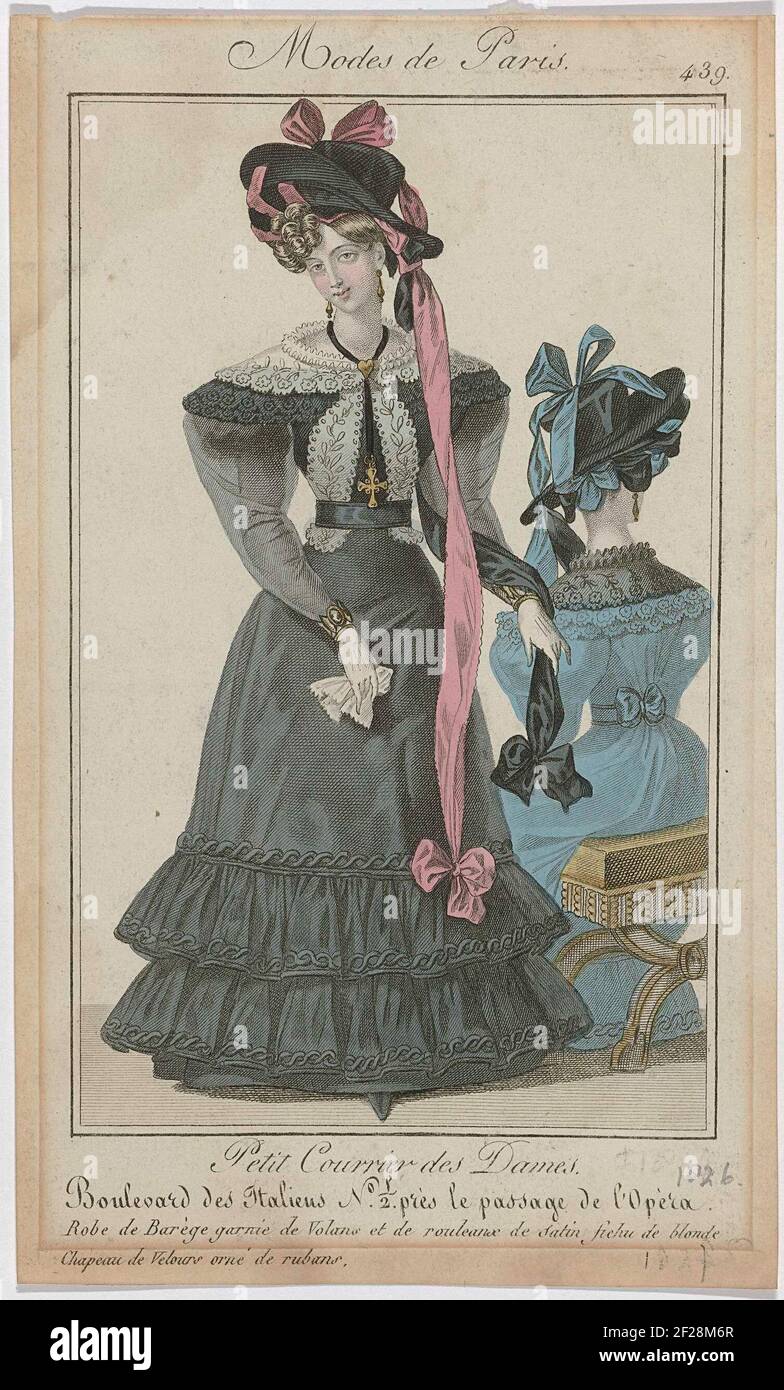 Petit Courrier des Dames, 1826, No. 439 : Robe de Barège garnie de Volans (...).Woman dressed in a junior of barège, trimmed with wrinkled strips fabric and a satin rouleaux. Long transparent sleeves over short puff sleeves. Fichu from blonde (dump edge), lit under the belt. Velvet hat, decorated with long ribbons. Further accessories: earrings, necklace with pendant in the shape of a cross, bracelets to both wrists, gloves, handkerchief. On the right a seated woman, seen on the back, dressed in the same dress. Print from the fashion magazine Petit Courier des Ladies (1821-1868). Stock Photohttps://www.alamy.com/image-license-details/?v=1https://www.alamy.com/petit-courrier-des-dames-1826-no-439-robe-de-barge-garnie-de-volans-woman-dressed-in-a-junior-of-barge-trimmed-with-wrinkled-strips-fabric-and-a-satin-rouleaux-long-transparent-sleeves-over-short-puff-sleeves-fichu-from-blonde-dump-edge-lit-under-the-belt-velvet-hat-decorated-with-long-ribbons-further-accessories-earrings-necklace-with-pendant-in-the-shape-of-a-cross-bracelets-to-both-wrists-gloves-handkerchief-on-the-right-a-seated-woman-seen-on-the-back-dressed-in-the-same-dress-print-from-the-fashion-magazine-petit-courier-des-ladies-1821-1868-image414469631.html
Petit Courrier des Dames, 1826, No. 439 : Robe de Barège garnie de Volans (...).Woman dressed in a junior of barège, trimmed with wrinkled strips fabric and a satin rouleaux. Long transparent sleeves over short puff sleeves. Fichu from blonde (dump edge), lit under the belt. Velvet hat, decorated with long ribbons. Further accessories: earrings, necklace with pendant in the shape of a cross, bracelets to both wrists, gloves, handkerchief. On the right a seated woman, seen on the back, dressed in the same dress. Print from the fashion magazine Petit Courier des Ladies (1821-1868). Stock Photohttps://www.alamy.com/image-license-details/?v=1https://www.alamy.com/petit-courrier-des-dames-1826-no-439-robe-de-barge-garnie-de-volans-woman-dressed-in-a-junior-of-barge-trimmed-with-wrinkled-strips-fabric-and-a-satin-rouleaux-long-transparent-sleeves-over-short-puff-sleeves-fichu-from-blonde-dump-edge-lit-under-the-belt-velvet-hat-decorated-with-long-ribbons-further-accessories-earrings-necklace-with-pendant-in-the-shape-of-a-cross-bracelets-to-both-wrists-gloves-handkerchief-on-the-right-a-seated-woman-seen-on-the-back-dressed-in-the-same-dress-print-from-the-fashion-magazine-petit-courier-des-ladies-1821-1868-image414469631.htmlRM2F28M6R–Petit Courrier des Dames, 1826, No. 439 : Robe de Barège garnie de Volans (...).Woman dressed in a junior of barège, trimmed with wrinkled strips fabric and a satin rouleaux. Long transparent sleeves over short puff sleeves. Fichu from blonde (dump edge), lit under the belt. Velvet hat, decorated with long ribbons. Further accessories: earrings, necklace with pendant in the shape of a cross, bracelets to both wrists, gloves, handkerchief. On the right a seated woman, seen on the back, dressed in the same dress. Print from the fashion magazine Petit Courier des Ladies (1821-1868).
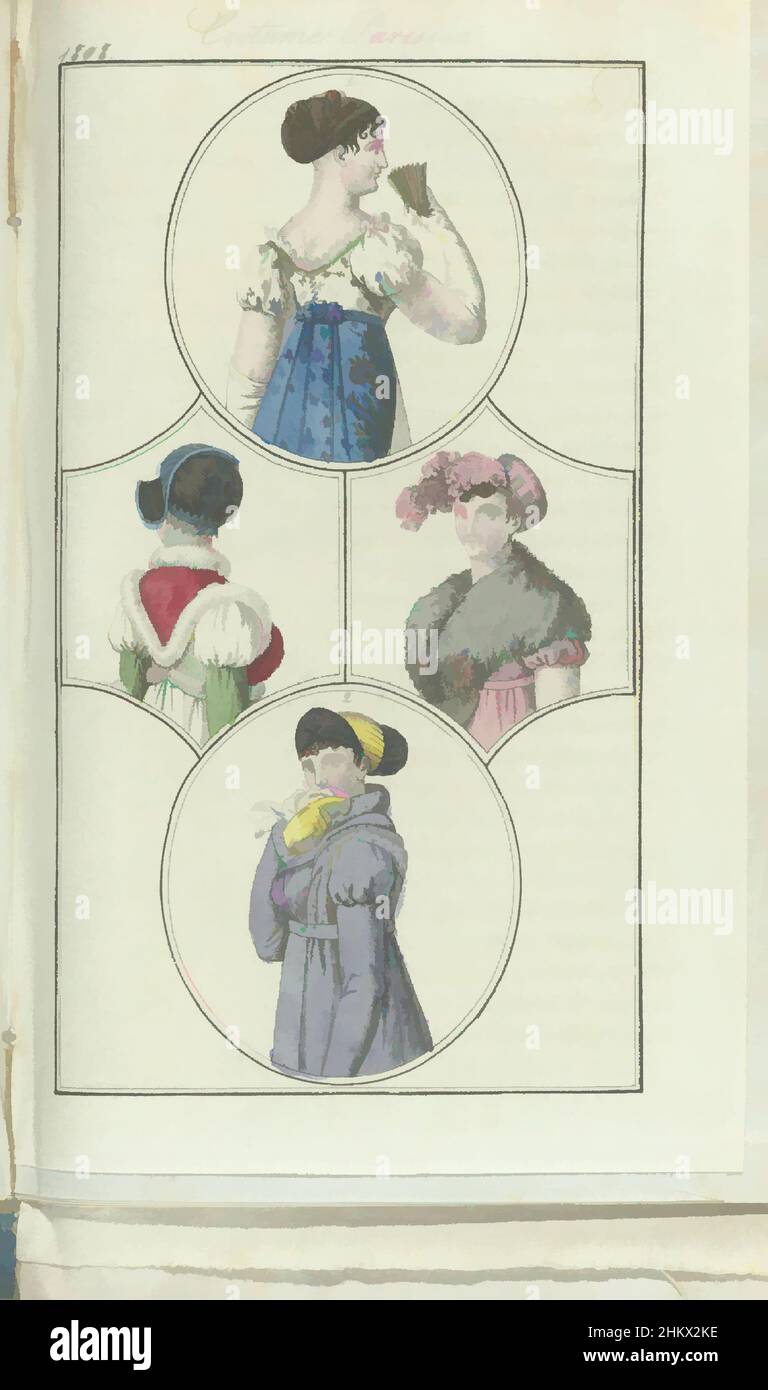 Art inspired by Journal des Dames et des Modes, Frankfurt edition 22 Février 1808, Costume Parisien (8), The accompanying text (pp. 212 and 213) states: Fig. 1: Coiffure de grande parure: gauze of gold thread, braided with hair. Short gown of white satin, embroidered with gold. Blue, Classic works modernized by Artotop with a splash of modernity. Shapes, color and value, eye-catching visual impact on art. Emotions through freedom of artworks in a contemporary way. A timeless message pursuing a wildly creative new direction. Artists turning to the digital medium and creating the Artotop NFT Stock Photohttps://www.alamy.com/image-license-details/?v=1https://www.alamy.com/art-inspired-by-journal-des-dames-et-des-modes-frankfurt-edition-22-fvrier-1808-costume-parisien-8-the-accompanying-text-pp-212-and-213-states-fig-1-coiffure-de-grande-parure-gauze-of-gold-thread-braided-with-hair-short-gown-of-white-satin-embroidered-with-gold-blue-classic-works-modernized-by-artotop-with-a-splash-of-modernity-shapes-color-and-value-eye-catching-visual-impact-on-art-emotions-through-freedom-of-artworks-in-a-contemporary-way-a-timeless-message-pursuing-a-wildly-creative-new-direction-artists-turning-to-the-digital-medium-and-creating-the-artotop-nft-image459720898.html
Art inspired by Journal des Dames et des Modes, Frankfurt edition 22 Février 1808, Costume Parisien (8), The accompanying text (pp. 212 and 213) states: Fig. 1: Coiffure de grande parure: gauze of gold thread, braided with hair. Short gown of white satin, embroidered with gold. Blue, Classic works modernized by Artotop with a splash of modernity. Shapes, color and value, eye-catching visual impact on art. Emotions through freedom of artworks in a contemporary way. A timeless message pursuing a wildly creative new direction. Artists turning to the digital medium and creating the Artotop NFT Stock Photohttps://www.alamy.com/image-license-details/?v=1https://www.alamy.com/art-inspired-by-journal-des-dames-et-des-modes-frankfurt-edition-22-fvrier-1808-costume-parisien-8-the-accompanying-text-pp-212-and-213-states-fig-1-coiffure-de-grande-parure-gauze-of-gold-thread-braided-with-hair-short-gown-of-white-satin-embroidered-with-gold-blue-classic-works-modernized-by-artotop-with-a-splash-of-modernity-shapes-color-and-value-eye-catching-visual-impact-on-art-emotions-through-freedom-of-artworks-in-a-contemporary-way-a-timeless-message-pursuing-a-wildly-creative-new-direction-artists-turning-to-the-digital-medium-and-creating-the-artotop-nft-image459720898.htmlRF2HKX2KE–Art inspired by Journal des Dames et des Modes, Frankfurt edition 22 Février 1808, Costume Parisien (8), The accompanying text (pp. 212 and 213) states: Fig. 1: Coiffure de grande parure: gauze of gold thread, braided with hair. Short gown of white satin, embroidered with gold. Blue, Classic works modernized by Artotop with a splash of modernity. Shapes, color and value, eye-catching visual impact on art. Emotions through freedom of artworks in a contemporary way. A timeless message pursuing a wildly creative new direction. Artists turning to the digital medium and creating the Artotop NFT
 Gallery des Modes et Costumes Français, 1785, no. 1, no. 2, copy to FF 175: Robe a La Turqu (...). Standing woman dressed in a 'robe à laturque'. Jap with short sleeves and contouring long sleeves, underskirt in the same color as the under-sleeves. Around the agent a knotted scarf. Accessories: Hat decorated with flowers, knotted neckerchief, folding fan. Copy to FF 175 from series ff. 30th Cahier de Costumes Français, 23rd Suite d'Habillements à la Mode and 1780, Gallery des Modes et Costumes Français. Stock Photohttps://www.alamy.com/image-license-details/?v=1https://www.alamy.com/gallery-des-modes-et-costumes-franais-1785-no-1-no-2-copy-to-ff-175-robe-a-la-turqu-standing-woman-dressed-in-a-robe-laturque-jap-with-short-sleeves-and-contouring-long-sleeves-underskirt-in-the-same-color-as-the-under-sleeves-around-the-agent-a-knotted-scarf-accessories-hat-decorated-with-flowers-knotted-neckerchief-folding-fan-copy-to-ff-175-from-series-ff-30th-cahier-de-costumes-franais-23rd-suite-dhabillements-la-mode-and-1780-gallery-des-modes-et-costumes-franais-image431557950.html
Gallery des Modes et Costumes Français, 1785, no. 1, no. 2, copy to FF 175: Robe a La Turqu (...). Standing woman dressed in a 'robe à laturque'. Jap with short sleeves and contouring long sleeves, underskirt in the same color as the under-sleeves. Around the agent a knotted scarf. Accessories: Hat decorated with flowers, knotted neckerchief, folding fan. Copy to FF 175 from series ff. 30th Cahier de Costumes Français, 23rd Suite d'Habillements à la Mode and 1780, Gallery des Modes et Costumes Français. Stock Photohttps://www.alamy.com/image-license-details/?v=1https://www.alamy.com/gallery-des-modes-et-costumes-franais-1785-no-1-no-2-copy-to-ff-175-robe-a-la-turqu-standing-woman-dressed-in-a-robe-laturque-jap-with-short-sleeves-and-contouring-long-sleeves-underskirt-in-the-same-color-as-the-under-sleeves-around-the-agent-a-knotted-scarf-accessories-hat-decorated-with-flowers-knotted-neckerchief-folding-fan-copy-to-ff-175-from-series-ff-30th-cahier-de-costumes-franais-23rd-suite-dhabillements-la-mode-and-1780-gallery-des-modes-et-costumes-franais-image431557950.htmlRM2G234FX–Gallery des Modes et Costumes Français, 1785, no. 1, no. 2, copy to FF 175: Robe a La Turqu (...). Standing woman dressed in a 'robe à laturque'. Jap with short sleeves and contouring long sleeves, underskirt in the same color as the under-sleeves. Around the agent a knotted scarf. Accessories: Hat decorated with flowers, knotted neckerchief, folding fan. Copy to FF 175 from series ff. 30th Cahier de Costumes Français, 23rd Suite d'Habillements à la Mode and 1780, Gallery des Modes et Costumes Français.
 Lictor riding in front of consuls, ancient Rome. In galea helmet, tunic, sagulum gregale or short trousers, sandals, with fasces and scutum shield. Licteur a Cheval allant devant les Consuls. Handcoloured copperplate drawn and engraved by L. Labrousse, artist of Bordeaux, under the direction of Jacques Grasset de Saint-Sauveur from his Lantique Rome, ou description historique et pittoresque, Ancient Rome, or historical and picturesque description, Chez Deroy, Paris, 1796. Stock Photohttps://www.alamy.com/image-license-details/?v=1https://www.alamy.com/lictor-riding-in-front-of-consuls-ancient-rome-in-galea-helmet-tunic-sagulum-gregale-or-short-trousers-sandals-with-fasces-and-scutum-shield-licteur-a-cheval-allant-devant-les-consuls-handcoloured-copperplate-drawn-and-engraved-by-l-labrousse-artist-of-bordeaux-under-the-direction-of-jacques-grasset-de-saint-sauveur-from-his-lantique-rome-ou-description-historique-et-pittoresque-ancient-rome-or-historical-and-picturesque-description-chez-deroy-paris-1796-image571831315.html
Lictor riding in front of consuls, ancient Rome. In galea helmet, tunic, sagulum gregale or short trousers, sandals, with fasces and scutum shield. Licteur a Cheval allant devant les Consuls. Handcoloured copperplate drawn and engraved by L. Labrousse, artist of Bordeaux, under the direction of Jacques Grasset de Saint-Sauveur from his Lantique Rome, ou description historique et pittoresque, Ancient Rome, or historical and picturesque description, Chez Deroy, Paris, 1796. Stock Photohttps://www.alamy.com/image-license-details/?v=1https://www.alamy.com/lictor-riding-in-front-of-consuls-ancient-rome-in-galea-helmet-tunic-sagulum-gregale-or-short-trousers-sandals-with-fasces-and-scutum-shield-licteur-a-cheval-allant-devant-les-consuls-handcoloured-copperplate-drawn-and-engraved-by-l-labrousse-artist-of-bordeaux-under-the-direction-of-jacques-grasset-de-saint-sauveur-from-his-lantique-rome-ou-description-historique-et-pittoresque-ancient-rome-or-historical-and-picturesque-description-chez-deroy-paris-1796-image571831315.htmlRM2T694JY–Lictor riding in front of consuls, ancient Rome. In galea helmet, tunic, sagulum gregale or short trousers, sandals, with fasces and scutum shield. Licteur a Cheval allant devant les Consuls. Handcoloured copperplate drawn and engraved by L. Labrousse, artist of Bordeaux, under the direction of Jacques Grasset de Saint-Sauveur from his Lantique Rome, ou description historique et pittoresque, Ancient Rome, or historical and picturesque description, Chez Deroy, Paris, 1796.
![painting, Jacob Toorenvliet, second half 17th or early 18th century, Signature front, right above the shoulder: J. Steen [fake signature], panel, oil paint, painted, Carrier: 34.2 × 28.8 × 2cm 342 × 288 × 20mm , With frame: 48 × 41.5 × 5.5cm 480 × 415 × 55mm, woman, genre, man, genre depicting a woman and a man. On the left, visible to the knees, is a woman used to the right. She rests the right elbow on a pillow, holds a bundle of money in the right hand, and wears a low-cut yellow robe. To her right is a man, who strokes her hair under the chin with his left hand and points to a green Stock Photo painting, Jacob Toorenvliet, second half 17th or early 18th century, Signature front, right above the shoulder: J. Steen [fake signature], panel, oil paint, painted, Carrier: 34.2 × 28.8 × 2cm 342 × 288 × 20mm , With frame: 48 × 41.5 × 5.5cm 480 × 415 × 55mm, woman, genre, man, genre depicting a woman and a man. On the left, visible to the knees, is a woman used to the right. She rests the right elbow on a pillow, holds a bundle of money in the right hand, and wears a low-cut yellow robe. To her right is a man, who strokes her hair under the chin with his left hand and points to a green Stock Photo](https://c8.alamy.com/comp/2DCH7G8/painting-jacob-toorenvliet-second-half-17th-or-early-18th-century-signature-front-right-above-the-shoulder-j-steen-fake-signature-panel-oil-paint-painted-carrier-342-288-2cm-342-288-20mm-with-frame-48-415-55cm-480-415-55mm-woman-genre-man-genre-depicting-a-woman-and-a-man-on-the-left-visible-to-the-knees-is-a-woman-used-to-the-right-she-rests-the-right-elbow-on-a-pillow-holds-a-bundle-of-money-in-the-right-hand-and-wears-a-low-cut-yellow-robe-to-her-right-is-a-man-who-strokes-her-hair-under-the-chin-with-his-left-hand-and-points-to-a-green-2DCH7G8.jpg) painting, Jacob Toorenvliet, second half 17th or early 18th century, Signature front, right above the shoulder: J. Steen [fake signature], panel, oil paint, painted, Carrier: 34.2 × 28.8 × 2cm 342 × 288 × 20mm , With frame: 48 × 41.5 × 5.5cm 480 × 415 × 55mm, woman, genre, man, genre depicting a woman and a man. On the left, visible to the knees, is a woman used to the right. She rests the right elbow on a pillow, holds a bundle of money in the right hand, and wears a low-cut yellow robe. To her right is a man, who strokes her hair under the chin with his left hand and points to a green Stock Photohttps://www.alamy.com/image-license-details/?v=1https://www.alamy.com/painting-jacob-toorenvliet-second-half-17th-or-early-18th-century-signature-front-right-above-the-shoulder-j-steen-fake-signature-panel-oil-paint-painted-carrier-342-288-2cm-342-288-20mm-with-frame-48-415-55cm-480-415-55mm-woman-genre-man-genre-depicting-a-woman-and-a-man-on-the-left-visible-to-the-knees-is-a-woman-used-to-the-right-she-rests-the-right-elbow-on-a-pillow-holds-a-bundle-of-money-in-the-right-hand-and-wears-a-low-cut-yellow-robe-to-her-right-is-a-man-who-strokes-her-hair-under-the-chin-with-his-left-hand-and-points-to-a-green-image386383096.html
painting, Jacob Toorenvliet, second half 17th or early 18th century, Signature front, right above the shoulder: J. Steen [fake signature], panel, oil paint, painted, Carrier: 34.2 × 28.8 × 2cm 342 × 288 × 20mm , With frame: 48 × 41.5 × 5.5cm 480 × 415 × 55mm, woman, genre, man, genre depicting a woman and a man. On the left, visible to the knees, is a woman used to the right. She rests the right elbow on a pillow, holds a bundle of money in the right hand, and wears a low-cut yellow robe. To her right is a man, who strokes her hair under the chin with his left hand and points to a green Stock Photohttps://www.alamy.com/image-license-details/?v=1https://www.alamy.com/painting-jacob-toorenvliet-second-half-17th-or-early-18th-century-signature-front-right-above-the-shoulder-j-steen-fake-signature-panel-oil-paint-painted-carrier-342-288-2cm-342-288-20mm-with-frame-48-415-55cm-480-415-55mm-woman-genre-man-genre-depicting-a-woman-and-a-man-on-the-left-visible-to-the-knees-is-a-woman-used-to-the-right-she-rests-the-right-elbow-on-a-pillow-holds-a-bundle-of-money-in-the-right-hand-and-wears-a-low-cut-yellow-robe-to-her-right-is-a-man-who-strokes-her-hair-under-the-chin-with-his-left-hand-and-points-to-a-green-image386383096.htmlRM2DCH7G8–painting, Jacob Toorenvliet, second half 17th or early 18th century, Signature front, right above the shoulder: J. Steen [fake signature], panel, oil paint, painted, Carrier: 34.2 × 28.8 × 2cm 342 × 288 × 20mm , With frame: 48 × 41.5 × 5.5cm 480 × 415 × 55mm, woman, genre, man, genre depicting a woman and a man. On the left, visible to the knees, is a woman used to the right. She rests the right elbow on a pillow, holds a bundle of money in the right hand, and wears a low-cut yellow robe. To her right is a man, who strokes her hair under the chin with his left hand and points to a green
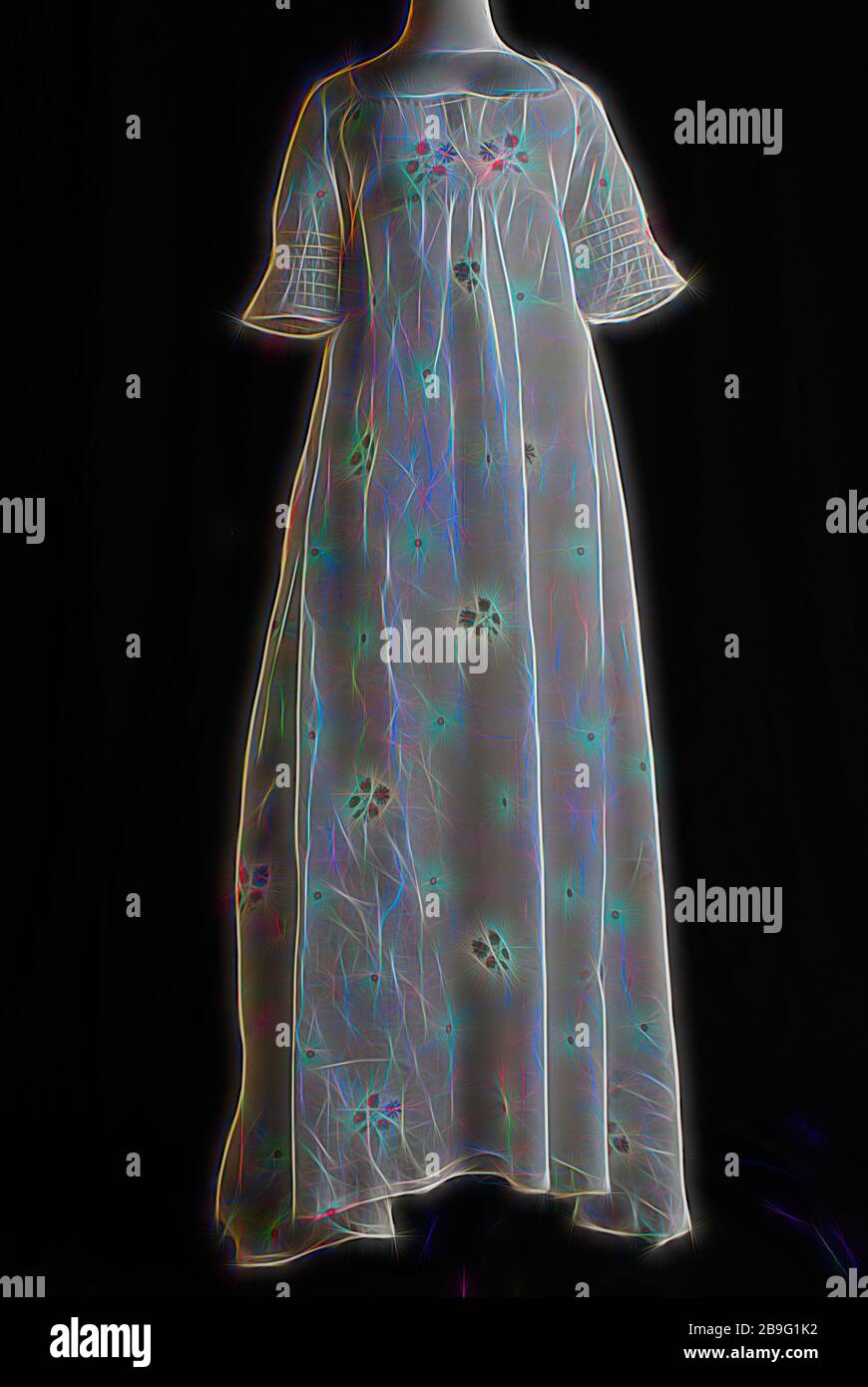 Empire dress of white batiste embroidered with multicolored flower motifs in tambouring, raised waist, short sleeves and wide round neckline, lacing mid back, short trail, robe frock outerwear women's clothing clothes cotton silk metal mid back, shoulder w 25.0 skirt, under w 150.0 sleeve, textile embroidery tambourer work woman Empire Stock Photohttps://www.alamy.com/image-license-details/?v=1https://www.alamy.com/empire-dress-of-white-batiste-embroidered-with-multicolored-flower-motifs-in-tambouring-raised-waist-short-sleeves-and-wide-round-neckline-lacing-mid-back-short-trail-robe-frock-outerwear-womens-clothing-clothes-cotton-silk-metal-mid-back-shoulder-w-250-skirt-under-w-1500-sleeve-textile-embroidery-tambourer-work-woman-empire-image350091814.html
Empire dress of white batiste embroidered with multicolored flower motifs in tambouring, raised waist, short sleeves and wide round neckline, lacing mid back, short trail, robe frock outerwear women's clothing clothes cotton silk metal mid back, shoulder w 25.0 skirt, under w 150.0 sleeve, textile embroidery tambourer work woman Empire Stock Photohttps://www.alamy.com/image-license-details/?v=1https://www.alamy.com/empire-dress-of-white-batiste-embroidered-with-multicolored-flower-motifs-in-tambouring-raised-waist-short-sleeves-and-wide-round-neckline-lacing-mid-back-short-trail-robe-frock-outerwear-womens-clothing-clothes-cotton-silk-metal-mid-back-shoulder-w-250-skirt-under-w-1500-sleeve-textile-embroidery-tambourer-work-woman-empire-image350091814.htmlRF2B9G1K2–Empire dress of white batiste embroidered with multicolored flower motifs in tambouring, raised waist, short sleeves and wide round neckline, lacing mid back, short trail, robe frock outerwear women's clothing clothes cotton silk metal mid back, shoulder w 25.0 skirt, under w 150.0 sleeve, textile embroidery tambourer work woman Empire
 Fashion and Elegance: Fashionable Ladies and Gentlemen of the 1740s. During the early 18th century small series of costume plates reported on the fashion of the day. Women wore the loose-fitting robe volante, also called a ‘sack-backed gown’ in English, over which women sometimes added a short, hooded cloak known as a bagnolette. Men dressed in long coats over a waistcoat and knee-breeches. Pig-tail wigs were adorned with large bows, and tricorne hats were tucked under the arm rather than worn on the head. The two large prints from around 1760 show Parisians out for a stroll. Curiously, the wo Stock Photohttps://www.alamy.com/image-license-details/?v=1https://www.alamy.com/fashion-and-elegance-fashionable-ladies-and-gentlemen-of-the-1740s-during-the-early-18th-century-small-series-of-costume-plates-reported-on-the-fashion-of-the-day-women-wore-the-loose-fitting-robe-volante-also-called-a-sack-backed-gown-in-english-over-which-women-sometimes-added-a-short-hooded-cloak-known-as-a-bagnolette-men-dressed-in-long-coats-over-a-waistcoat-and-knee-breeches-pig-tail-wigs-were-adorned-with-large-bows-and-tricorne-hats-were-tucked-under-the-arm-rather-than-worn-on-the-head-the-two-large-prints-from-around-1760-show-parisians-out-for-a-stroll-curiously-the-wo-image431563896.html
Fashion and Elegance: Fashionable Ladies and Gentlemen of the 1740s. During the early 18th century small series of costume plates reported on the fashion of the day. Women wore the loose-fitting robe volante, also called a ‘sack-backed gown’ in English, over which women sometimes added a short, hooded cloak known as a bagnolette. Men dressed in long coats over a waistcoat and knee-breeches. Pig-tail wigs were adorned with large bows, and tricorne hats were tucked under the arm rather than worn on the head. The two large prints from around 1760 show Parisians out for a stroll. Curiously, the wo Stock Photohttps://www.alamy.com/image-license-details/?v=1https://www.alamy.com/fashion-and-elegance-fashionable-ladies-and-gentlemen-of-the-1740s-during-the-early-18th-century-small-series-of-costume-plates-reported-on-the-fashion-of-the-day-women-wore-the-loose-fitting-robe-volante-also-called-a-sack-backed-gown-in-english-over-which-women-sometimes-added-a-short-hooded-cloak-known-as-a-bagnolette-men-dressed-in-long-coats-over-a-waistcoat-and-knee-breeches-pig-tail-wigs-were-adorned-with-large-bows-and-tricorne-hats-were-tucked-under-the-arm-rather-than-worn-on-the-head-the-two-large-prints-from-around-1760-show-parisians-out-for-a-stroll-curiously-the-wo-image431563896.htmlRM2G23C48–Fashion and Elegance: Fashionable Ladies and Gentlemen of the 1740s. During the early 18th century small series of costume plates reported on the fashion of the day. Women wore the loose-fitting robe volante, also called a ‘sack-backed gown’ in English, over which women sometimes added a short, hooded cloak known as a bagnolette. Men dressed in long coats over a waistcoat and knee-breeches. Pig-tail wigs were adorned with large bows, and tricorne hats were tucked under the arm rather than worn on the head. The two large prints from around 1760 show Parisians out for a stroll. Curiously, the wo
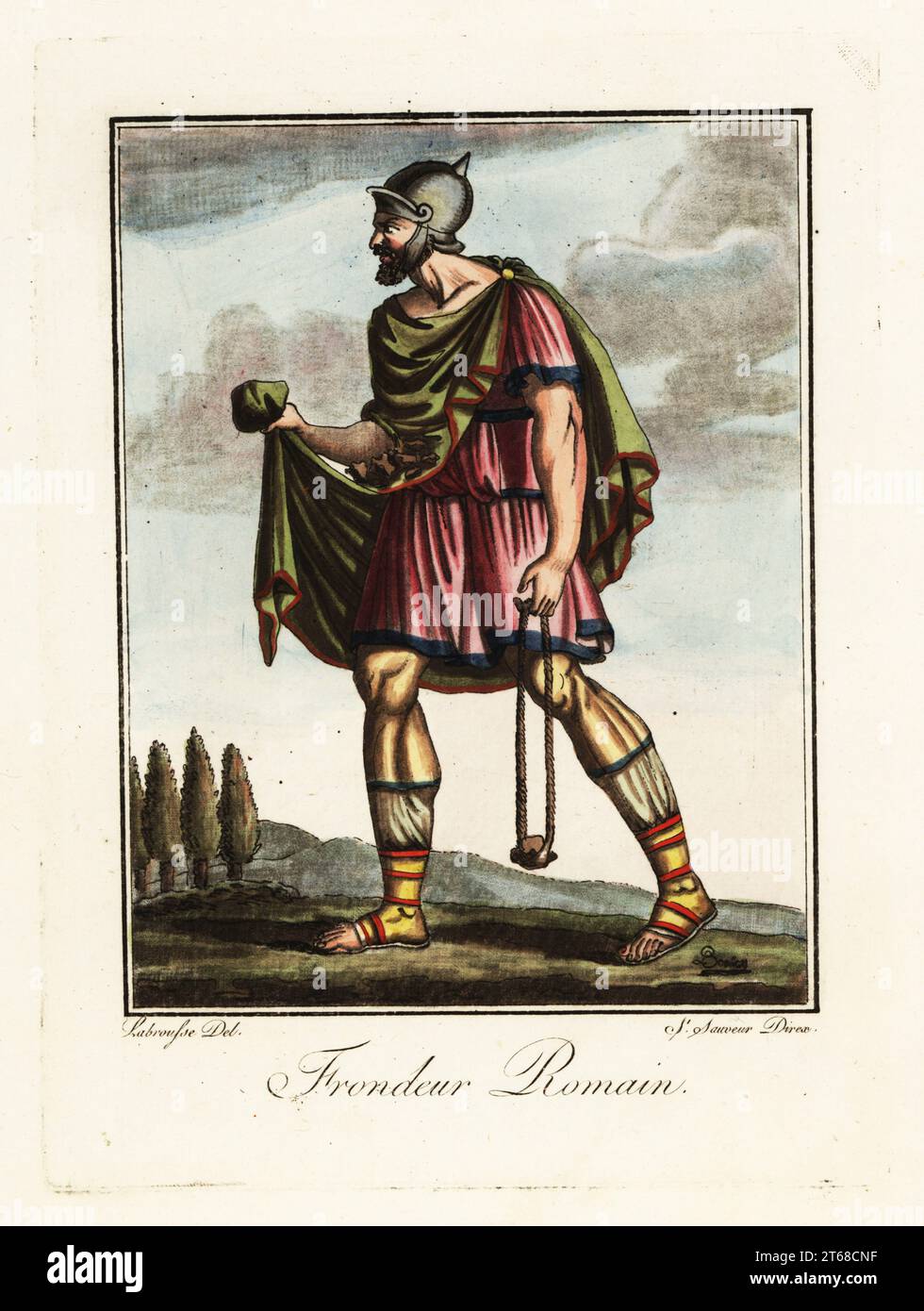 Funditor or slinger in the Roman army, ancient Rome. In galea helmet, cape, tunic, sagulum gregale or short trousers, caligae hobnail sandals, armed with slingshot and stone. Frondeur Romain. Handcoloured copperplate drawn and engraved by L. Labrousse, artist of Bordeaux, under the direction of Jacques Grasset de Saint-Sauveur from his Lantique Rome, ou description historique et pittoresque, Ancient Rome, or historical and picturesque description, Chez Deroy, Paris, 1796. Stock Photohttps://www.alamy.com/image-license-details/?v=1https://www.alamy.com/funditor-or-slinger-in-the-roman-army-ancient-rome-in-galea-helmet-cape-tunic-sagulum-gregale-or-short-trousers-caligae-hobnail-sandals-armed-with-slingshot-and-stone-frondeur-romain-handcoloured-copperplate-drawn-and-engraved-by-l-labrousse-artist-of-bordeaux-under-the-direction-of-jacques-grasset-de-saint-sauveur-from-his-lantique-rome-ou-description-historique-et-pittoresque-ancient-rome-or-historical-and-picturesque-description-chez-deroy-paris-1796-image571815707.html
Funditor or slinger in the Roman army, ancient Rome. In galea helmet, cape, tunic, sagulum gregale or short trousers, caligae hobnail sandals, armed with slingshot and stone. Frondeur Romain. Handcoloured copperplate drawn and engraved by L. Labrousse, artist of Bordeaux, under the direction of Jacques Grasset de Saint-Sauveur from his Lantique Rome, ou description historique et pittoresque, Ancient Rome, or historical and picturesque description, Chez Deroy, Paris, 1796. Stock Photohttps://www.alamy.com/image-license-details/?v=1https://www.alamy.com/funditor-or-slinger-in-the-roman-army-ancient-rome-in-galea-helmet-cape-tunic-sagulum-gregale-or-short-trousers-caligae-hobnail-sandals-armed-with-slingshot-and-stone-frondeur-romain-handcoloured-copperplate-drawn-and-engraved-by-l-labrousse-artist-of-bordeaux-under-the-direction-of-jacques-grasset-de-saint-sauveur-from-his-lantique-rome-ou-description-historique-et-pittoresque-ancient-rome-or-historical-and-picturesque-description-chez-deroy-paris-1796-image571815707.htmlRM2T68CNF–Funditor or slinger in the Roman army, ancient Rome. In galea helmet, cape, tunic, sagulum gregale or short trousers, caligae hobnail sandals, armed with slingshot and stone. Frondeur Romain. Handcoloured copperplate drawn and engraved by L. Labrousse, artist of Bordeaux, under the direction of Jacques Grasset de Saint-Sauveur from his Lantique Rome, ou description historique et pittoresque, Ancient Rome, or historical and picturesque description, Chez Deroy, Paris, 1796.
![painting, Jacob Toorenvliet, second half 17th or early 18th century, Signature front, right above the shoulder: J. Steen [fake signature], panel, oil paint, painted, Carrier: 34.2 × 28.8 × 2cm 342 × 288 × 20mm , With frame: 48 × 41.5 × 5.5cm 480 × 415 × 55mm, woman, genre, man, genre depicting a woman and a man. On the left, visible to the knees, is a woman used to the right. She rests the right elbow on a pillow, holds a bundle of money in the right hand, and wears a low-cut yellow robe. To her right is a man, who strokes her hair under the chin with his left hand and points to a green Stock Photo painting, Jacob Toorenvliet, second half 17th or early 18th century, Signature front, right above the shoulder: J. Steen [fake signature], panel, oil paint, painted, Carrier: 34.2 × 28.8 × 2cm 342 × 288 × 20mm , With frame: 48 × 41.5 × 5.5cm 480 × 415 × 55mm, woman, genre, man, genre depicting a woman and a man. On the left, visible to the knees, is a woman used to the right. She rests the right elbow on a pillow, holds a bundle of money in the right hand, and wears a low-cut yellow robe. To her right is a man, who strokes her hair under the chin with his left hand and points to a green Stock Photo](https://c8.alamy.com/comp/2DCH7FR/painting-jacob-toorenvliet-second-half-17th-or-early-18th-century-signature-front-right-above-the-shoulder-j-steen-fake-signature-panel-oil-paint-painted-carrier-342-288-2cm-342-288-20mm-with-frame-48-415-55cm-480-415-55mm-woman-genre-man-genre-depicting-a-woman-and-a-man-on-the-left-visible-to-the-knees-is-a-woman-used-to-the-right-she-rests-the-right-elbow-on-a-pillow-holds-a-bundle-of-money-in-the-right-hand-and-wears-a-low-cut-yellow-robe-to-her-right-is-a-man-who-strokes-her-hair-under-the-chin-with-his-left-hand-and-points-to-a-green-2DCH7FR.jpg) painting, Jacob Toorenvliet, second half 17th or early 18th century, Signature front, right above the shoulder: J. Steen [fake signature], panel, oil paint, painted, Carrier: 34.2 × 28.8 × 2cm 342 × 288 × 20mm , With frame: 48 × 41.5 × 5.5cm 480 × 415 × 55mm, woman, genre, man, genre depicting a woman and a man. On the left, visible to the knees, is a woman used to the right. She rests the right elbow on a pillow, holds a bundle of money in the right hand, and wears a low-cut yellow robe. To her right is a man, who strokes her hair under the chin with his left hand and points to a green Stock Photohttps://www.alamy.com/image-license-details/?v=1https://www.alamy.com/painting-jacob-toorenvliet-second-half-17th-or-early-18th-century-signature-front-right-above-the-shoulder-j-steen-fake-signature-panel-oil-paint-painted-carrier-342-288-2cm-342-288-20mm-with-frame-48-415-55cm-480-415-55mm-woman-genre-man-genre-depicting-a-woman-and-a-man-on-the-left-visible-to-the-knees-is-a-woman-used-to-the-right-she-rests-the-right-elbow-on-a-pillow-holds-a-bundle-of-money-in-the-right-hand-and-wears-a-low-cut-yellow-robe-to-her-right-is-a-man-who-strokes-her-hair-under-the-chin-with-his-left-hand-and-points-to-a-green-image386383083.html
painting, Jacob Toorenvliet, second half 17th or early 18th century, Signature front, right above the shoulder: J. Steen [fake signature], panel, oil paint, painted, Carrier: 34.2 × 28.8 × 2cm 342 × 288 × 20mm , With frame: 48 × 41.5 × 5.5cm 480 × 415 × 55mm, woman, genre, man, genre depicting a woman and a man. On the left, visible to the knees, is a woman used to the right. She rests the right elbow on a pillow, holds a bundle of money in the right hand, and wears a low-cut yellow robe. To her right is a man, who strokes her hair under the chin with his left hand and points to a green Stock Photohttps://www.alamy.com/image-license-details/?v=1https://www.alamy.com/painting-jacob-toorenvliet-second-half-17th-or-early-18th-century-signature-front-right-above-the-shoulder-j-steen-fake-signature-panel-oil-paint-painted-carrier-342-288-2cm-342-288-20mm-with-frame-48-415-55cm-480-415-55mm-woman-genre-man-genre-depicting-a-woman-and-a-man-on-the-left-visible-to-the-knees-is-a-woman-used-to-the-right-she-rests-the-right-elbow-on-a-pillow-holds-a-bundle-of-money-in-the-right-hand-and-wears-a-low-cut-yellow-robe-to-her-right-is-a-man-who-strokes-her-hair-under-the-chin-with-his-left-hand-and-points-to-a-green-image386383083.htmlRM2DCH7FR–painting, Jacob Toorenvliet, second half 17th or early 18th century, Signature front, right above the shoulder: J. Steen [fake signature], panel, oil paint, painted, Carrier: 34.2 × 28.8 × 2cm 342 × 288 × 20mm , With frame: 48 × 41.5 × 5.5cm 480 × 415 × 55mm, woman, genre, man, genre depicting a woman and a man. On the left, visible to the knees, is a woman used to the right. She rests the right elbow on a pillow, holds a bundle of money in the right hand, and wears a low-cut yellow robe. To her right is a man, who strokes her hair under the chin with his left hand and points to a green
 Catherine of Alexandria, The saint stands on a versatile plinth with the right leg bent over Maxentius. She is staring straight ahead, holding a book on the left and in the right the lost attribute, the sword. A wound pearl band rests on the hair, which falls down in long wavy spots, each ending in a curl. Over a thin undergarment with front and long wide, flared sleeves a robe with short sleeves, with frills, and a round, embroidered neck, it is inserted under the left arm, so that the right shoe point is released. The cloak, with a slip hanging over the left arm, is held together by a double Stock Photohttps://www.alamy.com/image-license-details/?v=1https://www.alamy.com/catherine-of-alexandria-the-saint-stands-on-a-versatile-plinth-with-the-right-leg-bent-over-maxentius-she-is-staring-straight-ahead-holding-a-book-on-the-left-and-in-the-right-the-lost-attribute-the-sword-a-wound-pearl-band-rests-on-the-hair-which-falls-down-in-long-wavy-spots-each-ending-in-a-curl-over-a-thin-undergarment-with-front-and-long-wide-flared-sleeves-a-robe-with-short-sleeves-with-frills-and-a-round-embroidered-neck-it-is-inserted-under-the-left-arm-so-that-the-right-shoe-point-is-released-the-cloak-with-a-slip-hanging-over-the-left-arm-is-held-together-by-a-double-image349968185.html
Catherine of Alexandria, The saint stands on a versatile plinth with the right leg bent over Maxentius. She is staring straight ahead, holding a book on the left and in the right the lost attribute, the sword. A wound pearl band rests on the hair, which falls down in long wavy spots, each ending in a curl. Over a thin undergarment with front and long wide, flared sleeves a robe with short sleeves, with frills, and a round, embroidered neck, it is inserted under the left arm, so that the right shoe point is released. The cloak, with a slip hanging over the left arm, is held together by a double Stock Photohttps://www.alamy.com/image-license-details/?v=1https://www.alamy.com/catherine-of-alexandria-the-saint-stands-on-a-versatile-plinth-with-the-right-leg-bent-over-maxentius-she-is-staring-straight-ahead-holding-a-book-on-the-left-and-in-the-right-the-lost-attribute-the-sword-a-wound-pearl-band-rests-on-the-hair-which-falls-down-in-long-wavy-spots-each-ending-in-a-curl-over-a-thin-undergarment-with-front-and-long-wide-flared-sleeves-a-robe-with-short-sleeves-with-frills-and-a-round-embroidered-neck-it-is-inserted-under-the-left-arm-so-that-the-right-shoe-point-is-released-the-cloak-with-a-slip-hanging-over-the-left-arm-is-held-together-by-a-double-image349968185.htmlRF2B9ABYN–Catherine of Alexandria, The saint stands on a versatile plinth with the right leg bent over Maxentius. She is staring straight ahead, holding a book on the left and in the right the lost attribute, the sword. A wound pearl band rests on the hair, which falls down in long wavy spots, each ending in a curl. Over a thin undergarment with front and long wide, flared sleeves a robe with short sleeves, with frills, and a round, embroidered neck, it is inserted under the left arm, so that the right shoe point is released. The cloak, with a slip hanging over the left arm, is held together by a double
 Fashion and Elegance: Hooded Cloaks Men’s Wigs. During the early 18th century small series of costume plates reported on the fashion of the day. Women wore the loose-fitting robe volante, also called a ‘sack-backed gown’ in English, over which women sometimes added a short, hooded cloak known as a bagnolette. Men dressed in long coats over a waistcoat and knee-breeches. Pig-tail wigs were adorned with large bows, and tricorne hats were tucked under the arm rather than worn on the head. The two large prints from around 1760 show Parisians out for a stroll. Curiously, the women wear wide paniers Stock Photohttps://www.alamy.com/image-license-details/?v=1https://www.alamy.com/fashion-and-elegance-hooded-cloaks-mens-wigs-during-the-early-18th-century-small-series-of-costume-plates-reported-on-the-fashion-of-the-day-women-wore-the-loose-fitting-robe-volante-also-called-a-sack-backed-gown-in-english-over-which-women-sometimes-added-a-short-hooded-cloak-known-as-a-bagnolette-men-dressed-in-long-coats-over-a-waistcoat-and-knee-breeches-pig-tail-wigs-were-adorned-with-large-bows-and-tricorne-hats-were-tucked-under-the-arm-rather-than-worn-on-the-head-the-two-large-prints-from-around-1760-show-parisians-out-for-a-stroll-curiously-the-women-wear-wide-paniers-image431558664.html
Fashion and Elegance: Hooded Cloaks Men’s Wigs. During the early 18th century small series of costume plates reported on the fashion of the day. Women wore the loose-fitting robe volante, also called a ‘sack-backed gown’ in English, over which women sometimes added a short, hooded cloak known as a bagnolette. Men dressed in long coats over a waistcoat and knee-breeches. Pig-tail wigs were adorned with large bows, and tricorne hats were tucked under the arm rather than worn on the head. The two large prints from around 1760 show Parisians out for a stroll. Curiously, the women wear wide paniers Stock Photohttps://www.alamy.com/image-license-details/?v=1https://www.alamy.com/fashion-and-elegance-hooded-cloaks-mens-wigs-during-the-early-18th-century-small-series-of-costume-plates-reported-on-the-fashion-of-the-day-women-wore-the-loose-fitting-robe-volante-also-called-a-sack-backed-gown-in-english-over-which-women-sometimes-added-a-short-hooded-cloak-known-as-a-bagnolette-men-dressed-in-long-coats-over-a-waistcoat-and-knee-breeches-pig-tail-wigs-were-adorned-with-large-bows-and-tricorne-hats-were-tucked-under-the-arm-rather-than-worn-on-the-head-the-two-large-prints-from-around-1760-show-parisians-out-for-a-stroll-curiously-the-women-wear-wide-paniers-image431558664.htmlRM2G235DC–Fashion and Elegance: Hooded Cloaks Men’s Wigs. During the early 18th century small series of costume plates reported on the fashion of the day. Women wore the loose-fitting robe volante, also called a ‘sack-backed gown’ in English, over which women sometimes added a short, hooded cloak known as a bagnolette. Men dressed in long coats over a waistcoat and knee-breeches. Pig-tail wigs were adorned with large bows, and tricorne hats were tucked under the arm rather than worn on the head. The two large prints from around 1760 show Parisians out for a stroll. Curiously, the women wear wide paniers
 Costume of a mounted archer, ancient Rome. In galea or helmet, tunic, short trousers or sagulum gregale, sandals, armed with bow, arrows and quiver. Cavalier-Archer chez les Romains. Handcoloured copperplate drawn and engraved by L. Labrousse, artist of Bordeaux, under the direction of Jacques Grasset de Saint-Sauveur from his Lantique Rome, ou description historique et pittoresque, Ancient Rome, or historical and picturesque description, Chez Deroy, Paris, 1796. Stock Photohttps://www.alamy.com/image-license-details/?v=1https://www.alamy.com/costume-of-a-mounted-archer-ancient-rome-in-galea-or-helmet-tunic-short-trousers-or-sagulum-gregale-sandals-armed-with-bow-arrows-and-quiver-cavalier-archer-chez-les-romains-handcoloured-copperplate-drawn-and-engraved-by-l-labrousse-artist-of-bordeaux-under-the-direction-of-jacques-grasset-de-saint-sauveur-from-his-lantique-rome-ou-description-historique-et-pittoresque-ancient-rome-or-historical-and-picturesque-description-chez-deroy-paris-1796-image571824292.html
Costume of a mounted archer, ancient Rome. In galea or helmet, tunic, short trousers or sagulum gregale, sandals, armed with bow, arrows and quiver. Cavalier-Archer chez les Romains. Handcoloured copperplate drawn and engraved by L. Labrousse, artist of Bordeaux, under the direction of Jacques Grasset de Saint-Sauveur from his Lantique Rome, ou description historique et pittoresque, Ancient Rome, or historical and picturesque description, Chez Deroy, Paris, 1796. Stock Photohttps://www.alamy.com/image-license-details/?v=1https://www.alamy.com/costume-of-a-mounted-archer-ancient-rome-in-galea-or-helmet-tunic-short-trousers-or-sagulum-gregale-sandals-armed-with-bow-arrows-and-quiver-cavalier-archer-chez-les-romains-handcoloured-copperplate-drawn-and-engraved-by-l-labrousse-artist-of-bordeaux-under-the-direction-of-jacques-grasset-de-saint-sauveur-from-his-lantique-rome-ou-description-historique-et-pittoresque-ancient-rome-or-historical-and-picturesque-description-chez-deroy-paris-1796-image571824292.htmlRM2T68RM4–Costume of a mounted archer, ancient Rome. In galea or helmet, tunic, short trousers or sagulum gregale, sandals, armed with bow, arrows and quiver. Cavalier-Archer chez les Romains. Handcoloured copperplate drawn and engraved by L. Labrousse, artist of Bordeaux, under the direction of Jacques Grasset de Saint-Sauveur from his Lantique Rome, ou description historique et pittoresque, Ancient Rome, or historical and picturesque description, Chez Deroy, Paris, 1796.
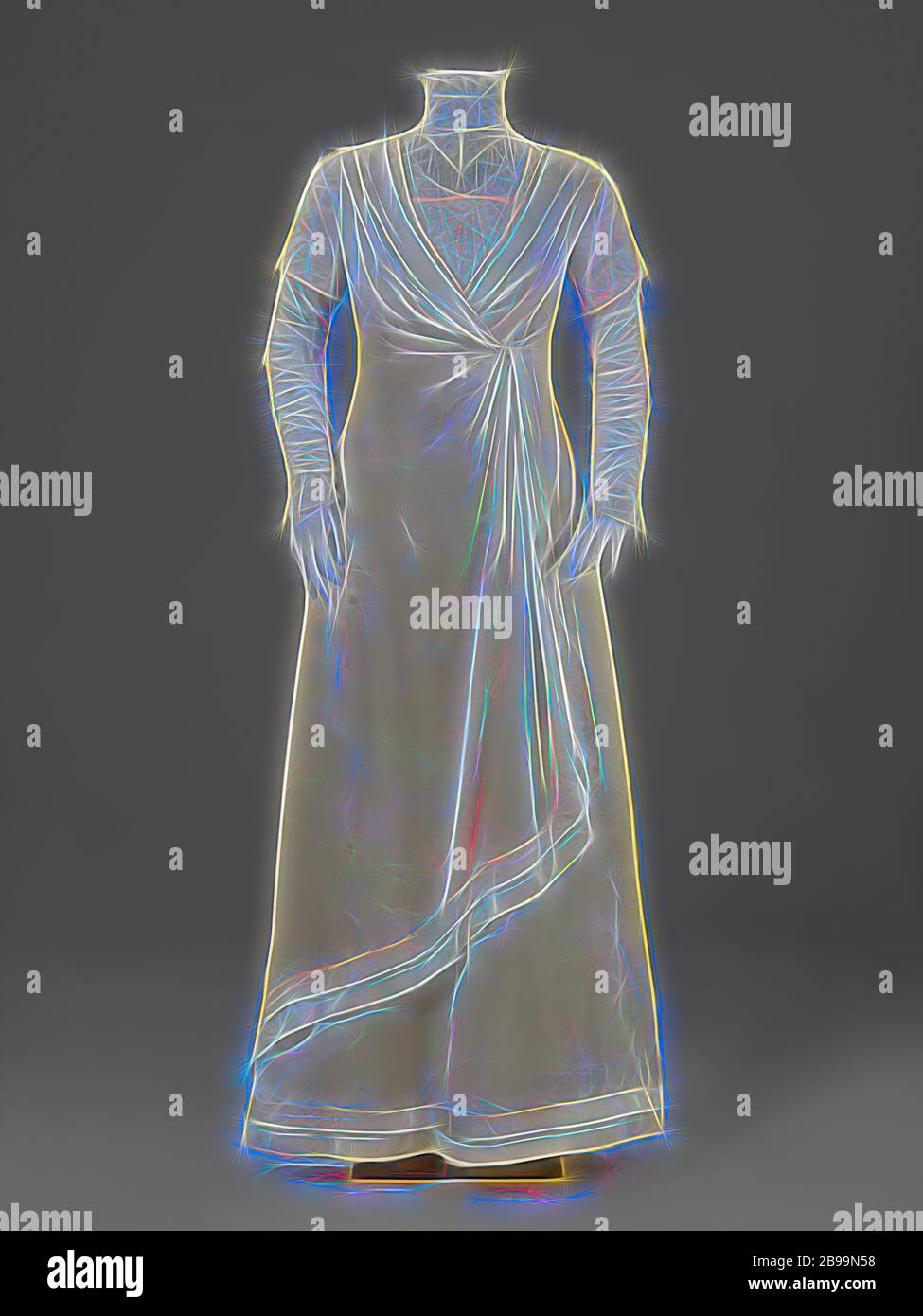 Wedding dress with embroidered and ruffled double sleeves, White satin bridal gown with gaze de soie and bobbin lace, consisting of a frock (a), an underskirt (b) and matching shoes (c, d) of white glacé leather, white satin bridal gown with gaze de soie and bobbin lace, a underskirt (b) and matching shoes (c, d) of white glacé leather. Model (a): Robe princesse or Tanagré enne with a dragged-on trail. Front: the closure is hidden under a diagonally flipped tunic-shaped wrap. Deep v-neck with a low satin cardigan and a high second cardigan from gaze de soie and lace (18th century Mechelen bobb Stock Photohttps://www.alamy.com/image-license-details/?v=1https://www.alamy.com/wedding-dress-with-embroidered-and-ruffled-double-sleeves-white-satin-bridal-gown-with-gaze-de-soie-and-bobbin-lace-consisting-of-a-frock-a-an-underskirt-b-and-matching-shoes-c-d-of-white-glac-leather-white-satin-bridal-gown-with-gaze-de-soie-and-bobbin-lace-a-underskirt-b-and-matching-shoes-c-d-of-white-glac-leather-model-a-robe-princesse-or-tanagr-enne-with-a-dragged-on-trail-front-the-closure-is-hidden-under-a-diagonally-flipped-tunic-shaped-wrap-deep-v-neck-with-a-low-satin-cardigan-and-a-high-second-cardigan-from-gaze-de-soie-and-lace-18th-century-mechelen-bobb-image349953444.html
Wedding dress with embroidered and ruffled double sleeves, White satin bridal gown with gaze de soie and bobbin lace, consisting of a frock (a), an underskirt (b) and matching shoes (c, d) of white glacé leather, white satin bridal gown with gaze de soie and bobbin lace, a underskirt (b) and matching shoes (c, d) of white glacé leather. Model (a): Robe princesse or Tanagré enne with a dragged-on trail. Front: the closure is hidden under a diagonally flipped tunic-shaped wrap. Deep v-neck with a low satin cardigan and a high second cardigan from gaze de soie and lace (18th century Mechelen bobb Stock Photohttps://www.alamy.com/image-license-details/?v=1https://www.alamy.com/wedding-dress-with-embroidered-and-ruffled-double-sleeves-white-satin-bridal-gown-with-gaze-de-soie-and-bobbin-lace-consisting-of-a-frock-a-an-underskirt-b-and-matching-shoes-c-d-of-white-glac-leather-white-satin-bridal-gown-with-gaze-de-soie-and-bobbin-lace-a-underskirt-b-and-matching-shoes-c-d-of-white-glac-leather-model-a-robe-princesse-or-tanagr-enne-with-a-dragged-on-trail-front-the-closure-is-hidden-under-a-diagonally-flipped-tunic-shaped-wrap-deep-v-neck-with-a-low-satin-cardigan-and-a-high-second-cardigan-from-gaze-de-soie-and-lace-18th-century-mechelen-bobb-image349953444.htmlRF2B99N58–Wedding dress with embroidered and ruffled double sleeves, White satin bridal gown with gaze de soie and bobbin lace, consisting of a frock (a), an underskirt (b) and matching shoes (c, d) of white glacé leather, white satin bridal gown with gaze de soie and bobbin lace, a underskirt (b) and matching shoes (c, d) of white glacé leather. Model (a): Robe princesse or Tanagré enne with a dragged-on trail. Front: the closure is hidden under a diagonally flipped tunic-shaped wrap. Deep v-neck with a low satin cardigan and a high second cardigan from gaze de soie and lace (18th century Mechelen bobb
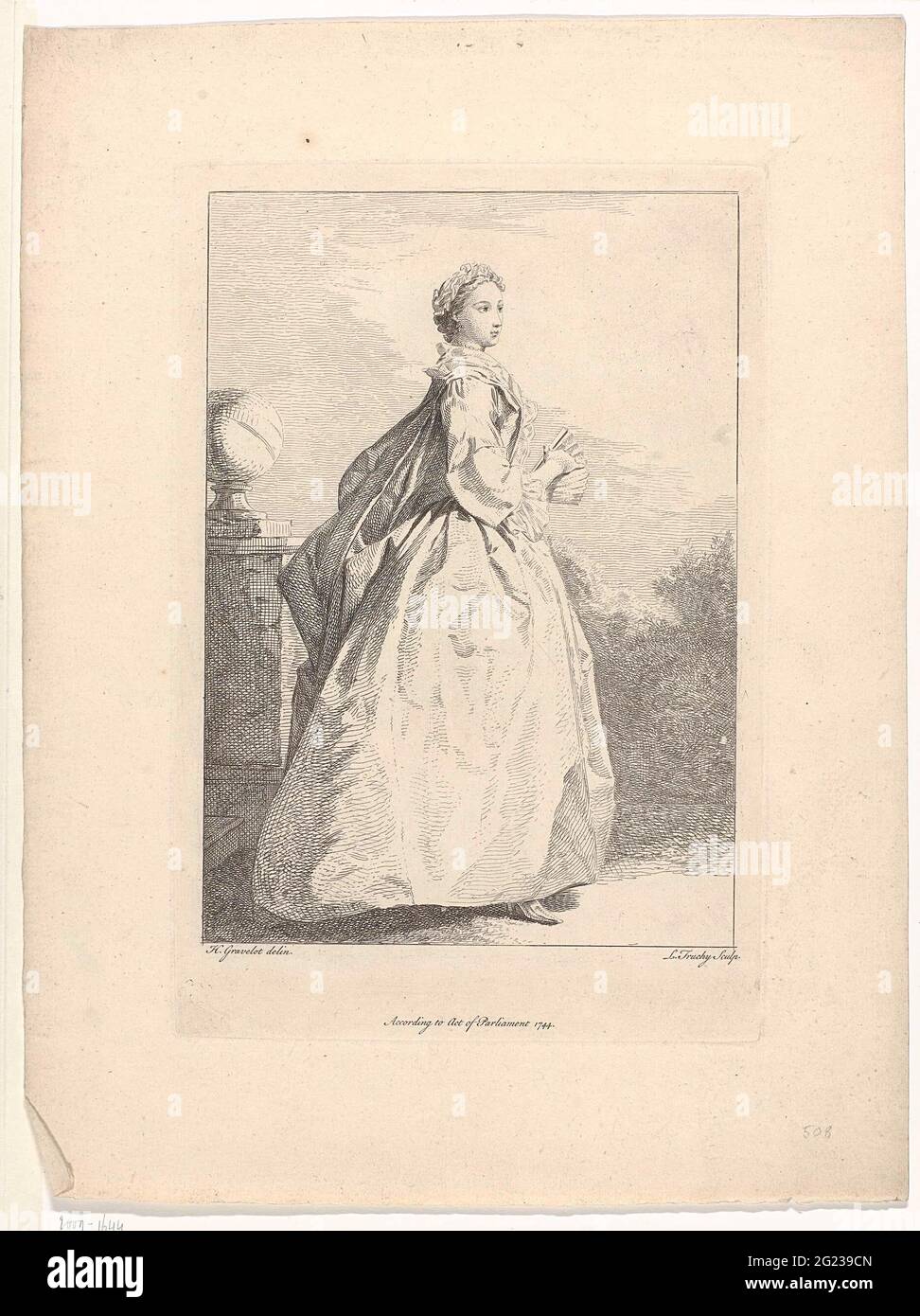 Fashion and Elegance: Fashionable Ladies and Gentlemen of the 1740s. During the early 18th century small series of costume plates reported on the fashion of the day. Women wore the loose-fitting robe volante, also called a ‘sack-backed gown’ in English, over which women sometimes added a short, hooded cloak known as a bagnolette. Men dressed in long coats over a waistcoat and knee-breeches. Pig-tail wigs were adorned with large bows, and tricorne hats were tucked under the arm rather than worn on the head. The two large prints from around 1760 show Parisians out for a stroll. Curiously, the wo Stock Photohttps://www.alamy.com/image-license-details/?v=1https://www.alamy.com/fashion-and-elegance-fashionable-ladies-and-gentlemen-of-the-1740s-during-the-early-18th-century-small-series-of-costume-plates-reported-on-the-fashion-of-the-day-women-wore-the-loose-fitting-robe-volante-also-called-a-sack-backed-gown-in-english-over-which-women-sometimes-added-a-short-hooded-cloak-known-as-a-bagnolette-men-dressed-in-long-coats-over-a-waistcoat-and-knee-breeches-pig-tail-wigs-were-adorned-with-large-bows-and-tricorne-hats-were-tucked-under-the-arm-rather-than-worn-on-the-head-the-two-large-prints-from-around-1760-show-parisians-out-for-a-stroll-curiously-the-wo-image431561781.html
Fashion and Elegance: Fashionable Ladies and Gentlemen of the 1740s. During the early 18th century small series of costume plates reported on the fashion of the day. Women wore the loose-fitting robe volante, also called a ‘sack-backed gown’ in English, over which women sometimes added a short, hooded cloak known as a bagnolette. Men dressed in long coats over a waistcoat and knee-breeches. Pig-tail wigs were adorned with large bows, and tricorne hats were tucked under the arm rather than worn on the head. The two large prints from around 1760 show Parisians out for a stroll. Curiously, the wo Stock Photohttps://www.alamy.com/image-license-details/?v=1https://www.alamy.com/fashion-and-elegance-fashionable-ladies-and-gentlemen-of-the-1740s-during-the-early-18th-century-small-series-of-costume-plates-reported-on-the-fashion-of-the-day-women-wore-the-loose-fitting-robe-volante-also-called-a-sack-backed-gown-in-english-over-which-women-sometimes-added-a-short-hooded-cloak-known-as-a-bagnolette-men-dressed-in-long-coats-over-a-waistcoat-and-knee-breeches-pig-tail-wigs-were-adorned-with-large-bows-and-tricorne-hats-were-tucked-under-the-arm-rather-than-worn-on-the-head-the-two-large-prints-from-around-1760-show-parisians-out-for-a-stroll-curiously-the-wo-image431561781.htmlRM2G239CN–Fashion and Elegance: Fashionable Ladies and Gentlemen of the 1740s. During the early 18th century small series of costume plates reported on the fashion of the day. Women wore the loose-fitting robe volante, also called a ‘sack-backed gown’ in English, over which women sometimes added a short, hooded cloak known as a bagnolette. Men dressed in long coats over a waistcoat and knee-breeches. Pig-tail wigs were adorned with large bows, and tricorne hats were tucked under the arm rather than worn on the head. The two large prints from around 1760 show Parisians out for a stroll. Curiously, the wo
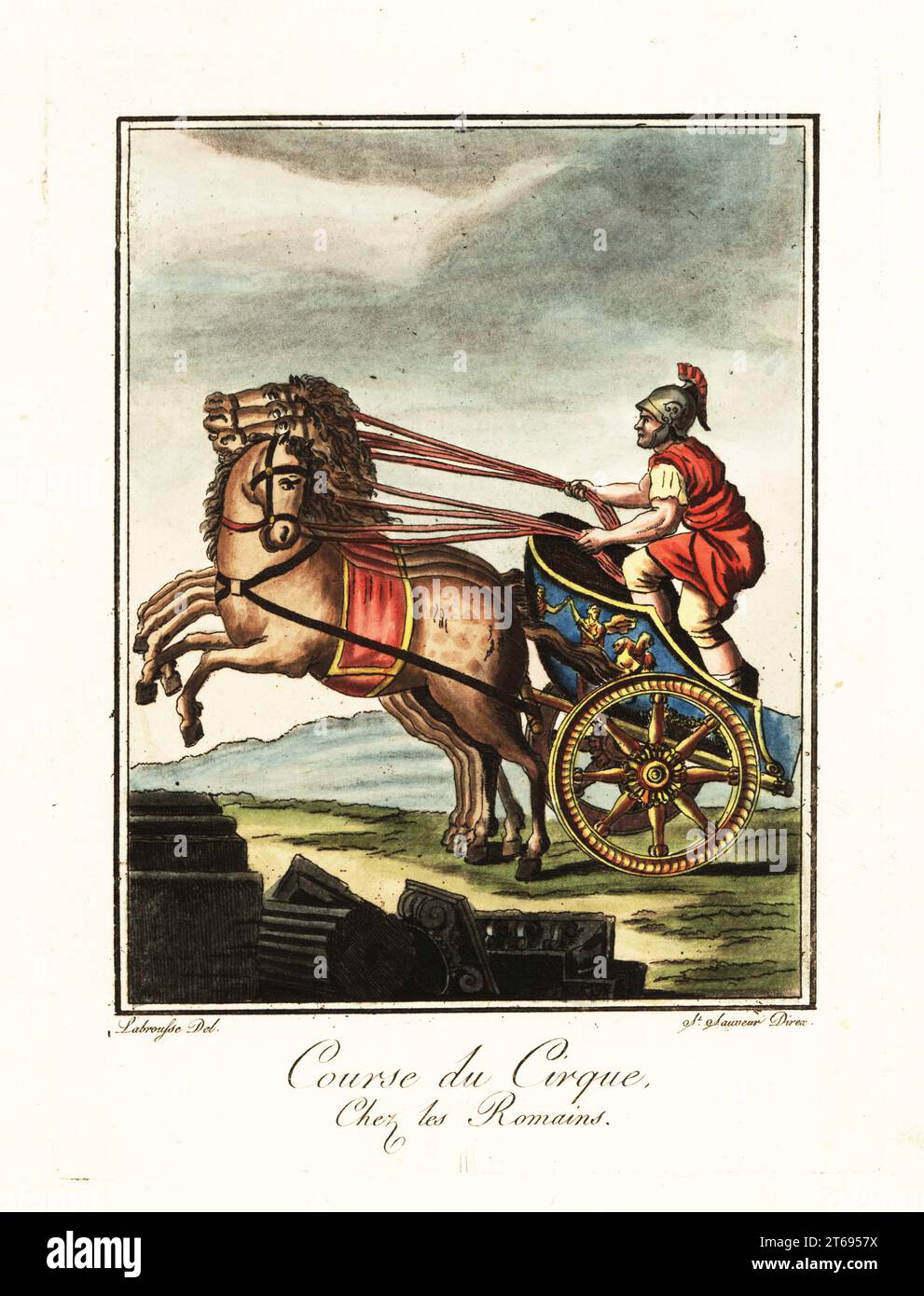 Charioteer racing at the circus, ancient Rome. In helmet, tunic, and sagulum gregale or short trousers, riding a four-horse chariot or quadriga. Course du Cirque chez les Romains. Handcoloured copperplate drawn and engraved by L. Labrousse, artist of Bordeaux, under the direction of Jacques Grasset de Saint-Sauveur from his Lantique Rome, ou description historique et pittoresque, Ancient Rome, or historical and picturesque description, Chez Deroy, Paris, 1796. Stock Photohttps://www.alamy.com/image-license-details/?v=1https://www.alamy.com/charioteer-racing-at-the-circus-ancient-rome-in-helmet-tunic-and-sagulum-gregale-or-short-trousers-riding-a-four-horse-chariot-or-quadriga-course-du-cirque-chez-les-romains-handcoloured-copperplate-drawn-and-engraved-by-l-labrousse-artist-of-bordeaux-under-the-direction-of-jacques-grasset-de-saint-sauveur-from-his-lantique-rome-ou-description-historique-et-pittoresque-ancient-rome-or-historical-and-picturesque-description-chez-deroy-paris-1796-image571831790.html
Charioteer racing at the circus, ancient Rome. In helmet, tunic, and sagulum gregale or short trousers, riding a four-horse chariot or quadriga. Course du Cirque chez les Romains. Handcoloured copperplate drawn and engraved by L. Labrousse, artist of Bordeaux, under the direction of Jacques Grasset de Saint-Sauveur from his Lantique Rome, ou description historique et pittoresque, Ancient Rome, or historical and picturesque description, Chez Deroy, Paris, 1796. Stock Photohttps://www.alamy.com/image-license-details/?v=1https://www.alamy.com/charioteer-racing-at-the-circus-ancient-rome-in-helmet-tunic-and-sagulum-gregale-or-short-trousers-riding-a-four-horse-chariot-or-quadriga-course-du-cirque-chez-les-romains-handcoloured-copperplate-drawn-and-engraved-by-l-labrousse-artist-of-bordeaux-under-the-direction-of-jacques-grasset-de-saint-sauveur-from-his-lantique-rome-ou-description-historique-et-pittoresque-ancient-rome-or-historical-and-picturesque-description-chez-deroy-paris-1796-image571831790.htmlRM2T6957X–Charioteer racing at the circus, ancient Rome. In helmet, tunic, and sagulum gregale or short trousers, riding a four-horse chariot or quadriga. Course du Cirque chez les Romains. Handcoloured copperplate drawn and engraved by L. Labrousse, artist of Bordeaux, under the direction of Jacques Grasset de Saint-Sauveur from his Lantique Rome, ou description historique et pittoresque, Ancient Rome, or historical and picturesque description, Chez Deroy, Paris, 1796.
 Fashion and Elegance: Fashionable Ladies and Gentlemen of the 1740s. During the early 18th century small series of costume plates reported on the fashion of the day. Women wore the loose-fitting robe volante, also called a ‘sack-backed gown’ in English, over which women sometimes added a short, hooded cloak known as a bagnolette. Men dressed in long coats over a waistcoat and knee-breeches. Pig-tail wigs were adorned with large bows, and tricorne hats were tucked under the arm rather than worn on the head. The two large prints from around 1760 show Parisians out for a stroll. Curiously, the wo Stock Photohttps://www.alamy.com/image-license-details/?v=1https://www.alamy.com/fashion-and-elegance-fashionable-ladies-and-gentlemen-of-the-1740s-during-the-early-18th-century-small-series-of-costume-plates-reported-on-the-fashion-of-the-day-women-wore-the-loose-fitting-robe-volante-also-called-a-sack-backed-gown-in-english-over-which-women-sometimes-added-a-short-hooded-cloak-known-as-a-bagnolette-men-dressed-in-long-coats-over-a-waistcoat-and-knee-breeches-pig-tail-wigs-were-adorned-with-large-bows-and-tricorne-hats-were-tucked-under-the-arm-rather-than-worn-on-the-head-the-two-large-prints-from-around-1760-show-parisians-out-for-a-stroll-curiously-the-wo-image431556548.html
Fashion and Elegance: Fashionable Ladies and Gentlemen of the 1740s. During the early 18th century small series of costume plates reported on the fashion of the day. Women wore the loose-fitting robe volante, also called a ‘sack-backed gown’ in English, over which women sometimes added a short, hooded cloak known as a bagnolette. Men dressed in long coats over a waistcoat and knee-breeches. Pig-tail wigs were adorned with large bows, and tricorne hats were tucked under the arm rather than worn on the head. The two large prints from around 1760 show Parisians out for a stroll. Curiously, the wo Stock Photohttps://www.alamy.com/image-license-details/?v=1https://www.alamy.com/fashion-and-elegance-fashionable-ladies-and-gentlemen-of-the-1740s-during-the-early-18th-century-small-series-of-costume-plates-reported-on-the-fashion-of-the-day-women-wore-the-loose-fitting-robe-volante-also-called-a-sack-backed-gown-in-english-over-which-women-sometimes-added-a-short-hooded-cloak-known-as-a-bagnolette-men-dressed-in-long-coats-over-a-waistcoat-and-knee-breeches-pig-tail-wigs-were-adorned-with-large-bows-and-tricorne-hats-were-tucked-under-the-arm-rather-than-worn-on-the-head-the-two-large-prints-from-around-1760-show-parisians-out-for-a-stroll-curiously-the-wo-image431556548.htmlRM2G232NT–Fashion and Elegance: Fashionable Ladies and Gentlemen of the 1740s. During the early 18th century small series of costume plates reported on the fashion of the day. Women wore the loose-fitting robe volante, also called a ‘sack-backed gown’ in English, over which women sometimes added a short, hooded cloak known as a bagnolette. Men dressed in long coats over a waistcoat and knee-breeches. Pig-tail wigs were adorned with large bows, and tricorne hats were tucked under the arm rather than worn on the head. The two large prints from around 1760 show Parisians out for a stroll. Curiously, the wo
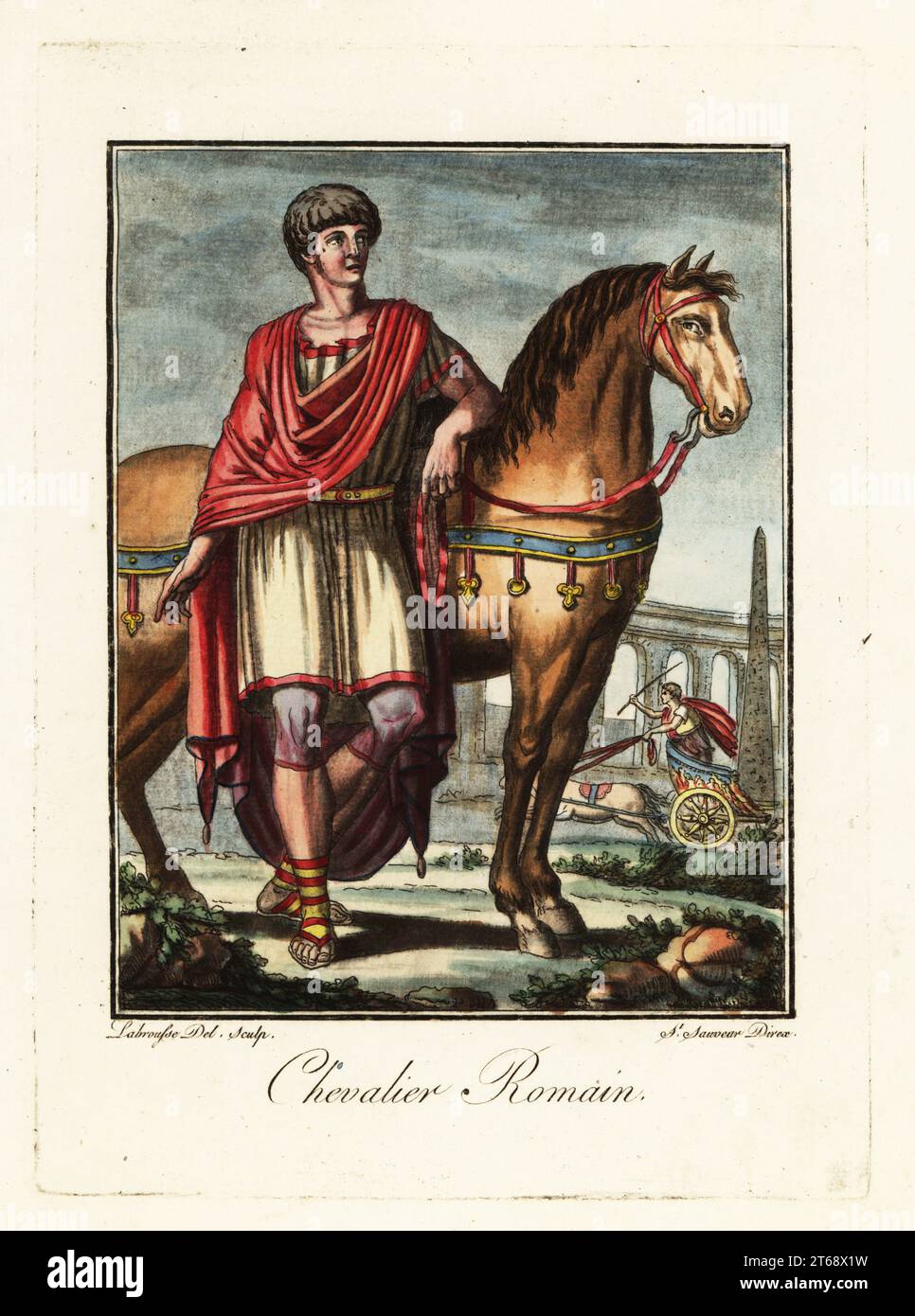 Roman knight or princeps iuventutis, ancient Rome. Wearing a paludamentum cloak, tunic, short trousers or sagulum gregale, and sandals. A charioteer in a biga riding in front of an obelisk and acqueduct behind. Chevalier Romain. Handcoloured copperplate drawn and engraved by L. Labrousse, artist of Bordeaux, under the direction of Jacques Grasset de Saint-Sauveur from his Lantique Rome, ou description historique et pittoresque, Ancient Rome, or historical and picturesque description, Chez Deroy, Paris, 1796. Stock Photohttps://www.alamy.com/image-license-details/?v=1https://www.alamy.com/roman-knight-or-princeps-iuventutis-ancient-rome-wearing-a-paludamentum-cloak-tunic-short-trousers-or-sagulum-gregale-and-sandals-a-charioteer-in-a-biga-riding-in-front-of-an-obelisk-and-acqueduct-behind-chevalier-romain-handcoloured-copperplate-drawn-and-engraved-by-l-labrousse-artist-of-bordeaux-under-the-direction-of-jacques-grasset-de-saint-sauveur-from-his-lantique-rome-ou-description-historique-et-pittoresque-ancient-rome-or-historical-and-picturesque-description-chez-deroy-paris-1796-image571826133.html
Roman knight or princeps iuventutis, ancient Rome. Wearing a paludamentum cloak, tunic, short trousers or sagulum gregale, and sandals. A charioteer in a biga riding in front of an obelisk and acqueduct behind. Chevalier Romain. Handcoloured copperplate drawn and engraved by L. Labrousse, artist of Bordeaux, under the direction of Jacques Grasset de Saint-Sauveur from his Lantique Rome, ou description historique et pittoresque, Ancient Rome, or historical and picturesque description, Chez Deroy, Paris, 1796. Stock Photohttps://www.alamy.com/image-license-details/?v=1https://www.alamy.com/roman-knight-or-princeps-iuventutis-ancient-rome-wearing-a-paludamentum-cloak-tunic-short-trousers-or-sagulum-gregale-and-sandals-a-charioteer-in-a-biga-riding-in-front-of-an-obelisk-and-acqueduct-behind-chevalier-romain-handcoloured-copperplate-drawn-and-engraved-by-l-labrousse-artist-of-bordeaux-under-the-direction-of-jacques-grasset-de-saint-sauveur-from-his-lantique-rome-ou-description-historique-et-pittoresque-ancient-rome-or-historical-and-picturesque-description-chez-deroy-paris-1796-image571826133.htmlRM2T68X1W–Roman knight or princeps iuventutis, ancient Rome. Wearing a paludamentum cloak, tunic, short trousers or sagulum gregale, and sandals. A charioteer in a biga riding in front of an obelisk and acqueduct behind. Chevalier Romain. Handcoloured copperplate drawn and engraved by L. Labrousse, artist of Bordeaux, under the direction of Jacques Grasset de Saint-Sauveur from his Lantique Rome, ou description historique et pittoresque, Ancient Rome, or historical and picturesque description, Chez Deroy, Paris, 1796.
 Fashion and Elegance: Fashionable Ladies and Gentlemen of the 1740s. During the early 18th century small series of costume plates reported on the fashion of the day. Women wore the loose-fitting robe volante, also called a ‘sack-backed gown’ in English, over which women sometimes added a short, hooded cloak known as a bagnolette. Men dressed in long coats over a waistcoat and knee-breeches. Pig-tail wigs were adorned with large bows, and tricorne hats were tucked under the arm rather than worn on the head. The two large prints from around 1760 show Parisians out for a stroll. Curiously, the wo Stock Photohttps://www.alamy.com/image-license-details/?v=1https://www.alamy.com/fashion-and-elegance-fashionable-ladies-and-gentlemen-of-the-1740s-during-the-early-18th-century-small-series-of-costume-plates-reported-on-the-fashion-of-the-day-women-wore-the-loose-fitting-robe-volante-also-called-a-sack-backed-gown-in-english-over-which-women-sometimes-added-a-short-hooded-cloak-known-as-a-bagnolette-men-dressed-in-long-coats-over-a-waistcoat-and-knee-breeches-pig-tail-wigs-were-adorned-with-large-bows-and-tricorne-hats-were-tucked-under-the-arm-rather-than-worn-on-the-head-the-two-large-prints-from-around-1760-show-parisians-out-for-a-stroll-curiously-the-wo-image431557183.html
Fashion and Elegance: Fashionable Ladies and Gentlemen of the 1740s. During the early 18th century small series of costume plates reported on the fashion of the day. Women wore the loose-fitting robe volante, also called a ‘sack-backed gown’ in English, over which women sometimes added a short, hooded cloak known as a bagnolette. Men dressed in long coats over a waistcoat and knee-breeches. Pig-tail wigs were adorned with large bows, and tricorne hats were tucked under the arm rather than worn on the head. The two large prints from around 1760 show Parisians out for a stroll. Curiously, the wo Stock Photohttps://www.alamy.com/image-license-details/?v=1https://www.alamy.com/fashion-and-elegance-fashionable-ladies-and-gentlemen-of-the-1740s-during-the-early-18th-century-small-series-of-costume-plates-reported-on-the-fashion-of-the-day-women-wore-the-loose-fitting-robe-volante-also-called-a-sack-backed-gown-in-english-over-which-women-sometimes-added-a-short-hooded-cloak-known-as-a-bagnolette-men-dressed-in-long-coats-over-a-waistcoat-and-knee-breeches-pig-tail-wigs-were-adorned-with-large-bows-and-tricorne-hats-were-tucked-under-the-arm-rather-than-worn-on-the-head-the-two-large-prints-from-around-1760-show-parisians-out-for-a-stroll-curiously-the-wo-image431557183.htmlRM2G233GF–Fashion and Elegance: Fashionable Ladies and Gentlemen of the 1740s. During the early 18th century small series of costume plates reported on the fashion of the day. Women wore the loose-fitting robe volante, also called a ‘sack-backed gown’ in English, over which women sometimes added a short, hooded cloak known as a bagnolette. Men dressed in long coats over a waistcoat and knee-breeches. Pig-tail wigs were adorned with large bows, and tricorne hats were tucked under the arm rather than worn on the head. The two large prints from around 1760 show Parisians out for a stroll. Curiously, the wo
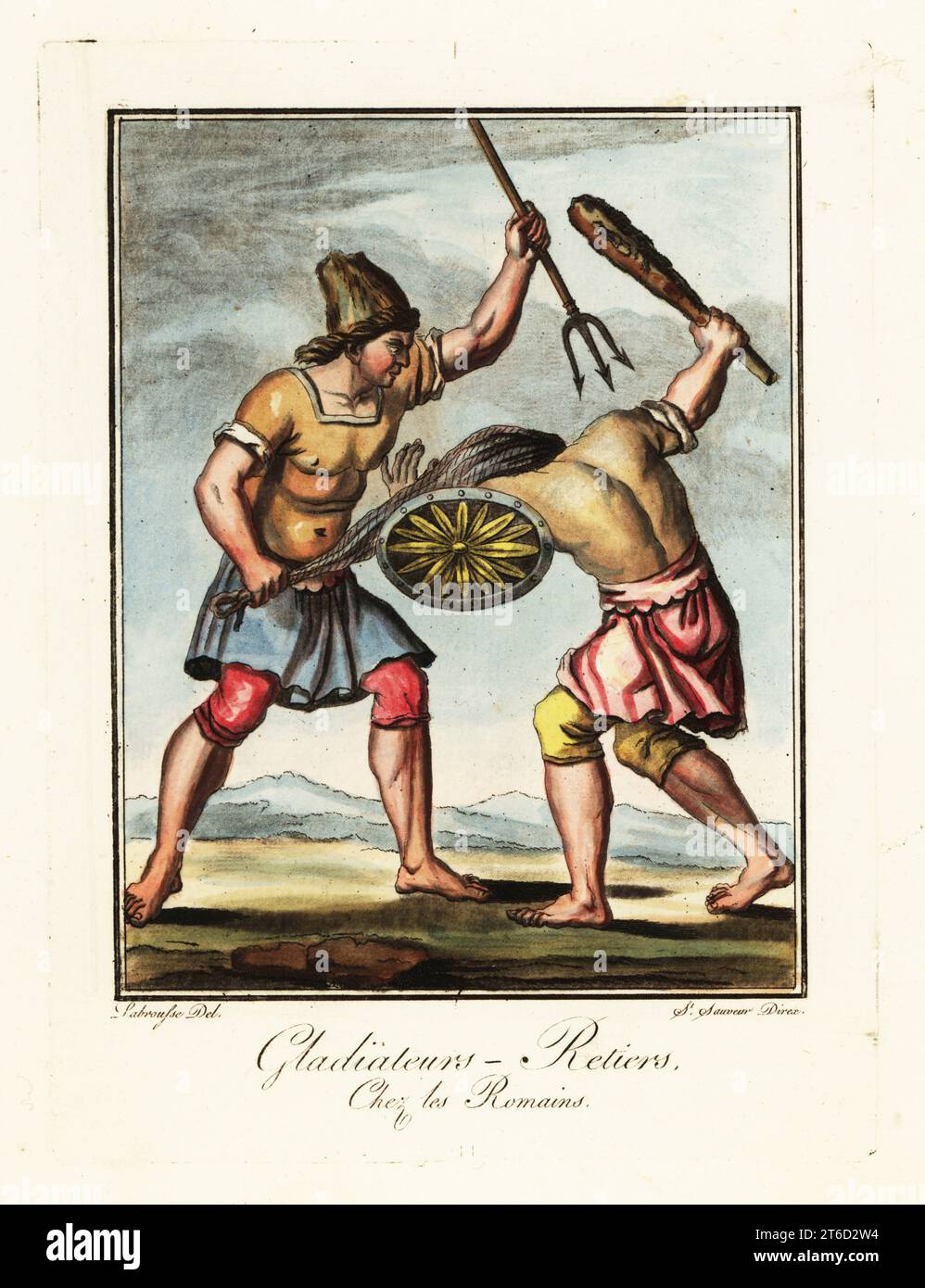 A battle between gladiators in the circus, ancient Rome. A retiarius with net and trident fights a secutor armed with cudgel and shield. Both wear skirts and short trousers or sagulum gregale. Gladiateurs: Retiers chez les Romains. Handcoloured copperplate drawn and engraved by L. Labrousse, artist of Bordeaux, under the direction of Jacques Grasset de Saint-Sauveur from his Lantique Rome, ou description historique et pittoresque, Ancient Rome, or historical and picturesque description, Chez Deroy, Paris, 1796. Stock Photohttps://www.alamy.com/image-license-details/?v=1https://www.alamy.com/a-battle-between-gladiators-in-the-circus-ancient-rome-a-retiarius-with-net-and-trident-fights-a-secutor-armed-with-cudgel-and-shield-both-wear-skirts-and-short-trousers-or-sagulum-gregale-gladiateurs-retiers-chez-les-romains-handcoloured-copperplate-drawn-and-engraved-by-l-labrousse-artist-of-bordeaux-under-the-direction-of-jacques-grasset-de-saint-sauveur-from-his-lantique-rome-ou-description-historique-et-pittoresque-ancient-rome-or-historical-and-picturesque-description-chez-deroy-paris-1796-image571917728.html
A battle between gladiators in the circus, ancient Rome. A retiarius with net and trident fights a secutor armed with cudgel and shield. Both wear skirts and short trousers or sagulum gregale. Gladiateurs: Retiers chez les Romains. Handcoloured copperplate drawn and engraved by L. Labrousse, artist of Bordeaux, under the direction of Jacques Grasset de Saint-Sauveur from his Lantique Rome, ou description historique et pittoresque, Ancient Rome, or historical and picturesque description, Chez Deroy, Paris, 1796. Stock Photohttps://www.alamy.com/image-license-details/?v=1https://www.alamy.com/a-battle-between-gladiators-in-the-circus-ancient-rome-a-retiarius-with-net-and-trident-fights-a-secutor-armed-with-cudgel-and-shield-both-wear-skirts-and-short-trousers-or-sagulum-gregale-gladiateurs-retiers-chez-les-romains-handcoloured-copperplate-drawn-and-engraved-by-l-labrousse-artist-of-bordeaux-under-the-direction-of-jacques-grasset-de-saint-sauveur-from-his-lantique-rome-ou-description-historique-et-pittoresque-ancient-rome-or-historical-and-picturesque-description-chez-deroy-paris-1796-image571917728.htmlRM2T6D2W4–A battle between gladiators in the circus, ancient Rome. A retiarius with net and trident fights a secutor armed with cudgel and shield. Both wear skirts and short trousers or sagulum gregale. Gladiateurs: Retiers chez les Romains. Handcoloured copperplate drawn and engraved by L. Labrousse, artist of Bordeaux, under the direction of Jacques Grasset de Saint-Sauveur from his Lantique Rome, ou description historique et pittoresque, Ancient Rome, or historical and picturesque description, Chez Deroy, Paris, 1796.
 Fashion and Elegance: Hooded Cloaks Men’s Wigs. During the early 18th century small series of costume plates reported on the fashion of the day. Women wore the loose-fitting robe volante, also called a ‘sack-backed gown’ in English, over which women sometimes added a short, hooded cloak known as a bagnolette. Men dressed in long coats over a waistcoat and knee-breeches. Pig-tail wigs were adorned with large bows, and tricorne hats were tucked under the arm rather than worn on the head. The two large prints from around 1760 show Parisians out for a stroll. Curiously, the women wear wide paniers Stock Photohttps://www.alamy.com/image-license-details/?v=1https://www.alamy.com/fashion-and-elegance-hooded-cloaks-mens-wigs-during-the-early-18th-century-small-series-of-costume-plates-reported-on-the-fashion-of-the-day-women-wore-the-loose-fitting-robe-volante-also-called-a-sack-backed-gown-in-english-over-which-women-sometimes-added-a-short-hooded-cloak-known-as-a-bagnolette-men-dressed-in-long-coats-over-a-waistcoat-and-knee-breeches-pig-tail-wigs-were-adorned-with-large-bows-and-tricorne-hats-were-tucked-under-the-arm-rather-than-worn-on-the-head-the-two-large-prints-from-around-1760-show-parisians-out-for-a-stroll-curiously-the-women-wear-wide-paniers-image431557971.html
Fashion and Elegance: Hooded Cloaks Men’s Wigs. During the early 18th century small series of costume plates reported on the fashion of the day. Women wore the loose-fitting robe volante, also called a ‘sack-backed gown’ in English, over which women sometimes added a short, hooded cloak known as a bagnolette. Men dressed in long coats over a waistcoat and knee-breeches. Pig-tail wigs were adorned with large bows, and tricorne hats were tucked under the arm rather than worn on the head. The two large prints from around 1760 show Parisians out for a stroll. Curiously, the women wear wide paniers Stock Photohttps://www.alamy.com/image-license-details/?v=1https://www.alamy.com/fashion-and-elegance-hooded-cloaks-mens-wigs-during-the-early-18th-century-small-series-of-costume-plates-reported-on-the-fashion-of-the-day-women-wore-the-loose-fitting-robe-volante-also-called-a-sack-backed-gown-in-english-over-which-women-sometimes-added-a-short-hooded-cloak-known-as-a-bagnolette-men-dressed-in-long-coats-over-a-waistcoat-and-knee-breeches-pig-tail-wigs-were-adorned-with-large-bows-and-tricorne-hats-were-tucked-under-the-arm-rather-than-worn-on-the-head-the-two-large-prints-from-around-1760-show-parisians-out-for-a-stroll-curiously-the-women-wear-wide-paniers-image431557971.htmlRM2G234GK–Fashion and Elegance: Hooded Cloaks Men’s Wigs. During the early 18th century small series of costume plates reported on the fashion of the day. Women wore the loose-fitting robe volante, also called a ‘sack-backed gown’ in English, over which women sometimes added a short, hooded cloak known as a bagnolette. Men dressed in long coats over a waistcoat and knee-breeches. Pig-tail wigs were adorned with large bows, and tricorne hats were tucked under the arm rather than worn on the head. The two large prints from around 1760 show Parisians out for a stroll. Curiously, the women wear wide paniers
 Buccinator or hornplayer in the Roman army, ancient Rome. He wears a lion-skin headdress, tunic, sagulum gregale or short trousers and sandals. He blows the buccina and is armed with gladius sword and pilum spear. A broken obelisk behind. Buccinator Romain. Handcoloured copperplate drawn and engraved by L. Labrousse, artist of Bordeaux, under the direction of Jacques Grasset de Saint-Sauveur from his Lantique Rome, ou description historique et pittoresque, Ancient Rome, or historical and picturesque description, Chez Deroy, Paris, 1796. Stock Photohttps://www.alamy.com/image-license-details/?v=1https://www.alamy.com/buccinator-or-hornplayer-in-the-roman-army-ancient-rome-he-wears-a-lion-skin-headdress-tunic-sagulum-gregale-or-short-trousers-and-sandals-he-blows-the-buccina-and-is-armed-with-gladius-sword-and-pilum-spear-a-broken-obelisk-behind-buccinator-romain-handcoloured-copperplate-drawn-and-engraved-by-l-labrousse-artist-of-bordeaux-under-the-direction-of-jacques-grasset-de-saint-sauveur-from-his-lantique-rome-ou-description-historique-et-pittoresque-ancient-rome-or-historical-and-picturesque-description-chez-deroy-paris-1796-image571909999.html
Buccinator or hornplayer in the Roman army, ancient Rome. He wears a lion-skin headdress, tunic, sagulum gregale or short trousers and sandals. He blows the buccina and is armed with gladius sword and pilum spear. A broken obelisk behind. Buccinator Romain. Handcoloured copperplate drawn and engraved by L. Labrousse, artist of Bordeaux, under the direction of Jacques Grasset de Saint-Sauveur from his Lantique Rome, ou description historique et pittoresque, Ancient Rome, or historical and picturesque description, Chez Deroy, Paris, 1796. Stock Photohttps://www.alamy.com/image-license-details/?v=1https://www.alamy.com/buccinator-or-hornplayer-in-the-roman-army-ancient-rome-he-wears-a-lion-skin-headdress-tunic-sagulum-gregale-or-short-trousers-and-sandals-he-blows-the-buccina-and-is-armed-with-gladius-sword-and-pilum-spear-a-broken-obelisk-behind-buccinator-romain-handcoloured-copperplate-drawn-and-engraved-by-l-labrousse-artist-of-bordeaux-under-the-direction-of-jacques-grasset-de-saint-sauveur-from-his-lantique-rome-ou-description-historique-et-pittoresque-ancient-rome-or-historical-and-picturesque-description-chez-deroy-paris-1796-image571909999.htmlRM2T6CN13–Buccinator or hornplayer in the Roman army, ancient Rome. He wears a lion-skin headdress, tunic, sagulum gregale or short trousers and sandals. He blows the buccina and is armed with gladius sword and pilum spear. A broken obelisk behind. Buccinator Romain. Handcoloured copperplate drawn and engraved by L. Labrousse, artist of Bordeaux, under the direction of Jacques Grasset de Saint-Sauveur from his Lantique Rome, ou description historique et pittoresque, Ancient Rome, or historical and picturesque description, Chez Deroy, Paris, 1796.
 Fashion and Elegance: Fashionable Ladies and Gentlemen of the 1740s. During the early 18th century small series of costume plates reported on the fashion of the day. Women wore the loose-fitting robe volante, also called a ‘sack-backed gown’ in English, over which women sometimes added a short, hooded cloak known as a bagnolette. Men dressed in long coats over a waistcoat and knee-breeches. Pig-tail wigs were adorned with large bows, and tricorne hats were tucked under the arm rather than worn on the head. The two large prints from around 1760 show Parisians out for a stroll. Curiously, the wo Stock Photohttps://www.alamy.com/image-license-details/?v=1https://www.alamy.com/fashion-and-elegance-fashionable-ladies-and-gentlemen-of-the-1740s-during-the-early-18th-century-small-series-of-costume-plates-reported-on-the-fashion-of-the-day-women-wore-the-loose-fitting-robe-volante-also-called-a-sack-backed-gown-in-english-over-which-women-sometimes-added-a-short-hooded-cloak-known-as-a-bagnolette-men-dressed-in-long-coats-over-a-waistcoat-and-knee-breeches-pig-tail-wigs-were-adorned-with-large-bows-and-tricorne-hats-were-tucked-under-the-arm-rather-than-worn-on-the-head-the-two-large-prints-from-around-1760-show-parisians-out-for-a-stroll-curiously-the-wo-image431563930.html
Fashion and Elegance: Fashionable Ladies and Gentlemen of the 1740s. During the early 18th century small series of costume plates reported on the fashion of the day. Women wore the loose-fitting robe volante, also called a ‘sack-backed gown’ in English, over which women sometimes added a short, hooded cloak known as a bagnolette. Men dressed in long coats over a waistcoat and knee-breeches. Pig-tail wigs were adorned with large bows, and tricorne hats were tucked under the arm rather than worn on the head. The two large prints from around 1760 show Parisians out for a stroll. Curiously, the wo Stock Photohttps://www.alamy.com/image-license-details/?v=1https://www.alamy.com/fashion-and-elegance-fashionable-ladies-and-gentlemen-of-the-1740s-during-the-early-18th-century-small-series-of-costume-plates-reported-on-the-fashion-of-the-day-women-wore-the-loose-fitting-robe-volante-also-called-a-sack-backed-gown-in-english-over-which-women-sometimes-added-a-short-hooded-cloak-known-as-a-bagnolette-men-dressed-in-long-coats-over-a-waistcoat-and-knee-breeches-pig-tail-wigs-were-adorned-with-large-bows-and-tricorne-hats-were-tucked-under-the-arm-rather-than-worn-on-the-head-the-two-large-prints-from-around-1760-show-parisians-out-for-a-stroll-curiously-the-wo-image431563930.htmlRM2G23C5E–Fashion and Elegance: Fashionable Ladies and Gentlemen of the 1740s. During the early 18th century small series of costume plates reported on the fashion of the day. Women wore the loose-fitting robe volante, also called a ‘sack-backed gown’ in English, over which women sometimes added a short, hooded cloak known as a bagnolette. Men dressed in long coats over a waistcoat and knee-breeches. Pig-tail wigs were adorned with large bows, and tricorne hats were tucked under the arm rather than worn on the head. The two large prints from around 1760 show Parisians out for a stroll. Curiously, the wo
 Praetorian Guards, ancient Rome. in galea helmet, lorica segmentata breastplate, tunic, sagulum gregale or short trousers, caligae hobnail sandals, armed with gladius sword and oval shield. Military tents in the background. Soldats Pretoriens. Handcoloured copperplate drawn and engraved by L. Labrousse, artist of Bordeaux, under the direction of Jacques Grasset de Saint-Sauveur from his Lantique Rome, ou description historique et pittoresque, Ancient Rome, or historical and picturesque description, Chez Deroy, Paris, 1796. Stock Photohttps://www.alamy.com/image-license-details/?v=1https://www.alamy.com/praetorian-guards-ancient-rome-in-galea-helmet-lorica-segmentata-breastplate-tunic-sagulum-gregale-or-short-trousers-caligae-hobnail-sandals-armed-with-gladius-sword-and-oval-shield-military-tents-in-the-background-soldats-pretoriens-handcoloured-copperplate-drawn-and-engraved-by-l-labrousse-artist-of-bordeaux-under-the-direction-of-jacques-grasset-de-saint-sauveur-from-his-lantique-rome-ou-description-historique-et-pittoresque-ancient-rome-or-historical-and-picturesque-description-chez-deroy-paris-1796-image571837355.html
Praetorian Guards, ancient Rome. in galea helmet, lorica segmentata breastplate, tunic, sagulum gregale or short trousers, caligae hobnail sandals, armed with gladius sword and oval shield. Military tents in the background. Soldats Pretoriens. Handcoloured copperplate drawn and engraved by L. Labrousse, artist of Bordeaux, under the direction of Jacques Grasset de Saint-Sauveur from his Lantique Rome, ou description historique et pittoresque, Ancient Rome, or historical and picturesque description, Chez Deroy, Paris, 1796. Stock Photohttps://www.alamy.com/image-license-details/?v=1https://www.alamy.com/praetorian-guards-ancient-rome-in-galea-helmet-lorica-segmentata-breastplate-tunic-sagulum-gregale-or-short-trousers-caligae-hobnail-sandals-armed-with-gladius-sword-and-oval-shield-military-tents-in-the-background-soldats-pretoriens-handcoloured-copperplate-drawn-and-engraved-by-l-labrousse-artist-of-bordeaux-under-the-direction-of-jacques-grasset-de-saint-sauveur-from-his-lantique-rome-ou-description-historique-et-pittoresque-ancient-rome-or-historical-and-picturesque-description-chez-deroy-paris-1796-image571837355.htmlRM2T69CAK–Praetorian Guards, ancient Rome. in galea helmet, lorica segmentata breastplate, tunic, sagulum gregale or short trousers, caligae hobnail sandals, armed with gladius sword and oval shield. Military tents in the background. Soldats Pretoriens. Handcoloured copperplate drawn and engraved by L. Labrousse, artist of Bordeaux, under the direction of Jacques Grasset de Saint-Sauveur from his Lantique Rome, ou description historique et pittoresque, Ancient Rome, or historical and picturesque description, Chez Deroy, Paris, 1796.
 Fashion and Elegance: Strolling Parisians. During the early 18th century small series of costume plates reported on the fashion of the day. Women wore the loose-fitting robe volante, also called a ‘sack-backed gown’ in English, over which women sometimes added a short, hooded cloak known as a bagnolette. Men dressed in long coats over a waistcoat and knee-breeches. Pig-tail wigs were adorned with large bows, and tricorne hats were tucked under the arm rather than worn on the head. The two large prints from around 1760 show Parisians out for a stroll. Curiously, the women wear wide paniers (hoo Stock Photohttps://www.alamy.com/image-license-details/?v=1https://www.alamy.com/fashion-and-elegance-strolling-parisians-during-the-early-18th-century-small-series-of-costume-plates-reported-on-the-fashion-of-the-day-women-wore-the-loose-fitting-robe-volante-also-called-a-sack-backed-gown-in-english-over-which-women-sometimes-added-a-short-hooded-cloak-known-as-a-bagnolette-men-dressed-in-long-coats-over-a-waistcoat-and-knee-breeches-pig-tail-wigs-were-adorned-with-large-bows-and-tricorne-hats-were-tucked-under-the-arm-rather-than-worn-on-the-head-the-two-large-prints-from-around-1760-show-parisians-out-for-a-stroll-curiously-the-women-wear-wide-paniers-hoo-image430975236.html
Fashion and Elegance: Strolling Parisians. During the early 18th century small series of costume plates reported on the fashion of the day. Women wore the loose-fitting robe volante, also called a ‘sack-backed gown’ in English, over which women sometimes added a short, hooded cloak known as a bagnolette. Men dressed in long coats over a waistcoat and knee-breeches. Pig-tail wigs were adorned with large bows, and tricorne hats were tucked under the arm rather than worn on the head. The two large prints from around 1760 show Parisians out for a stroll. Curiously, the women wear wide paniers (hoo Stock Photohttps://www.alamy.com/image-license-details/?v=1https://www.alamy.com/fashion-and-elegance-strolling-parisians-during-the-early-18th-century-small-series-of-costume-plates-reported-on-the-fashion-of-the-day-women-wore-the-loose-fitting-robe-volante-also-called-a-sack-backed-gown-in-english-over-which-women-sometimes-added-a-short-hooded-cloak-known-as-a-bagnolette-men-dressed-in-long-coats-over-a-waistcoat-and-knee-breeches-pig-tail-wigs-were-adorned-with-large-bows-and-tricorne-hats-were-tucked-under-the-arm-rather-than-worn-on-the-head-the-two-large-prints-from-around-1760-show-parisians-out-for-a-stroll-curiously-the-women-wear-wide-paniers-hoo-image430975236.htmlRM2G14H8M–Fashion and Elegance: Strolling Parisians. During the early 18th century small series of costume plates reported on the fashion of the day. Women wore the loose-fitting robe volante, also called a ‘sack-backed gown’ in English, over which women sometimes added a short, hooded cloak known as a bagnolette. Men dressed in long coats over a waistcoat and knee-breeches. Pig-tail wigs were adorned with large bows, and tricorne hats were tucked under the arm rather than worn on the head. The two large prints from around 1760 show Parisians out for a stroll. Curiously, the women wear wide paniers (hoo
 Dictator in military uniform, ancient Rome. Wearing galea or helmet, breastplate, paludamentum cloak, tunic, short trousers or sagulum gregale, and caligae hobnail boots. In front of a legion of soldiers with signifers and buccinators. Dictateur chez les Romains. Handcoloured copperplate drawn and engraved by L. Labrousse, artist of Bordeaux, under the direction of Jacques Grasset de Saint-Sauveur from his Lantique Rome, ou description historique et pittoresque, Ancient Rome, or historical and picturesque description, Chez Deroy, Paris, 1796. Stock Photohttps://www.alamy.com/image-license-details/?v=1https://www.alamy.com/dictator-in-military-uniform-ancient-rome-wearing-galea-or-helmet-breastplate-paludamentum-cloak-tunic-short-trousers-or-sagulum-gregale-and-caligae-hobnail-boots-in-front-of-a-legion-of-soldiers-with-signifers-and-buccinators-dictateur-chez-les-romains-handcoloured-copperplate-drawn-and-engraved-by-l-labrousse-artist-of-bordeaux-under-the-direction-of-jacques-grasset-de-saint-sauveur-from-his-lantique-rome-ou-description-historique-et-pittoresque-ancient-rome-or-historical-and-picturesque-description-chez-deroy-paris-1796-image571846693.html
Dictator in military uniform, ancient Rome. Wearing galea or helmet, breastplate, paludamentum cloak, tunic, short trousers or sagulum gregale, and caligae hobnail boots. In front of a legion of soldiers with signifers and buccinators. Dictateur chez les Romains. Handcoloured copperplate drawn and engraved by L. Labrousse, artist of Bordeaux, under the direction of Jacques Grasset de Saint-Sauveur from his Lantique Rome, ou description historique et pittoresque, Ancient Rome, or historical and picturesque description, Chez Deroy, Paris, 1796. Stock Photohttps://www.alamy.com/image-license-details/?v=1https://www.alamy.com/dictator-in-military-uniform-ancient-rome-wearing-galea-or-helmet-breastplate-paludamentum-cloak-tunic-short-trousers-or-sagulum-gregale-and-caligae-hobnail-boots-in-front-of-a-legion-of-soldiers-with-signifers-and-buccinators-dictateur-chez-les-romains-handcoloured-copperplate-drawn-and-engraved-by-l-labrousse-artist-of-bordeaux-under-the-direction-of-jacques-grasset-de-saint-sauveur-from-his-lantique-rome-ou-description-historique-et-pittoresque-ancient-rome-or-historical-and-picturesque-description-chez-deroy-paris-1796-image571846693.htmlRM2T69T85–Dictator in military uniform, ancient Rome. Wearing galea or helmet, breastplate, paludamentum cloak, tunic, short trousers or sagulum gregale, and caligae hobnail boots. In front of a legion of soldiers with signifers and buccinators. Dictateur chez les Romains. Handcoloured copperplate drawn and engraved by L. Labrousse, artist of Bordeaux, under the direction of Jacques Grasset de Saint-Sauveur from his Lantique Rome, ou description historique et pittoresque, Ancient Rome, or historical and picturesque description, Chez Deroy, Paris, 1796.
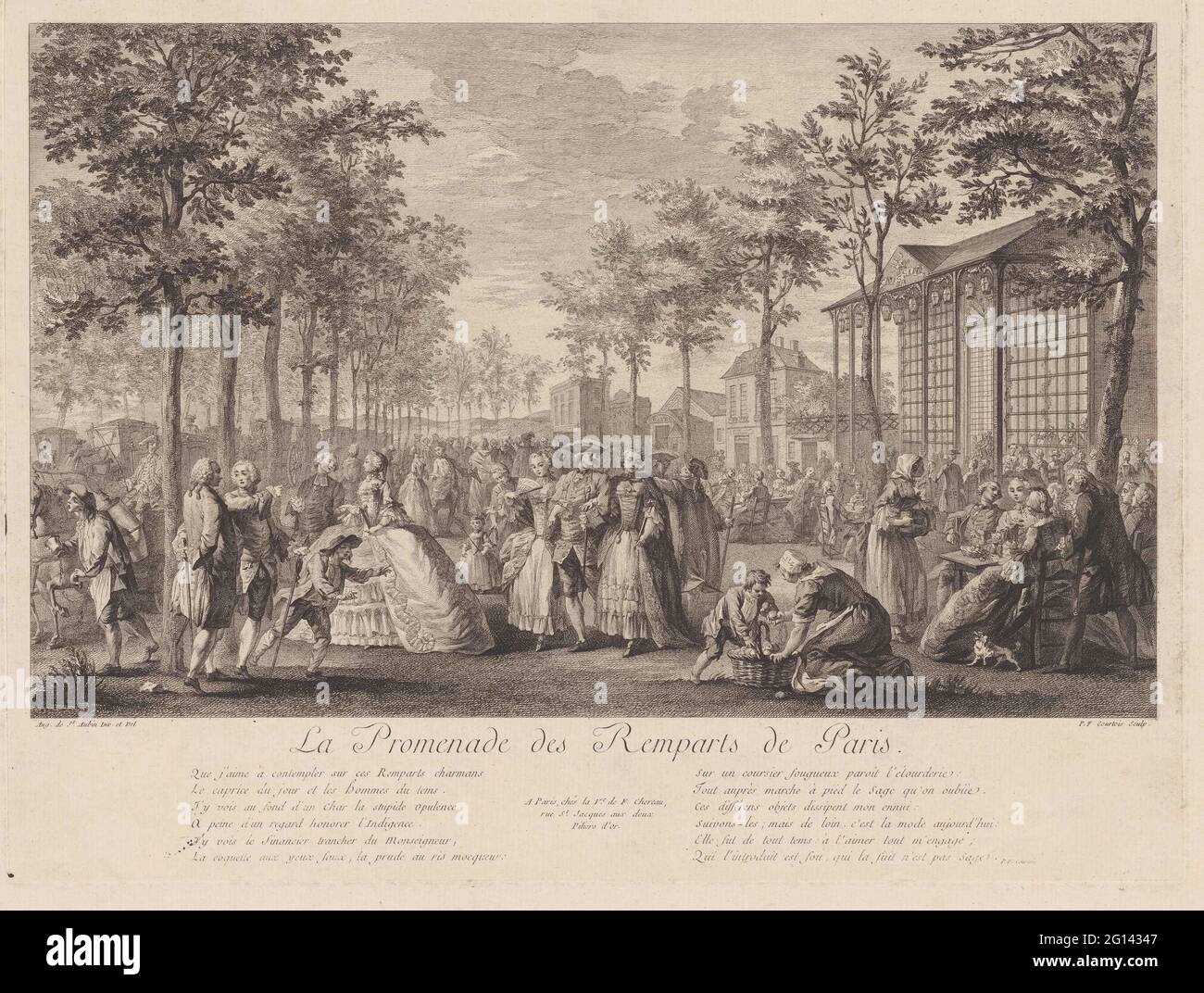 Fashion and Elegance: Strolling Parisians. During the early 18th century small series of costume plates reported on the fashion of the day. Women wore the loose-fitting robe volante, also called a ‘sack-backed gown’ in English, over which women sometimes added a short, hooded cloak known as a bagnolette. Men dressed in long coats over a waistcoat and knee-breeches. Pig-tail wigs were adorned with large bows, and tricorne hats were tucked under the arm rather than worn on the head. The two large prints from around 1760 show Parisians out for a stroll. Curiously, the women wear wide paniers (hoo Stock Photohttps://www.alamy.com/image-license-details/?v=1https://www.alamy.com/fashion-and-elegance-strolling-parisians-during-the-early-18th-century-small-series-of-costume-plates-reported-on-the-fashion-of-the-day-women-wore-the-loose-fitting-robe-volante-also-called-a-sack-backed-gown-in-english-over-which-women-sometimes-added-a-short-hooded-cloak-known-as-a-bagnolette-men-dressed-in-long-coats-over-a-waistcoat-and-knee-breeches-pig-tail-wigs-were-adorned-with-large-bows-and-tricorne-hats-were-tucked-under-the-arm-rather-than-worn-on-the-head-the-two-large-prints-from-around-1760-show-parisians-out-for-a-stroll-curiously-the-women-wear-wide-paniers-hoo-image430964135.html
Fashion and Elegance: Strolling Parisians. During the early 18th century small series of costume plates reported on the fashion of the day. Women wore the loose-fitting robe volante, also called a ‘sack-backed gown’ in English, over which women sometimes added a short, hooded cloak known as a bagnolette. Men dressed in long coats over a waistcoat and knee-breeches. Pig-tail wigs were adorned with large bows, and tricorne hats were tucked under the arm rather than worn on the head. The two large prints from around 1760 show Parisians out for a stroll. Curiously, the women wear wide paniers (hoo Stock Photohttps://www.alamy.com/image-license-details/?v=1https://www.alamy.com/fashion-and-elegance-strolling-parisians-during-the-early-18th-century-small-series-of-costume-plates-reported-on-the-fashion-of-the-day-women-wore-the-loose-fitting-robe-volante-also-called-a-sack-backed-gown-in-english-over-which-women-sometimes-added-a-short-hooded-cloak-known-as-a-bagnolette-men-dressed-in-long-coats-over-a-waistcoat-and-knee-breeches-pig-tail-wigs-were-adorned-with-large-bows-and-tricorne-hats-were-tucked-under-the-arm-rather-than-worn-on-the-head-the-two-large-prints-from-around-1760-show-parisians-out-for-a-stroll-curiously-the-women-wear-wide-paniers-hoo-image430964135.htmlRM2G14347–Fashion and Elegance: Strolling Parisians. During the early 18th century small series of costume plates reported on the fashion of the day. Women wore the loose-fitting robe volante, also called a ‘sack-backed gown’ in English, over which women sometimes added a short, hooded cloak known as a bagnolette. Men dressed in long coats over a waistcoat and knee-breeches. Pig-tail wigs were adorned with large bows, and tricorne hats were tucked under the arm rather than worn on the head. The two large prints from around 1760 show Parisians out for a stroll. Curiously, the women wear wide paniers (hoo
 Roman legionary and veles, ancient Rome. The soldier in galea helmet, tunic, caligae hobnail sandals, armed with pilum or javelin and oval shield. Skirmisher in tunic, sagulum gregale or short trousers, barefoot with shield. Legionnaire et Velite Romains. Handcoloured copperplate drawn and engraved by L. Labrousse, artist of Bordeaux, under the direction of Jacques Grasset de Saint-Sauveur from his Lantique Rome, ou description historique et pittoresque, Ancient Rome, or historical and picturesque description, Chez Deroy, Paris, 1796. Stock Photohttps://www.alamy.com/image-license-details/?v=1https://www.alamy.com/roman-legionary-and-veles-ancient-rome-the-soldier-in-galea-helmet-tunic-caligae-hobnail-sandals-armed-with-pilum-or-javelin-and-oval-shield-skirmisher-in-tunic-sagulum-gregale-or-short-trousers-barefoot-with-shield-legionnaire-et-velite-romains-handcoloured-copperplate-drawn-and-engraved-by-l-labrousse-artist-of-bordeaux-under-the-direction-of-jacques-grasset-de-saint-sauveur-from-his-lantique-rome-ou-description-historique-et-pittoresque-ancient-rome-or-historical-and-picturesque-description-chez-deroy-paris-1796-image571835306.html
Roman legionary and veles, ancient Rome. The soldier in galea helmet, tunic, caligae hobnail sandals, armed with pilum or javelin and oval shield. Skirmisher in tunic, sagulum gregale or short trousers, barefoot with shield. Legionnaire et Velite Romains. Handcoloured copperplate drawn and engraved by L. Labrousse, artist of Bordeaux, under the direction of Jacques Grasset de Saint-Sauveur from his Lantique Rome, ou description historique et pittoresque, Ancient Rome, or historical and picturesque description, Chez Deroy, Paris, 1796. Stock Photohttps://www.alamy.com/image-license-details/?v=1https://www.alamy.com/roman-legionary-and-veles-ancient-rome-the-soldier-in-galea-helmet-tunic-caligae-hobnail-sandals-armed-with-pilum-or-javelin-and-oval-shield-skirmisher-in-tunic-sagulum-gregale-or-short-trousers-barefoot-with-shield-legionnaire-et-velite-romains-handcoloured-copperplate-drawn-and-engraved-by-l-labrousse-artist-of-bordeaux-under-the-direction-of-jacques-grasset-de-saint-sauveur-from-his-lantique-rome-ou-description-historique-et-pittoresque-ancient-rome-or-historical-and-picturesque-description-chez-deroy-paris-1796-image571835306.htmlRM2T699NE–Roman legionary and veles, ancient Rome. The soldier in galea helmet, tunic, caligae hobnail sandals, armed with pilum or javelin and oval shield. Skirmisher in tunic, sagulum gregale or short trousers, barefoot with shield. Legionnaire et Velite Romains. Handcoloured copperplate drawn and engraved by L. Labrousse, artist of Bordeaux, under the direction of Jacques Grasset de Saint-Sauveur from his Lantique Rome, ou description historique et pittoresque, Ancient Rome, or historical and picturesque description, Chez Deroy, Paris, 1796.
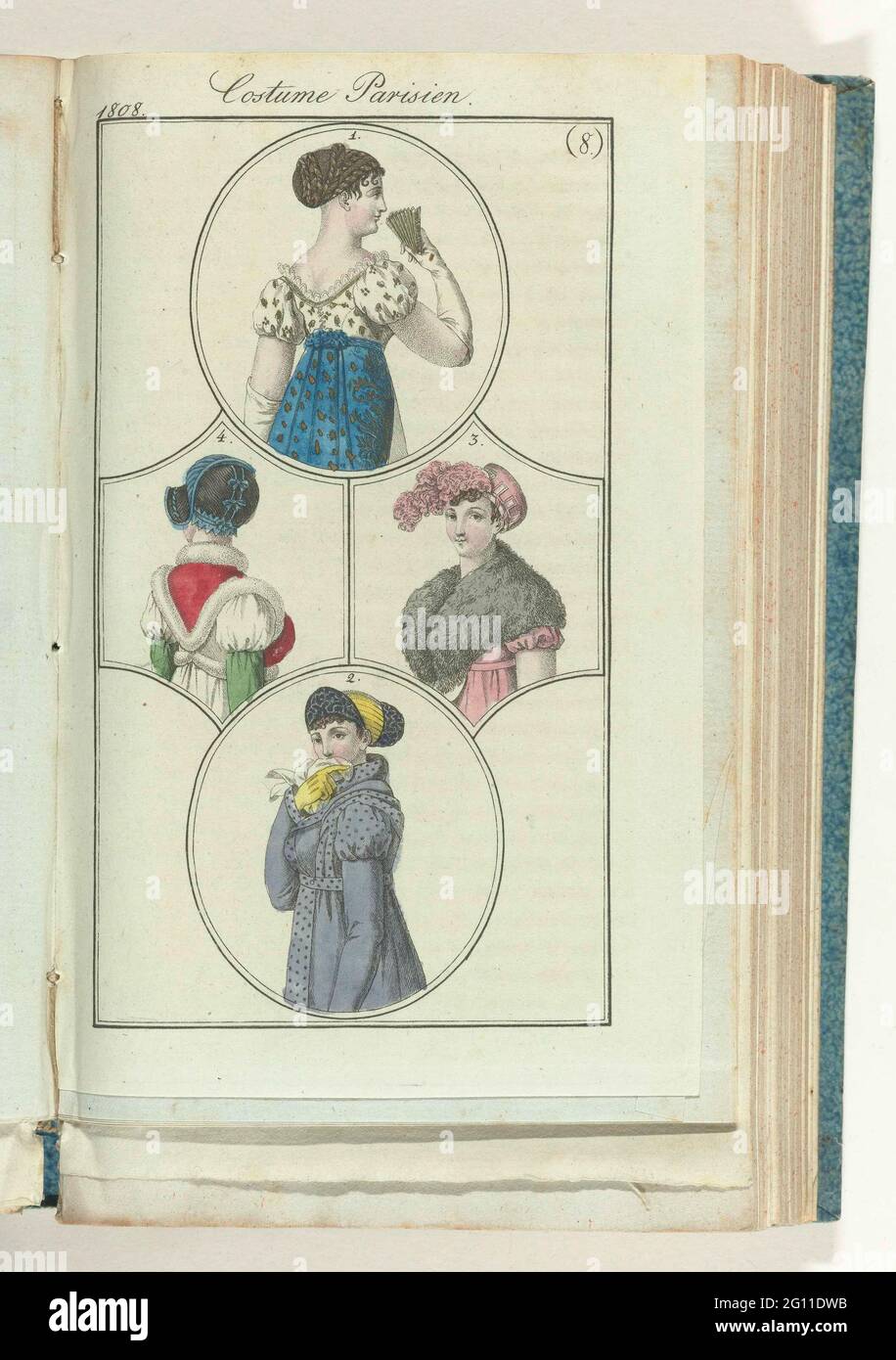 Journal des Ladies et des Modes, edition Frankfurt 22 Février 1808, Costume Parisien (8). The accompanying text (p. 212 and 213) states: FIG. 1: Coiffure de Grande Parure: Gais of gold thread, braided with her. Short crock of white satin, embroidered with gold. Blue, embroidered manteau, with long queue. FIG. 2: Coiffure of black velvet and yellow satin. Robe Levantine topped with 'Plush Tigrée'. (Under this dress, a white jupon is wearing ...). FIG. 3: Toque of pink crepe with a long spring on the front. Jap of pink taffeta with short sleeves. Fichu from Vossebont. FIG. 4: Capote of satin and Stock Photohttps://www.alamy.com/image-license-details/?v=1https://www.alamy.com/journal-des-ladies-et-des-modes-edition-frankfurt-22-fvrier-1808-costume-parisien-8-the-accompanying-text-p-212-and-213-states-fig-1-coiffure-de-grande-parure-gais-of-gold-thread-braided-with-her-short-crock-of-white-satin-embroidered-with-gold-blue-embroidered-manteau-with-long-queue-fig-2-coiffure-of-black-velvet-and-yellow-satin-robe-levantine-topped-with-plush-tigre-under-this-dress-a-white-jupon-is-wearing-fig-3-toque-of-pink-crepe-with-a-long-spring-on-the-front-jap-of-pink-taffeta-with-short-sleeves-fichu-from-vossebont-fig-4-capote-of-satin-and-image430906711.html
Journal des Ladies et des Modes, edition Frankfurt 22 Février 1808, Costume Parisien (8). The accompanying text (p. 212 and 213) states: FIG. 1: Coiffure de Grande Parure: Gais of gold thread, braided with her. Short crock of white satin, embroidered with gold. Blue, embroidered manteau, with long queue. FIG. 2: Coiffure of black velvet and yellow satin. Robe Levantine topped with 'Plush Tigrée'. (Under this dress, a white jupon is wearing ...). FIG. 3: Toque of pink crepe with a long spring on the front. Jap of pink taffeta with short sleeves. Fichu from Vossebont. FIG. 4: Capote of satin and Stock Photohttps://www.alamy.com/image-license-details/?v=1https://www.alamy.com/journal-des-ladies-et-des-modes-edition-frankfurt-22-fvrier-1808-costume-parisien-8-the-accompanying-text-p-212-and-213-states-fig-1-coiffure-de-grande-parure-gais-of-gold-thread-braided-with-her-short-crock-of-white-satin-embroidered-with-gold-blue-embroidered-manteau-with-long-queue-fig-2-coiffure-of-black-velvet-and-yellow-satin-robe-levantine-topped-with-plush-tigre-under-this-dress-a-white-jupon-is-wearing-fig-3-toque-of-pink-crepe-with-a-long-spring-on-the-front-jap-of-pink-taffeta-with-short-sleeves-fichu-from-vossebont-fig-4-capote-of-satin-and-image430906711.htmlRM2G11DWB–Journal des Ladies et des Modes, edition Frankfurt 22 Février 1808, Costume Parisien (8). The accompanying text (p. 212 and 213) states: FIG. 1: Coiffure de Grande Parure: Gais of gold thread, braided with her. Short crock of white satin, embroidered with gold. Blue, embroidered manteau, with long queue. FIG. 2: Coiffure of black velvet and yellow satin. Robe Levantine topped with 'Plush Tigrée'. (Under this dress, a white jupon is wearing ...). FIG. 3: Toque of pink crepe with a long spring on the front. Jap of pink taffeta with short sleeves. Fichu from Vossebont. FIG. 4: Capote of satin and
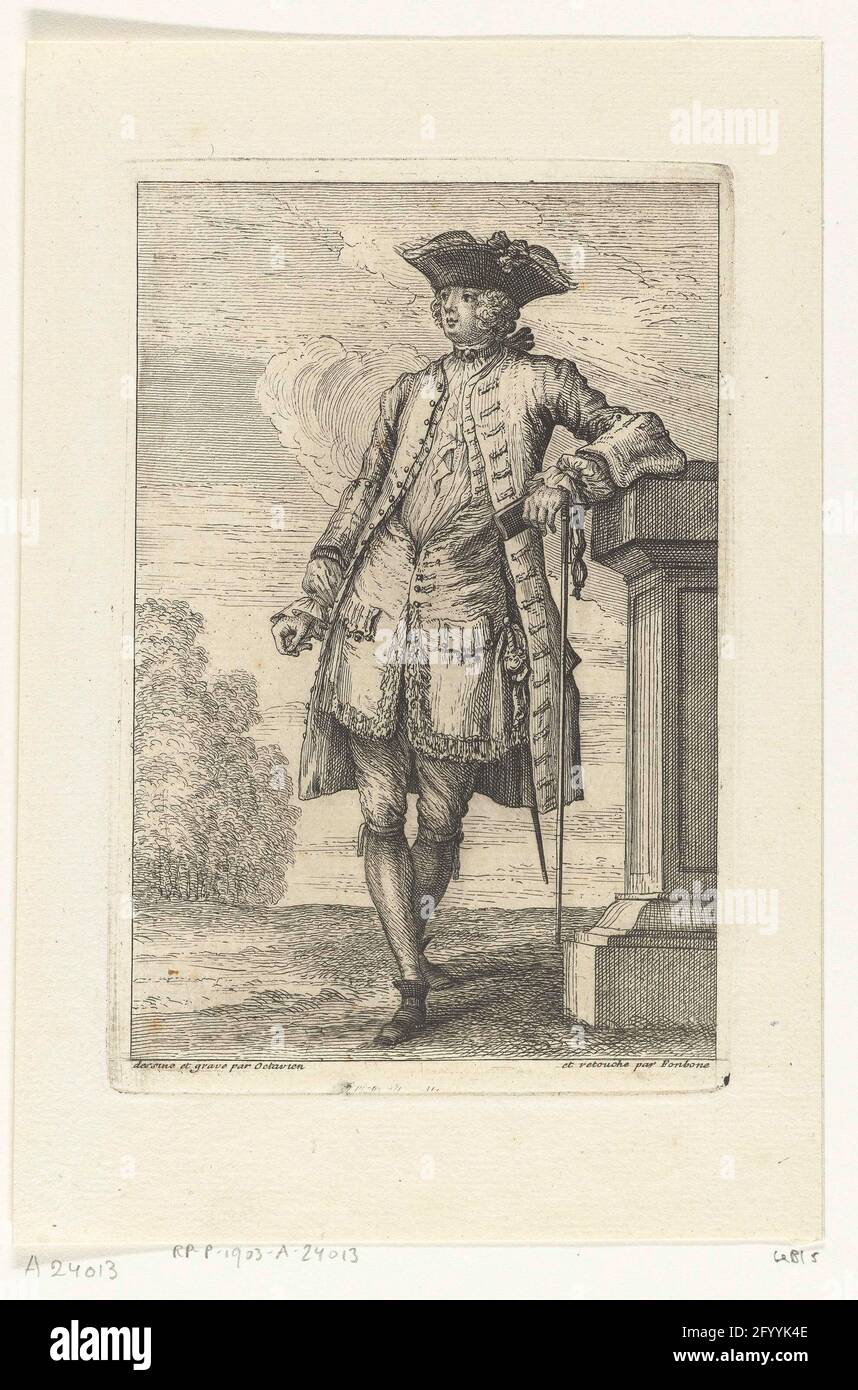 Fashion and Elegance: French Fashions of the 1720s. During the early 18th century small series of costume plates reported on the fashion of the day. Women wore the loose-fitting robe volante, also called a ‘sack-backed gown’ in English, over which women sometimes added a short, hooded cloak known as a bagnolette. Men dressed in long coats over a waistcoat and knee-breeches. Pig-tail wigs were adorned with large bows, and tricorne hats were tucked under the arm rather than worn on the head. The two large prints from around 1760 show Parisians out for a stroll. Curiously, the women wear wide pan Stock Photohttps://www.alamy.com/image-license-details/?v=1https://www.alamy.com/fashion-and-elegance-french-fashions-of-the-1720s-during-the-early-18th-century-small-series-of-costume-plates-reported-on-the-fashion-of-the-day-women-wore-the-loose-fitting-robe-volante-also-called-a-sack-backed-gown-in-english-over-which-women-sometimes-added-a-short-hooded-cloak-known-as-a-bagnolette-men-dressed-in-long-coats-over-a-waistcoat-and-knee-breeches-pig-tail-wigs-were-adorned-with-large-bows-and-tricorne-hats-were-tucked-under-the-arm-rather-than-worn-on-the-head-the-two-large-prints-from-around-1760-show-parisians-out-for-a-stroll-curiously-the-women-wear-wide-pan-image430252270.html
Fashion and Elegance: French Fashions of the 1720s. During the early 18th century small series of costume plates reported on the fashion of the day. Women wore the loose-fitting robe volante, also called a ‘sack-backed gown’ in English, over which women sometimes added a short, hooded cloak known as a bagnolette. Men dressed in long coats over a waistcoat and knee-breeches. Pig-tail wigs were adorned with large bows, and tricorne hats were tucked under the arm rather than worn on the head. The two large prints from around 1760 show Parisians out for a stroll. Curiously, the women wear wide pan Stock Photohttps://www.alamy.com/image-license-details/?v=1https://www.alamy.com/fashion-and-elegance-french-fashions-of-the-1720s-during-the-early-18th-century-small-series-of-costume-plates-reported-on-the-fashion-of-the-day-women-wore-the-loose-fitting-robe-volante-also-called-a-sack-backed-gown-in-english-over-which-women-sometimes-added-a-short-hooded-cloak-known-as-a-bagnolette-men-dressed-in-long-coats-over-a-waistcoat-and-knee-breeches-pig-tail-wigs-were-adorned-with-large-bows-and-tricorne-hats-were-tucked-under-the-arm-rather-than-worn-on-the-head-the-two-large-prints-from-around-1760-show-parisians-out-for-a-stroll-curiously-the-women-wear-wide-pan-image430252270.htmlRM2FYYK4E–Fashion and Elegance: French Fashions of the 1720s. During the early 18th century small series of costume plates reported on the fashion of the day. Women wore the loose-fitting robe volante, also called a ‘sack-backed gown’ in English, over which women sometimes added a short, hooded cloak known as a bagnolette. Men dressed in long coats over a waistcoat and knee-breeches. Pig-tail wigs were adorned with large bows, and tricorne hats were tucked under the arm rather than worn on the head. The two large prints from around 1760 show Parisians out for a stroll. Curiously, the women wear wide pan
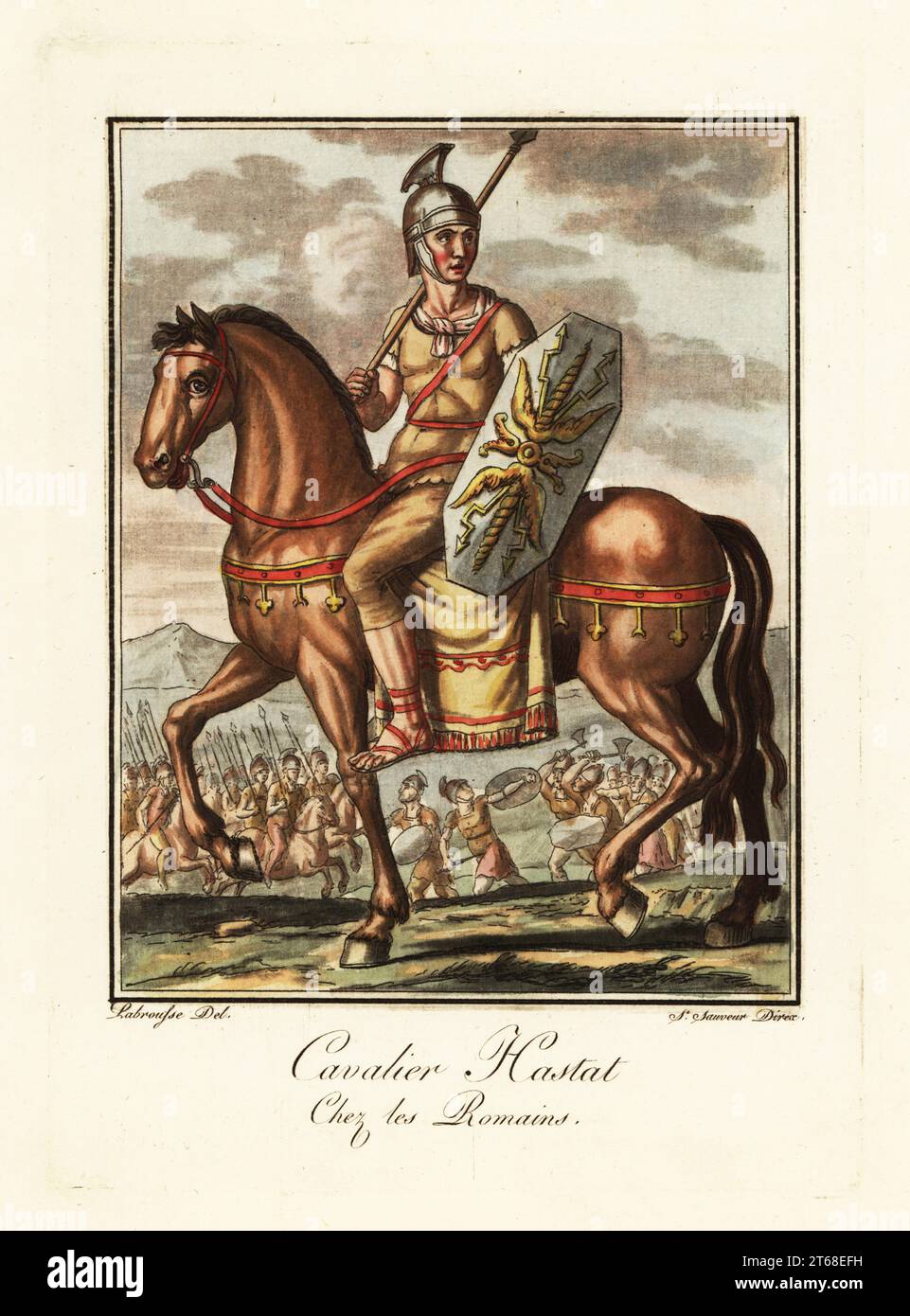 Roman hastatus or mounted lancer, ancient Rome. Mounted on a horse, wearing galea helmet, tunic, baldric belt, sagulum gregale or short trousers. Armed with shield and spear. In the background, a cohort of lancers in battle. Cavalier Hastat chez les Romains. Handcoloured copperplate drawn and engraved by L. Labrousse, artist of Bordeaux, under the direction of Jacques Grasset de Saint-Sauveur from his Lantique Rome, ou description historique et pittoresque, Ancient Rome, or historical and picturesque description, Chez Deroy, Paris, 1796. Stock Photohttps://www.alamy.com/image-license-details/?v=1https://www.alamy.com/roman-hastatus-or-mounted-lancer-ancient-rome-mounted-on-a-horse-wearing-galea-helmet-tunic-baldric-belt-sagulum-gregale-or-short-trousers-armed-with-shield-and-spear-in-the-background-a-cohort-of-lancers-in-battle-cavalier-hastat-chez-les-romains-handcoloured-copperplate-drawn-and-engraved-by-l-labrousse-artist-of-bordeaux-under-the-direction-of-jacques-grasset-de-saint-sauveur-from-his-lantique-rome-ou-description-historique-et-pittoresque-ancient-rome-or-historical-and-picturesque-description-chez-deroy-paris-1796-image571817109.html
Roman hastatus or mounted lancer, ancient Rome. Mounted on a horse, wearing galea helmet, tunic, baldric belt, sagulum gregale or short trousers. Armed with shield and spear. In the background, a cohort of lancers in battle. Cavalier Hastat chez les Romains. Handcoloured copperplate drawn and engraved by L. Labrousse, artist of Bordeaux, under the direction of Jacques Grasset de Saint-Sauveur from his Lantique Rome, ou description historique et pittoresque, Ancient Rome, or historical and picturesque description, Chez Deroy, Paris, 1796. Stock Photohttps://www.alamy.com/image-license-details/?v=1https://www.alamy.com/roman-hastatus-or-mounted-lancer-ancient-rome-mounted-on-a-horse-wearing-galea-helmet-tunic-baldric-belt-sagulum-gregale-or-short-trousers-armed-with-shield-and-spear-in-the-background-a-cohort-of-lancers-in-battle-cavalier-hastat-chez-les-romains-handcoloured-copperplate-drawn-and-engraved-by-l-labrousse-artist-of-bordeaux-under-the-direction-of-jacques-grasset-de-saint-sauveur-from-his-lantique-rome-ou-description-historique-et-pittoresque-ancient-rome-or-historical-and-picturesque-description-chez-deroy-paris-1796-image571817109.htmlRM2T68EFH–Roman hastatus or mounted lancer, ancient Rome. Mounted on a horse, wearing galea helmet, tunic, baldric belt, sagulum gregale or short trousers. Armed with shield and spear. In the background, a cohort of lancers in battle. Cavalier Hastat chez les Romains. Handcoloured copperplate drawn and engraved by L. Labrousse, artist of Bordeaux, under the direction of Jacques Grasset de Saint-Sauveur from his Lantique Rome, ou description historique et pittoresque, Ancient Rome, or historical and picturesque description, Chez Deroy, Paris, 1796.
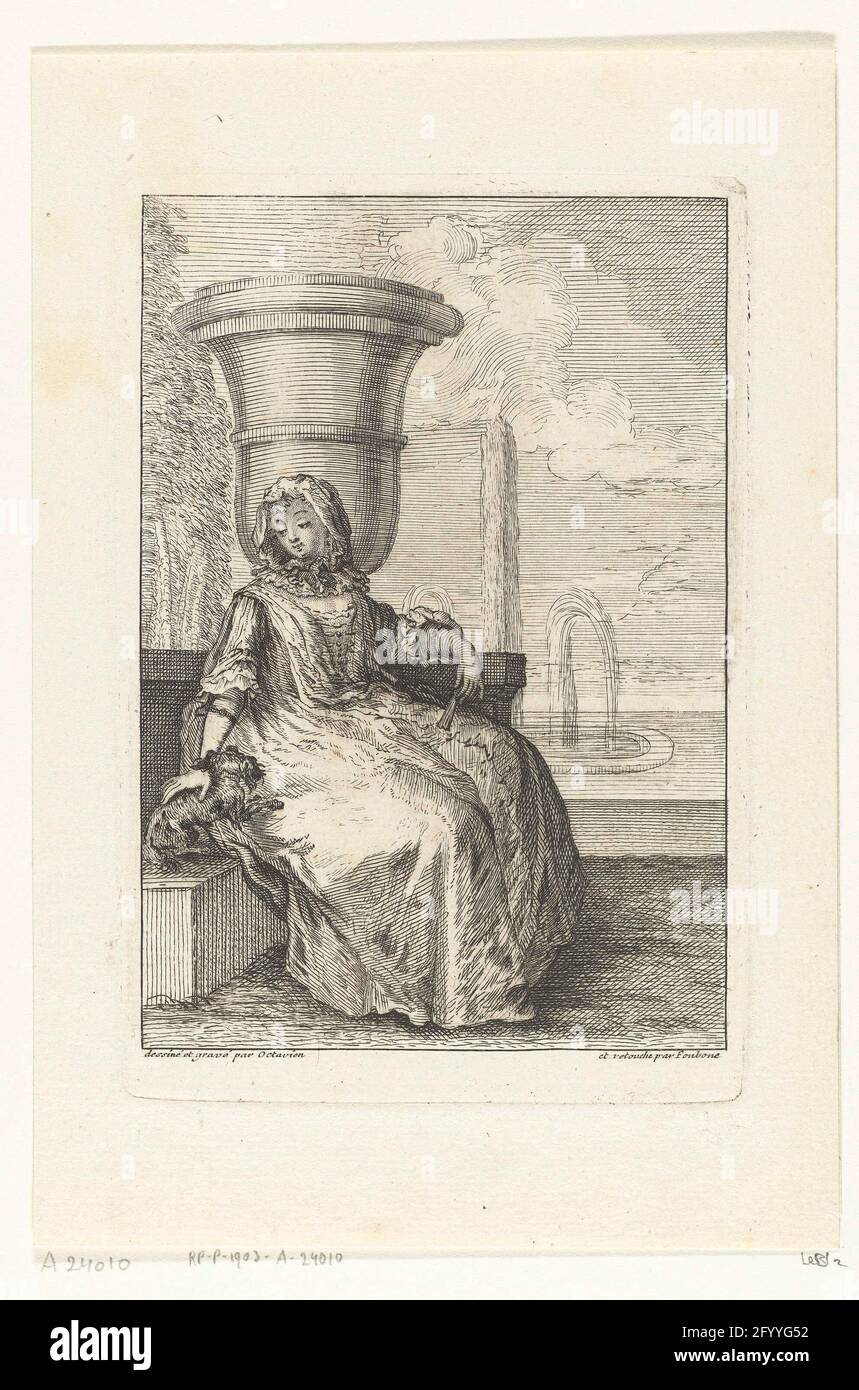 Fashion and Elegance: French Fashions of the 1720s. During the early 18th century small series of costume plates reported on the fashion of the day. Women wore the loose-fitting robe volante, also called a ‘sack-backed gown’ in English, over which women sometimes added a short, hooded cloak known as a bagnolette. Men dressed in long coats over a waistcoat and knee-breeches. Pig-tail wigs were adorned with large bows, and tricorne hats were tucked under the arm rather than worn on the head. The two large prints from around 1760 show Parisians out for a stroll. Curiously, the women wear wide pan Stock Photohttps://www.alamy.com/image-license-details/?v=1https://www.alamy.com/fashion-and-elegance-french-fashions-of-the-1720s-during-the-early-18th-century-small-series-of-costume-plates-reported-on-the-fashion-of-the-day-women-wore-the-loose-fitting-robe-volante-also-called-a-sack-backed-gown-in-english-over-which-women-sometimes-added-a-short-hooded-cloak-known-as-a-bagnolette-men-dressed-in-long-coats-over-a-waistcoat-and-knee-breeches-pig-tail-wigs-were-adorned-with-large-bows-and-tricorne-hats-were-tucked-under-the-arm-rather-than-worn-on-the-head-the-two-large-prints-from-around-1760-show-parisians-out-for-a-stroll-curiously-the-women-wear-wide-pan-image430249934.html
Fashion and Elegance: French Fashions of the 1720s. During the early 18th century small series of costume plates reported on the fashion of the day. Women wore the loose-fitting robe volante, also called a ‘sack-backed gown’ in English, over which women sometimes added a short, hooded cloak known as a bagnolette. Men dressed in long coats over a waistcoat and knee-breeches. Pig-tail wigs were adorned with large bows, and tricorne hats were tucked under the arm rather than worn on the head. The two large prints from around 1760 show Parisians out for a stroll. Curiously, the women wear wide pan Stock Photohttps://www.alamy.com/image-license-details/?v=1https://www.alamy.com/fashion-and-elegance-french-fashions-of-the-1720s-during-the-early-18th-century-small-series-of-costume-plates-reported-on-the-fashion-of-the-day-women-wore-the-loose-fitting-robe-volante-also-called-a-sack-backed-gown-in-english-over-which-women-sometimes-added-a-short-hooded-cloak-known-as-a-bagnolette-men-dressed-in-long-coats-over-a-waistcoat-and-knee-breeches-pig-tail-wigs-were-adorned-with-large-bows-and-tricorne-hats-were-tucked-under-the-arm-rather-than-worn-on-the-head-the-two-large-prints-from-around-1760-show-parisians-out-for-a-stroll-curiously-the-women-wear-wide-pan-image430249934.htmlRM2FYYG52–Fashion and Elegance: French Fashions of the 1720s. During the early 18th century small series of costume plates reported on the fashion of the day. Women wore the loose-fitting robe volante, also called a ‘sack-backed gown’ in English, over which women sometimes added a short, hooded cloak known as a bagnolette. Men dressed in long coats over a waistcoat and knee-breeches. Pig-tail wigs were adorned with large bows, and tricorne hats were tucked under the arm rather than worn on the head. The two large prints from around 1760 show Parisians out for a stroll. Curiously, the women wear wide pan
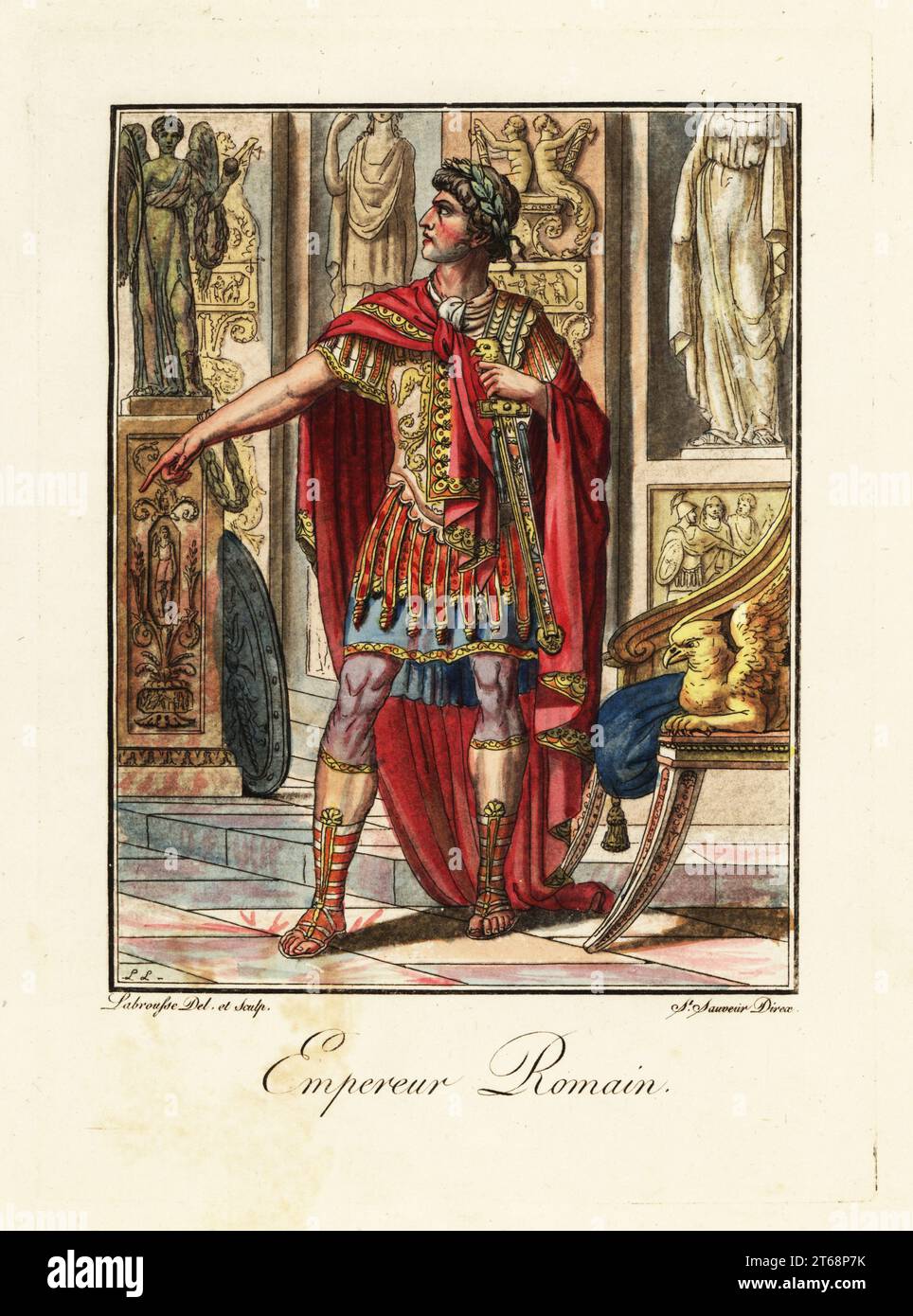 Emperor in military uniform, ancient Rome. Wearing laurel wreath, ornate breastplate, paludamentum cloak, tunic, short trousers or sagulum gregale, and caligae hobnail boots holding a sword. In front of a throne and statues of gods and goddesses. Empereur Romain. Handcoloured copperplate drawn and engraved by L. Labrousse, artist of Bordeaux, under the direction of Jacques Grasset de Saint-Sauveur from his Lantique Rome, ou description historique et pittoresque, Ancient Rome, or historical and picturesque description, Chez Deroy, Paris, 1796. Stock Photohttps://www.alamy.com/image-license-details/?v=1https://www.alamy.com/emperor-in-military-uniform-ancient-rome-wearing-laurel-wreath-ornate-breastplate-paludamentum-cloak-tunic-short-trousers-or-sagulum-gregale-and-caligae-hobnail-boots-holding-a-sword-in-front-of-a-throne-and-statues-of-gods-and-goddesses-empereur-romain-handcoloured-copperplate-drawn-and-engraved-by-l-labrousse-artist-of-bordeaux-under-the-direction-of-jacques-grasset-de-saint-sauveur-from-his-lantique-rome-ou-description-historique-et-pittoresque-ancient-rome-or-historical-and-picturesque-description-chez-deroy-paris-1796-image571823159.html
Emperor in military uniform, ancient Rome. Wearing laurel wreath, ornate breastplate, paludamentum cloak, tunic, short trousers or sagulum gregale, and caligae hobnail boots holding a sword. In front of a throne and statues of gods and goddesses. Empereur Romain. Handcoloured copperplate drawn and engraved by L. Labrousse, artist of Bordeaux, under the direction of Jacques Grasset de Saint-Sauveur from his Lantique Rome, ou description historique et pittoresque, Ancient Rome, or historical and picturesque description, Chez Deroy, Paris, 1796. Stock Photohttps://www.alamy.com/image-license-details/?v=1https://www.alamy.com/emperor-in-military-uniform-ancient-rome-wearing-laurel-wreath-ornate-breastplate-paludamentum-cloak-tunic-short-trousers-or-sagulum-gregale-and-caligae-hobnail-boots-holding-a-sword-in-front-of-a-throne-and-statues-of-gods-and-goddesses-empereur-romain-handcoloured-copperplate-drawn-and-engraved-by-l-labrousse-artist-of-bordeaux-under-the-direction-of-jacques-grasset-de-saint-sauveur-from-his-lantique-rome-ou-description-historique-et-pittoresque-ancient-rome-or-historical-and-picturesque-description-chez-deroy-paris-1796-image571823159.htmlRM2T68P7K–Emperor in military uniform, ancient Rome. Wearing laurel wreath, ornate breastplate, paludamentum cloak, tunic, short trousers or sagulum gregale, and caligae hobnail boots holding a sword. In front of a throne and statues of gods and goddesses. Empereur Romain. Handcoloured copperplate drawn and engraved by L. Labrousse, artist of Bordeaux, under the direction of Jacques Grasset de Saint-Sauveur from his Lantique Rome, ou description historique et pittoresque, Ancient Rome, or historical and picturesque description, Chez Deroy, Paris, 1796.
 Fashion and Elegance: French Fashions of the 1720s. During the early 18th century small series of costume plates reported on the fashion of the day. Women wore the loose-fitting robe volante, also called a ‘sack-backed gown’ in English, over which women sometimes added a short, hooded cloak known as a bagnolette. Men dressed in long coats over a waistcoat and knee-breeches. Pig-tail wigs were adorned with large bows, and tricorne hats were tucked under the arm rather than worn on the head. The two large prints from around 1760 show Parisians out for a stroll. Curiously, the women wear wide pan Stock Photohttps://www.alamy.com/image-license-details/?v=1https://www.alamy.com/fashion-and-elegance-french-fashions-of-the-1720s-during-the-early-18th-century-small-series-of-costume-plates-reported-on-the-fashion-of-the-day-women-wore-the-loose-fitting-robe-volante-also-called-a-sack-backed-gown-in-english-over-which-women-sometimes-added-a-short-hooded-cloak-known-as-a-bagnolette-men-dressed-in-long-coats-over-a-waistcoat-and-knee-breeches-pig-tail-wigs-were-adorned-with-large-bows-and-tricorne-hats-were-tucked-under-the-arm-rather-than-worn-on-the-head-the-two-large-prints-from-around-1760-show-parisians-out-for-a-stroll-curiously-the-women-wear-wide-pan-image430249638.html
Fashion and Elegance: French Fashions of the 1720s. During the early 18th century small series of costume plates reported on the fashion of the day. Women wore the loose-fitting robe volante, also called a ‘sack-backed gown’ in English, over which women sometimes added a short, hooded cloak known as a bagnolette. Men dressed in long coats over a waistcoat and knee-breeches. Pig-tail wigs were adorned with large bows, and tricorne hats were tucked under the arm rather than worn on the head. The two large prints from around 1760 show Parisians out for a stroll. Curiously, the women wear wide pan Stock Photohttps://www.alamy.com/image-license-details/?v=1https://www.alamy.com/fashion-and-elegance-french-fashions-of-the-1720s-during-the-early-18th-century-small-series-of-costume-plates-reported-on-the-fashion-of-the-day-women-wore-the-loose-fitting-robe-volante-also-called-a-sack-backed-gown-in-english-over-which-women-sometimes-added-a-short-hooded-cloak-known-as-a-bagnolette-men-dressed-in-long-coats-over-a-waistcoat-and-knee-breeches-pig-tail-wigs-were-adorned-with-large-bows-and-tricorne-hats-were-tucked-under-the-arm-rather-than-worn-on-the-head-the-two-large-prints-from-around-1760-show-parisians-out-for-a-stroll-curiously-the-women-wear-wide-pan-image430249638.htmlRM2FYYFPE–Fashion and Elegance: French Fashions of the 1720s. During the early 18th century small series of costume plates reported on the fashion of the day. Women wore the loose-fitting robe volante, also called a ‘sack-backed gown’ in English, over which women sometimes added a short, hooded cloak known as a bagnolette. Men dressed in long coats over a waistcoat and knee-breeches. Pig-tail wigs were adorned with large bows, and tricorne hats were tucked under the arm rather than worn on the head. The two large prints from around 1760 show Parisians out for a stroll. Curiously, the women wear wide pan
 Roman tribune in military uniform, ancient Rome. Wearing a lorica musculata or breastplate, paludamentum cloak, tunic, short trousers or sagulum gregale, and caligae hobnail sandals. Seated on a stool in a military tent with fasces, signum, shield. Tribun Militaire chez les Romains. Handcoloured copperplate drawn and engraved by L. Labrousse, artist of Bordeaux, under the direction of Jacques Grasset de Saint-Sauveur from his Lantique Rome, ou description historique et pittoresque, Ancient Rome, or historical and picturesque description, Chez Deroy, Paris, 1796. Stock Photohttps://www.alamy.com/image-license-details/?v=1https://www.alamy.com/roman-tribune-in-military-uniform-ancient-rome-wearing-a-lorica-musculata-or-breastplate-paludamentum-cloak-tunic-short-trousers-or-sagulum-gregale-and-caligae-hobnail-sandals-seated-on-a-stool-in-a-military-tent-with-fasces-signum-shield-tribun-militaire-chez-les-romains-handcoloured-copperplate-drawn-and-engraved-by-l-labrousse-artist-of-bordeaux-under-the-direction-of-jacques-grasset-de-saint-sauveur-from-his-lantique-rome-ou-description-historique-et-pittoresque-ancient-rome-or-historical-and-picturesque-description-chez-deroy-paris-1796-image571810395.html
Roman tribune in military uniform, ancient Rome. Wearing a lorica musculata or breastplate, paludamentum cloak, tunic, short trousers or sagulum gregale, and caligae hobnail sandals. Seated on a stool in a military tent with fasces, signum, shield. Tribun Militaire chez les Romains. Handcoloured copperplate drawn and engraved by L. Labrousse, artist of Bordeaux, under the direction of Jacques Grasset de Saint-Sauveur from his Lantique Rome, ou description historique et pittoresque, Ancient Rome, or historical and picturesque description, Chez Deroy, Paris, 1796. Stock Photohttps://www.alamy.com/image-license-details/?v=1https://www.alamy.com/roman-tribune-in-military-uniform-ancient-rome-wearing-a-lorica-musculata-or-breastplate-paludamentum-cloak-tunic-short-trousers-or-sagulum-gregale-and-caligae-hobnail-sandals-seated-on-a-stool-in-a-military-tent-with-fasces-signum-shield-tribun-militaire-chez-les-romains-handcoloured-copperplate-drawn-and-engraved-by-l-labrousse-artist-of-bordeaux-under-the-direction-of-jacques-grasset-de-saint-sauveur-from-his-lantique-rome-ou-description-historique-et-pittoresque-ancient-rome-or-historical-and-picturesque-description-chez-deroy-paris-1796-image571810395.htmlRM2T685YR–Roman tribune in military uniform, ancient Rome. Wearing a lorica musculata or breastplate, paludamentum cloak, tunic, short trousers or sagulum gregale, and caligae hobnail sandals. Seated on a stool in a military tent with fasces, signum, shield. Tribun Militaire chez les Romains. Handcoloured copperplate drawn and engraved by L. Labrousse, artist of Bordeaux, under the direction of Jacques Grasset de Saint-Sauveur from his Lantique Rome, ou description historique et pittoresque, Ancient Rome, or historical and picturesque description, Chez Deroy, Paris, 1796.
 Fashion and Elegance: French Fashions of the 1720s. During the early 18th century small series of costume plates reported on the fashion of the day. Women wore the loose-fitting robe volante, also called a ‘sack-backed gown’ in English, over which women sometimes added a short, hooded cloak known as a bagnolette. Men dressed in long coats over a waistcoat and knee-breeches. Pig-tail wigs were adorned with large bows, and tricorne hats were tucked under the arm rather than worn on the head. The two large prints from around 1760 show Parisians out for a stroll. Curiously, the women wear wide pan Stock Photohttps://www.alamy.com/image-license-details/?v=1https://www.alamy.com/fashion-and-elegance-french-fashions-of-the-1720s-during-the-early-18th-century-small-series-of-costume-plates-reported-on-the-fashion-of-the-day-women-wore-the-loose-fitting-robe-volante-also-called-a-sack-backed-gown-in-english-over-which-women-sometimes-added-a-short-hooded-cloak-known-as-a-bagnolette-men-dressed-in-long-coats-over-a-waistcoat-and-knee-breeches-pig-tail-wigs-were-adorned-with-large-bows-and-tricorne-hats-were-tucked-under-the-arm-rather-than-worn-on-the-head-the-two-large-prints-from-around-1760-show-parisians-out-for-a-stroll-curiously-the-women-wear-wide-pan-image430252453.html
Fashion and Elegance: French Fashions of the 1720s. During the early 18th century small series of costume plates reported on the fashion of the day. Women wore the loose-fitting robe volante, also called a ‘sack-backed gown’ in English, over which women sometimes added a short, hooded cloak known as a bagnolette. Men dressed in long coats over a waistcoat and knee-breeches. Pig-tail wigs were adorned with large bows, and tricorne hats were tucked under the arm rather than worn on the head. The two large prints from around 1760 show Parisians out for a stroll. Curiously, the women wear wide pan Stock Photohttps://www.alamy.com/image-license-details/?v=1https://www.alamy.com/fashion-and-elegance-french-fashions-of-the-1720s-during-the-early-18th-century-small-series-of-costume-plates-reported-on-the-fashion-of-the-day-women-wore-the-loose-fitting-robe-volante-also-called-a-sack-backed-gown-in-english-over-which-women-sometimes-added-a-short-hooded-cloak-known-as-a-bagnolette-men-dressed-in-long-coats-over-a-waistcoat-and-knee-breeches-pig-tail-wigs-were-adorned-with-large-bows-and-tricorne-hats-were-tucked-under-the-arm-rather-than-worn-on-the-head-the-two-large-prints-from-around-1760-show-parisians-out-for-a-stroll-curiously-the-women-wear-wide-pan-image430252453.htmlRM2FYYKB1–Fashion and Elegance: French Fashions of the 1720s. During the early 18th century small series of costume plates reported on the fashion of the day. Women wore the loose-fitting robe volante, also called a ‘sack-backed gown’ in English, over which women sometimes added a short, hooded cloak known as a bagnolette. Men dressed in long coats over a waistcoat and knee-breeches. Pig-tail wigs were adorned with large bows, and tricorne hats were tucked under the arm rather than worn on the head. The two large prints from around 1760 show Parisians out for a stroll. Curiously, the women wear wide pan
 Catharina van Alexandrie. The sacred stands on a versatile plinth with the curved right leg forwards about Maxentius. She stares straight, keeps a book on the left hand and the lost attribute, the sword in the judge. A wound pearl band rests on her, which falls down in long wavy troubles, each ending in a curl. Over a thin suckled with front and long wide, flared sleeves a short-sleeved robe, which frills, and a round, embroidered neck; It is absorbed under the left arm so that the right shoe point is released. The jacket, a slip of which hangs over the left arm, is held together by a double c Stock Photohttps://www.alamy.com/image-license-details/?v=1https://www.alamy.com/catharina-van-alexandrie-the-sacred-stands-on-a-versatile-plinth-with-the-curved-right-leg-forwards-about-maxentius-she-stares-straight-keeps-a-book-on-the-left-hand-and-the-lost-attribute-the-sword-in-the-judge-a-wound-pearl-band-rests-on-her-which-falls-down-in-long-wavy-troubles-each-ending-in-a-curl-over-a-thin-suckled-with-front-and-long-wide-flared-sleeves-a-short-sleeved-robe-which-frills-and-a-round-embroidered-neck-it-is-absorbed-under-the-left-arm-so-that-the-right-shoe-point-is-released-the-jacket-a-slip-of-which-hangs-over-the-left-arm-is-held-together-by-a-double-c-image432723668.html
Catharina van Alexandrie. The sacred stands on a versatile plinth with the curved right leg forwards about Maxentius. She stares straight, keeps a book on the left hand and the lost attribute, the sword in the judge. A wound pearl band rests on her, which falls down in long wavy troubles, each ending in a curl. Over a thin suckled with front and long wide, flared sleeves a short-sleeved robe, which frills, and a round, embroidered neck; It is absorbed under the left arm so that the right shoe point is released. The jacket, a slip of which hangs over the left arm, is held together by a double c Stock Photohttps://www.alamy.com/image-license-details/?v=1https://www.alamy.com/catharina-van-alexandrie-the-sacred-stands-on-a-versatile-plinth-with-the-curved-right-leg-forwards-about-maxentius-she-stares-straight-keeps-a-book-on-the-left-hand-and-the-lost-attribute-the-sword-in-the-judge-a-wound-pearl-band-rests-on-her-which-falls-down-in-long-wavy-troubles-each-ending-in-a-curl-over-a-thin-suckled-with-front-and-long-wide-flared-sleeves-a-short-sleeved-robe-which-frills-and-a-round-embroidered-neck-it-is-absorbed-under-the-left-arm-so-that-the-right-shoe-point-is-released-the-jacket-a-slip-of-which-hangs-over-the-left-arm-is-held-together-by-a-double-c-image432723668.htmlRM2G407CM–Catharina van Alexandrie. The sacred stands on a versatile plinth with the curved right leg forwards about Maxentius. She stares straight, keeps a book on the left hand and the lost attribute, the sword in the judge. A wound pearl band rests on her, which falls down in long wavy troubles, each ending in a curl. Over a thin suckled with front and long wide, flared sleeves a short-sleeved robe, which frills, and a round, embroidered neck; It is absorbed under the left arm so that the right shoe point is released. The jacket, a slip of which hangs over the left arm, is held together by a double c
 Roman archer sagittarius and spearman hastatus, ancient Rome. Bowman in galea helmet, lorica squamata or scale armour breastplate, tunic, sagulum gregale or short trousers, caligae hobnail sandals, armed with bow and arrow. Lancer armed with oval shield and spear. In the background a triumphal parade. Archer et Hastat Romains. Handcoloured copperplate drawn and engraved by L. Labrousse, artist of Bordeaux, under the direction of Jacques Grasset de Saint-Sauveur from his Lantique Rome, ou description historique et pittoresque, Ancient Rome, or historical and picturesque description, Chez Deroy, Stock Photohttps://www.alamy.com/image-license-details/?v=1https://www.alamy.com/roman-archer-sagittarius-and-spearman-hastatus-ancient-rome-bowman-in-galea-helmet-lorica-squamata-or-scale-armour-breastplate-tunic-sagulum-gregale-or-short-trousers-caligae-hobnail-sandals-armed-with-bow-and-arrow-lancer-armed-with-oval-shield-and-spear-in-the-background-a-triumphal-parade-archer-et-hastat-romains-handcoloured-copperplate-drawn-and-engraved-by-l-labrousse-artist-of-bordeaux-under-the-direction-of-jacques-grasset-de-saint-sauveur-from-his-lantique-rome-ou-description-historique-et-pittoresque-ancient-rome-or-historical-and-picturesque-description-chez-deroy-image571812412.html
Roman archer sagittarius and spearman hastatus, ancient Rome. Bowman in galea helmet, lorica squamata or scale armour breastplate, tunic, sagulum gregale or short trousers, caligae hobnail sandals, armed with bow and arrow. Lancer armed with oval shield and spear. In the background a triumphal parade. Archer et Hastat Romains. Handcoloured copperplate drawn and engraved by L. Labrousse, artist of Bordeaux, under the direction of Jacques Grasset de Saint-Sauveur from his Lantique Rome, ou description historique et pittoresque, Ancient Rome, or historical and picturesque description, Chez Deroy, Stock Photohttps://www.alamy.com/image-license-details/?v=1https://www.alamy.com/roman-archer-sagittarius-and-spearman-hastatus-ancient-rome-bowman-in-galea-helmet-lorica-squamata-or-scale-armour-breastplate-tunic-sagulum-gregale-or-short-trousers-caligae-hobnail-sandals-armed-with-bow-and-arrow-lancer-armed-with-oval-shield-and-spear-in-the-background-a-triumphal-parade-archer-et-hastat-romains-handcoloured-copperplate-drawn-and-engraved-by-l-labrousse-artist-of-bordeaux-under-the-direction-of-jacques-grasset-de-saint-sauveur-from-his-lantique-rome-ou-description-historique-et-pittoresque-ancient-rome-or-historical-and-picturesque-description-chez-deroy-image571812412.htmlRM2T688FT–Roman archer sagittarius and spearman hastatus, ancient Rome. Bowman in galea helmet, lorica squamata or scale armour breastplate, tunic, sagulum gregale or short trousers, caligae hobnail sandals, armed with bow and arrow. Lancer armed with oval shield and spear. In the background a triumphal parade. Archer et Hastat Romains. Handcoloured copperplate drawn and engraved by L. Labrousse, artist of Bordeaux, under the direction of Jacques Grasset de Saint-Sauveur from his Lantique Rome, ou description historique et pittoresque, Ancient Rome, or historical and picturesque description, Chez Deroy,
 Boxers fighting in a ring, ancient Rome. The pugilists wear cesti or battle gloves and short tunics. Gladiateurs: Pugilats chez les Romains. Handcoloured copperplate drawn and engraved by L. Labrousse, artist of Bordeaux, under the direction of Jacques Grasset de Saint-Sauveur from his Lantique Rome, ou description historique et pittoresque, Ancient Rome, or historical and picturesque description, Chez Deroy, Paris, 1796. Stock Photohttps://www.alamy.com/image-license-details/?v=1https://www.alamy.com/boxers-fighting-in-a-ring-ancient-rome-the-pugilists-wear-cesti-or-battle-gloves-and-short-tunics-gladiateurs-pugilats-chez-les-romains-handcoloured-copperplate-drawn-and-engraved-by-l-labrousse-artist-of-bordeaux-under-the-direction-of-jacques-grasset-de-saint-sauveur-from-his-lantique-rome-ou-description-historique-et-pittoresque-ancient-rome-or-historical-and-picturesque-description-chez-deroy-paris-1796-image571826342.html
Boxers fighting in a ring, ancient Rome. The pugilists wear cesti or battle gloves and short tunics. Gladiateurs: Pugilats chez les Romains. Handcoloured copperplate drawn and engraved by L. Labrousse, artist of Bordeaux, under the direction of Jacques Grasset de Saint-Sauveur from his Lantique Rome, ou description historique et pittoresque, Ancient Rome, or historical and picturesque description, Chez Deroy, Paris, 1796. Stock Photohttps://www.alamy.com/image-license-details/?v=1https://www.alamy.com/boxers-fighting-in-a-ring-ancient-rome-the-pugilists-wear-cesti-or-battle-gloves-and-short-tunics-gladiateurs-pugilats-chez-les-romains-handcoloured-copperplate-drawn-and-engraved-by-l-labrousse-artist-of-bordeaux-under-the-direction-of-jacques-grasset-de-saint-sauveur-from-his-lantique-rome-ou-description-historique-et-pittoresque-ancient-rome-or-historical-and-picturesque-description-chez-deroy-paris-1796-image571826342.htmlRM2T68X9A–Boxers fighting in a ring, ancient Rome. The pugilists wear cesti or battle gloves and short tunics. Gladiateurs: Pugilats chez les Romains. Handcoloured copperplate drawn and engraved by L. Labrousse, artist of Bordeaux, under the direction of Jacques Grasset de Saint-Sauveur from his Lantique Rome, ou description historique et pittoresque, Ancient Rome, or historical and picturesque description, Chez Deroy, Paris, 1796.
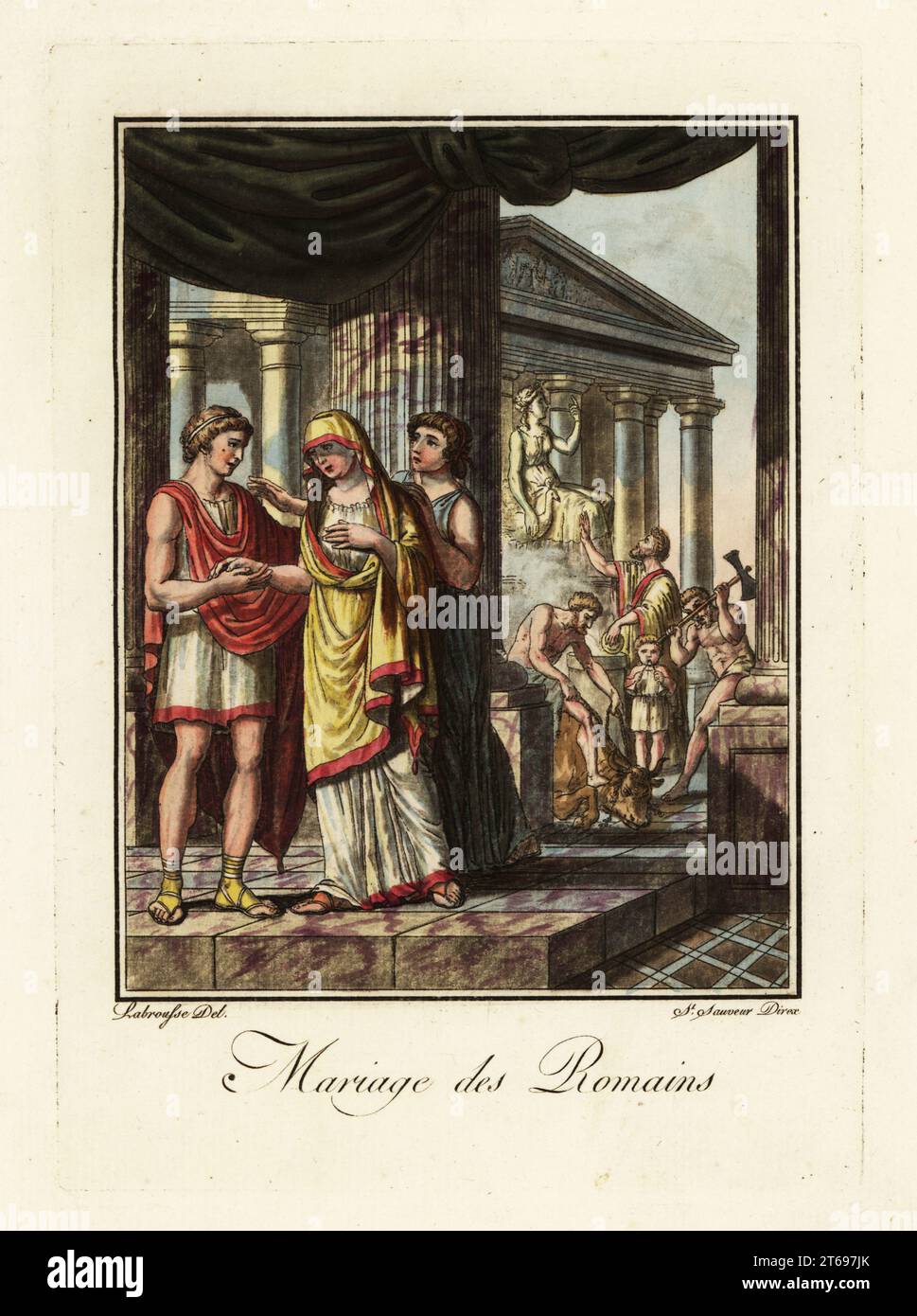 A wedding ceremony in ancient Rome. The bride wears a yellow flammeum bridal veil, the groom a short tunic, cape and yellow sandals. A flamen priest burns offerings at an altar to Juno, and a victimarius sacrifices a bull. Mariage des Romains. Handcoloured copperplate drawn and engraved by L. Labrousse, artist of Bordeaux, under the direction of Jacques Grasset de Saint-Sauveur from his Lantique Rome, ou description historique et pittoresque, Ancient Rome, or historical and picturesque description, Chez Deroy, Paris, 1796. Stock Photohttps://www.alamy.com/image-license-details/?v=1https://www.alamy.com/a-wedding-ceremony-in-ancient-rome-the-bride-wears-a-yellow-flammeum-bridal-veil-the-groom-a-short-tunic-cape-and-yellow-sandals-a-flamen-priest-burns-offerings-at-an-altar-to-juno-and-a-victimarius-sacrifices-a-bull-mariage-des-romains-handcoloured-copperplate-drawn-and-engraved-by-l-labrousse-artist-of-bordeaux-under-the-direction-of-jacques-grasset-de-saint-sauveur-from-his-lantique-rome-ou-description-historique-et-pittoresque-ancient-rome-or-historical-and-picturesque-description-chez-deroy-paris-1796-image571833659.html
A wedding ceremony in ancient Rome. The bride wears a yellow flammeum bridal veil, the groom a short tunic, cape and yellow sandals. A flamen priest burns offerings at an altar to Juno, and a victimarius sacrifices a bull. Mariage des Romains. Handcoloured copperplate drawn and engraved by L. Labrousse, artist of Bordeaux, under the direction of Jacques Grasset de Saint-Sauveur from his Lantique Rome, ou description historique et pittoresque, Ancient Rome, or historical and picturesque description, Chez Deroy, Paris, 1796. Stock Photohttps://www.alamy.com/image-license-details/?v=1https://www.alamy.com/a-wedding-ceremony-in-ancient-rome-the-bride-wears-a-yellow-flammeum-bridal-veil-the-groom-a-short-tunic-cape-and-yellow-sandals-a-flamen-priest-burns-offerings-at-an-altar-to-juno-and-a-victimarius-sacrifices-a-bull-mariage-des-romains-handcoloured-copperplate-drawn-and-engraved-by-l-labrousse-artist-of-bordeaux-under-the-direction-of-jacques-grasset-de-saint-sauveur-from-his-lantique-rome-ou-description-historique-et-pittoresque-ancient-rome-or-historical-and-picturesque-description-chez-deroy-paris-1796-image571833659.htmlRM2T697JK–A wedding ceremony in ancient Rome. The bride wears a yellow flammeum bridal veil, the groom a short tunic, cape and yellow sandals. A flamen priest burns offerings at an altar to Juno, and a victimarius sacrifices a bull. Mariage des Romains. Handcoloured copperplate drawn and engraved by L. Labrousse, artist of Bordeaux, under the direction of Jacques Grasset de Saint-Sauveur from his Lantique Rome, ou description historique et pittoresque, Ancient Rome, or historical and picturesque description, Chez Deroy, Paris, 1796.
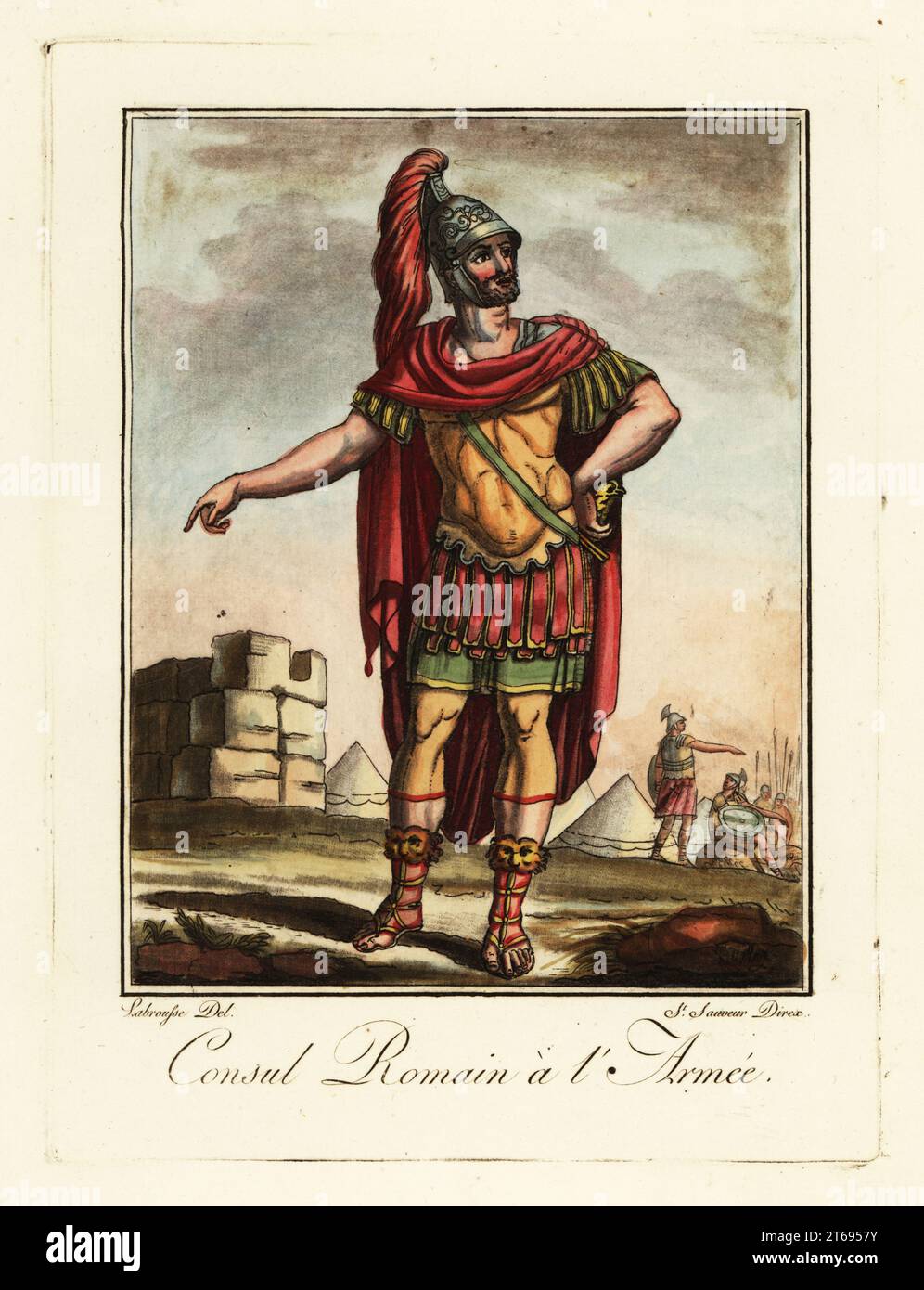 Roman consul in military uniform, ancient Rome. When in command of a Roman legion, wearing galea or helmet, lorica musculata or breastplate, paludamentum cloak, tunic, short trousers or sagulum gregale, and caligae hobnail sandals with lion heads. Consul Romain a l'Armee. Handcoloured copperplate drawn and engraved by L. Labrousse, artist of Bordeaux, under the direction of Jacques Grasset de Saint-Sauveur from his Lantique Rome, ou description historique et pittoresque, Ancient Rome, or historical and picturesque description, Chez Deroy, Paris, 1796. Stock Photohttps://www.alamy.com/image-license-details/?v=1https://www.alamy.com/roman-consul-in-military-uniform-ancient-rome-when-in-command-of-a-roman-legion-wearing-galea-or-helmet-lorica-musculata-or-breastplate-paludamentum-cloak-tunic-short-trousers-or-sagulum-gregale-and-caligae-hobnail-sandals-with-lion-heads-consul-romain-a-larmee-handcoloured-copperplate-drawn-and-engraved-by-l-labrousse-artist-of-bordeaux-under-the-direction-of-jacques-grasset-de-saint-sauveur-from-his-lantique-rome-ou-description-historique-et-pittoresque-ancient-rome-or-historical-and-picturesque-description-chez-deroy-paris-1796-image571831791.html
Roman consul in military uniform, ancient Rome. When in command of a Roman legion, wearing galea or helmet, lorica musculata or breastplate, paludamentum cloak, tunic, short trousers or sagulum gregale, and caligae hobnail sandals with lion heads. Consul Romain a l'Armee. Handcoloured copperplate drawn and engraved by L. Labrousse, artist of Bordeaux, under the direction of Jacques Grasset de Saint-Sauveur from his Lantique Rome, ou description historique et pittoresque, Ancient Rome, or historical and picturesque description, Chez Deroy, Paris, 1796. Stock Photohttps://www.alamy.com/image-license-details/?v=1https://www.alamy.com/roman-consul-in-military-uniform-ancient-rome-when-in-command-of-a-roman-legion-wearing-galea-or-helmet-lorica-musculata-or-breastplate-paludamentum-cloak-tunic-short-trousers-or-sagulum-gregale-and-caligae-hobnail-sandals-with-lion-heads-consul-romain-a-larmee-handcoloured-copperplate-drawn-and-engraved-by-l-labrousse-artist-of-bordeaux-under-the-direction-of-jacques-grasset-de-saint-sauveur-from-his-lantique-rome-ou-description-historique-et-pittoresque-ancient-rome-or-historical-and-picturesque-description-chez-deroy-paris-1796-image571831791.htmlRM2T6957Y–Roman consul in military uniform, ancient Rome. When in command of a Roman legion, wearing galea or helmet, lorica musculata or breastplate, paludamentum cloak, tunic, short trousers or sagulum gregale, and caligae hobnail sandals with lion heads. Consul Romain a l'Armee. Handcoloured copperplate drawn and engraved by L. Labrousse, artist of Bordeaux, under the direction of Jacques Grasset de Saint-Sauveur from his Lantique Rome, ou description historique et pittoresque, Ancient Rome, or historical and picturesque description, Chez Deroy, Paris, 1796.